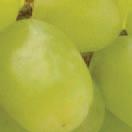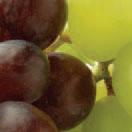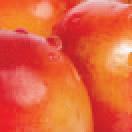






Quick commerce is booming in India. What opportunities does it present for fresh produce marketers?


Rather than just taking share from other channels, quick commerce players are creating a space of their own by servicing latent demand



Quick commerce is booming in India. Consumers across the major cities have embraced the convenience of ultra-fast deliveries – from grocery items to everyday essentials. Fresh produce is a new frontier for the leading players such as Blinkit, Swiggy Instamart and Zepto. As our keynote interview with QuikRelations’ Sachin Khurana details (see p26-30), q-commerce has already begun to reshape shopping habits, shifting fresh produce purchases from weekly bulk purchases to on-demand buying in smaller packages. Indeed, industry sources indicate these platforms are selling far more fresh produce than traditional supermarket chains. Rather than just taking share from other channels, however, the q-commerce players are creating a space of their own by servicing latent demand that was previously never served. Much of this owes to their ability to access a segment of consumers seeking premium categories such as berries and avocados. The unique data they have enables them to micro-target products and tailor shopping baskets to personal buying habits – to target even a single consumer in a specific pin code. This is a powerful platform, and one that must excite fresh produce marketers. India has been a notoriously difficult market to crack for premium fresh produce brands, with marketers often struggling to secure the requisite price premium. Could q-commerce hold the key? It appears so, but the sector still has much work to do to develop its premium offering, not least by maintaining quality in last-mile logistics. The good news is that these players have deep pockets, they’re investing it in infrastructure, and they’re willing to learn and partner. We look forward to hearing first-hand from top q-commerce players at Fresh Produce India on 3-4 April (p32-33) about what the future holds, and to nurturing those partnerships A

John Hey, Editor SINCE
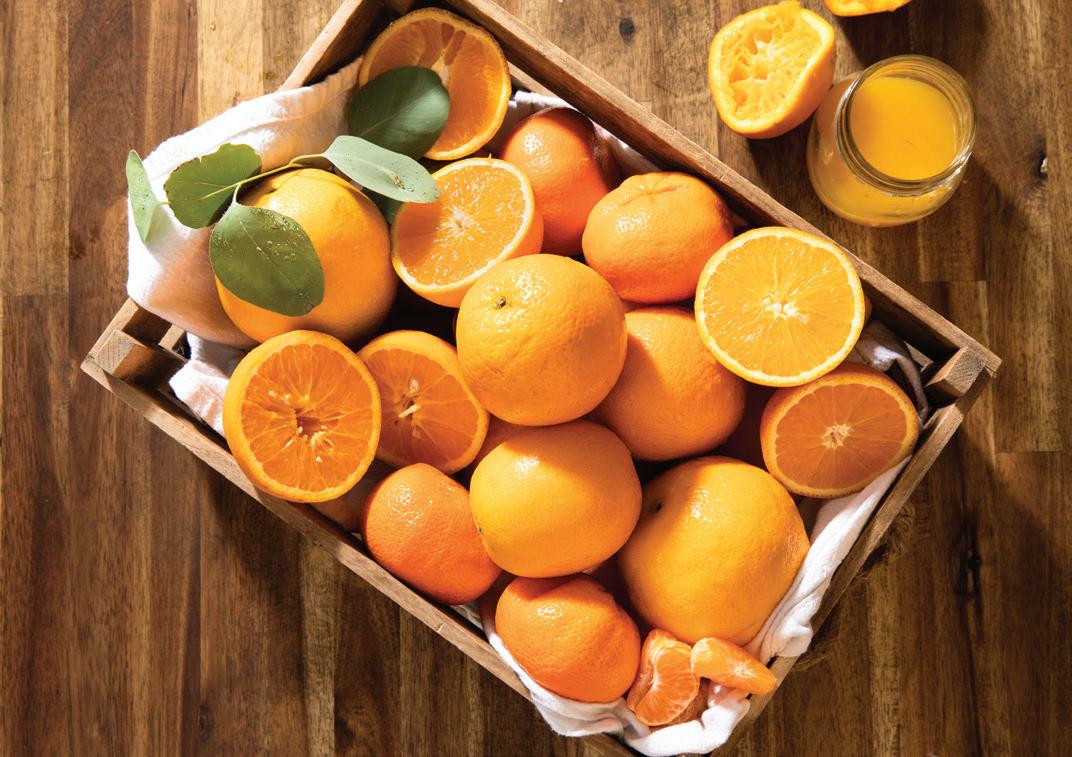



From juicy nectarines and oranges to sweet grapes and smooth buttery avocados, Australian fruit and fresh produce brings you the best of nature – sustainably grown, naturally delicious, and packed with nutrients.
Discover the wide range of tastes, textures, and flavours that Australia has to o er!
Get it Fresh. Get it Now.
For trade opportunities, contact india@austrade.gov.au




Rather than just taking share from other channels, quick commerce players are creating a space of their own by servicing latent demand



Quick commerce is booming in India. Consumers across the major cities have embraced the convenience of ultra-fast deliveries – from grocery items to everyday essentials. Fresh produce is a new frontier for the leading players such as Blinkit, Swiggy Instamart and Zepto. As our keynote interview with QuikRelations’ Sachin Khurana details (see p26-30), q-commerce has already begun to reshape shopping habits, shifting fresh produce purchases from weekly bulk purchases to on-demand buying in smaller packages. Indeed, industry sources indicate these platforms are selling far more fresh produce than traditional supermarket chains. Rather than just taking share from other channels, however, the q-commerce players are creating a space of their own by servicing latent demand that was previously never served. Much of this owes to their ability to access a segment of consumers seeking premium categories such as berries and avocados. The unique data they have enables them to micro-target products and tailor shopping baskets to personal buying habits – to target even a single consumer in a specific pin code. This is a powerful platform, and one that must excite fresh produce marketers. India has been a notoriously difficult market to crack for premium fresh produce brands, with marketers often struggling to secure the requisite price premium. Could q-commerce hold the key? It appears so, but the sector still has much work to do to develop its premium offering, not least by maintaining quality in last-mile logistics. The good news is that these players have deep pockets, they’re investing it in infrastructure, and they’re willing to learn and partner. We look forward to hearing first-hand from top q-commerce players at Fresh Produce India on 3-4 April (p32-33) about what the future holds, and to nurturing those partnerships A

John Hey, Editor SINCE
fruitnet.com/freshproducevietnam Fresh Produce Vietnam, the brand-new international event for Vietnam's fresh and vegetable business, tales place on 13-14 May in HCMC. View the agenda online.
instagram.com/fruitnet
Follow Fruitnet's Instagram page for regular photos and updates from the Fruitnet team.

fruitnet.com/asiafruit Asiafruit's news website provides regular updates on all the top stories from Asia's fresh fruit and vegetable business.

asiafruitchina.net
Visit Asiafruit's Chinese-language portal for all the latest news in Mandarin. Sign up to our newsletter, Asiafruit News and find us on WeChat. Our WeChat ID is asiafruit.
Expand your network of professional contacts and join the fresh produce conversation by visiting the Asiafruit LinkedIn account. LinkedIn

linkedin.com/showcase/asiafruitmagazine

x.com/asiafruit Keep up to date with news, opinions and developments from around the Asia's fresh produce trade by following our dedicated X account. X
desktop.asiafruitmagazine.com
Download the new Asiafruit app onto your smartphone or tablet from the App Store or Google Play. Stay informed on the latest fresh produce industry developments, and enjoy our magazines in new user-friendly digital formats.
https://bit.ly/3eHjlS0
Download Fruitnet's podcast series hosted by managing director Chris White in London. The Fruitbox podcast features conversations and interviews with leading industry experts.
Year-Round Vertical Integration


Premium Avocado Origins & Diversified Supply
35+ Years of Proven Market Expertise

editor John Hey
+61 3 9040 1602 john@fruitnet.com
digital editor
Liam O'Callaghan +61 3 9040 1605 liam@fruitnet.com
staff journalist
Bree Caggiati
+61 3 9040 1606 bree@fruitnet.com
china editor
Yuxin Yang +61 3 9040 1604 yuxin@fruitnet.com
DESIGN & PRODUCTION
design manager
Simon Spreckley
+44 20 7501 3713 simon@fruitnet.com
senior designer
Qiong Wu
+61 3 9040 1603 wobo@fruitnet.com
senior designer Mai Luong
+44 20 7501 3713 mai@fruitnet.com
graphic designer
Asma Kapoor
+44 20 7501 3713 asma@fruitnet.com
EVENTS & MARKETING
head of events and marketing
Laura Martín Nuñez
+44 20 7501 3720 laura@fruitnet.com
events executive Maria Santamaria Peláez +44 20 7501 3719 mariasan@fruitnet.com
ADMINISTRATION
finance director
Elvan Gul +44 20 7501 3711 elvan@fruitnet.com
accounts receivable
Tracey Haines
+44 20 7501 3717 tracey@fruitnet.com
finance manager
Günal Yildiz
+44 20 7501 3714 gunal@fruitnet.com
subscriptions +44 20 7501 0311 subscriptions@fruitnet.com
asia pacific
Kate Riches
+61 3 9040 1601 kate@fruitnet.com
europe & middle east
Artur Wiselka
+44 20 7501 0309 artur@fruitnet.com
greater china, thailand & philippines
Jennifer Zhang +86 21 6136 6010 jennifer@fruitnet.com
uk, ireland, belgium, greece, turkey & south-east europe
Giorgio Mancino
+44 20 7501 3716 giorgio@fruitnet.com
us & canada
Jeff Long +1 805 966 0815 jeff@fruitnet.com
south africa
Fred Meintjes +27 28 754 1418 fredmeintjes@fruitnet.com
italy
Giordano Giardi +39 059 786 3839 giordano@fruitnet.com
commercial director
Ulrike Niggemann +49 211 99 10 425 ulrike@fruitnet.com
managing director
Chris White +44 20 7501 3710 chris@fruitnet.com

Chris White fruitnet
As the founding editor of Asiafruit Magazine, Fruitnet's managing director reflects on the past 30 years as the publication celebrates three decades in print, and much more. asiafruit 30–p22-23

Desh Ramnath hortiroad2india Desh unpacks some of the thinking behind the sustainable, high-value food production projects HortiRoad2India will present at this year's Fresh Produce India. india–p46

Yemee Fernandes
four pillars trading
Yemee provides key insights for businesses targeting Indian consumers, including an Australian macadamias case study, which has seen recent success in the market.
india–p44

Fred Meintjes fruitnet
South Africa correspondent
Fred has prepared Fresh Focus South African Table Grapes 2025, Asiafruit's annual special profiling the industry and its advances in Asia.
rsa table grapes–p55





South-East Asia to increase exports in a bid to meet China’s growing demand for the “king of fruits”, amid increased border control due to contamination concerns late last year.
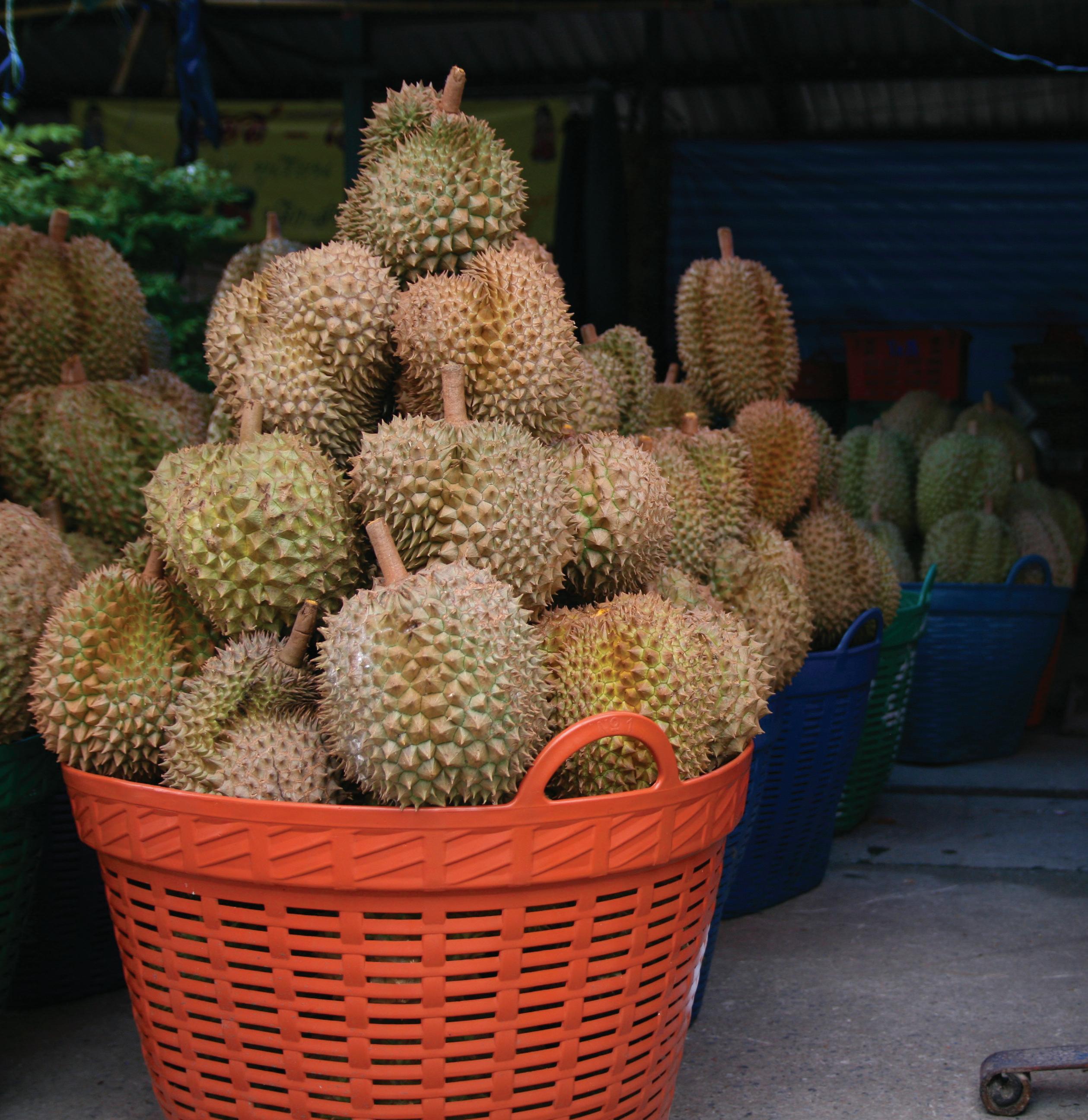
by Bree Caggiati
ABOVE—Auramine O residue was detected in a shipment of Thai durian OPPOSITE—China’s high demand for durian shows no signs of slowing down
The year is already off to an eventful start for China’s durian trade. Following an unparalleled year in 2024 which saw, according to customs data, China import a record 1.56mn tonnes of durian at an all-time record value of US$6.99bn, competition for the world’s largest durian market has intensified.
In recent years, Thailand has lost its dominant position in the race to supply this growing demand as its neighbouring South-East Asian countries have lobbied for market access. Despite the increase in suppliers, China’s market still has plenty of growth potential, according to BMI Country Risk and Industry Research shared by Xinhua
“We expect growth to continue in the medium to long term given the relatively low maturity of the market and the increasing popularity of the fruit,” the forecaster says.
It sees continued growth for suppliers too, particularly Malaysia
and Vietnam.
“We expect Malaysia to become an increasingly important exporter of fresh durian to China thanks to the agreement (last year),” BMI says.
Meanwhile Vietnam has plans to boost its exports, according to VNExpress, with a goal of reaching a total export value of US$3.5bn. Durian exports already accounted for nearly half of the country’s total fruit and vegetable export value in 2024.
The Indonesian government has also increased efforts to gain market access with Liferdi Lukman, director of floriculture at the Indonesian Agriculture Ministry’s Horticulture Directorate General telling the Jakarta Post fresh durian would be audited by China’s General Administration of Customs (GACC) in Central Sulawesi “around the end of February 2025 to prepare a fresh durian export protocol”.
Elsewhere, BMI says Laos is showing signs of continued investment into its own durian supply chain.
This rising competition comes
as drought in Thailand has caused a significant drop in production over the last year. The country’s durian industry faces further challenges following the detection of Auramine O in durian shipments to China late last year.
According to reporting from the Bangkok Post, the GACC discovered Auramine O residues in seven containers carrying durian and two containers containing longan from Thailand. The substance, also known as Basic Yellow 2 (BY2), is classified by the WHO as a Group 2B carcinogen and is suspected to have been used to enhance the colour of the fruit to make it appear more yellow.
Following the discovery, the GACC introduced stricter measures requiring durian exporters to supply certification of pre-export screening for the substance. It will also carry out spot checks at entry points by land, sea and air.
The requirements, introduced on 10 January, have caused major disruptions to trade, with hundreds of containers from Thailand and at least 170 tonnes of durian from Vietnam blocked at border checkpoints for lack of testing, according to VietnamNet. The new rules have also led to significant processing delays, with sources reporting China is spot testing up to 50 per cent of its imports.
The situation looks to be improving somewhat with China approving testing facilities in Thailand and reports of shipments successfully clearing checkpoints. Though it is likely to be some time before the new process runs completely smoothly. A




The beginning of February saw the world’s fresh produce trade converge in Berlin for Fruit Logistica. The three-day event brought together more people than ever before, welcoming over 2,600 exhibitors from more than 90 countries. This included record numbers from China, Turkey and Egypt, and notable increases for Spain and Peru solidifying the event’s place as the world’s most international, influential, and innovative fresh produce trade fair.
AMFresh held off strong competition to win the prestigious Fruit Logistica Innovation Award 2025 for its Onix orange. According to the Spanish group, the deep burgundy orange “combines stunning multicolour beauty with a seedless, velvety pulp, rich in antioxidants”. Meanwhile, Israel’s Fermata Technology won the FLIA Technology prize, impressing voters at the event with Croptimus. Croptimus is a SaaS solution tailored for greenhouse vegetable production, utilising advanced AI coupled with computer vision to identify pests and diseases early.
Southern Hemisphere apple production is up, while pear production is down. That’s the headline from Wapa’s latest forecast, which compiles data from Argentina, Australia, Brazil, Chile, New Zealand and South Africa. In New Zealand, apple and pear exports have just topped NZ$1bn for the first time. And in South Africa, exporter Tru-Cape predicts a strong start to its European
campaign after a good harvest. The country has also just shipped its first apples to Thailand under a new access agreement, opening an important new market.
OPPOSITE—Stonefruit has helped to boost Australia’s horticulture exports
LEFT—AMFresh won the Fruit Logistica Innovation Award
BELOW TOP—Agrovision has harvested its first commercial blueberries in China
BELOW BOTTOM—Southern Hemisphere apple production is up
Agrovision has harvested its first commercial crop of blueberries in China, less than a year after it reached a deal to establish a largescale farm in Yunnan province. Fellow berry marketer Driscoll’s has revealed it plans to introduce its premium range Sweetest Batch in new markets like the Middle East, Germany and eventually the UK after successful rollouts in the US and Australia. Hortifrut has obtained Leaf Marque certification for its farms in Morocco


and Peru, something which is expected to increase availability for European markets. And berry breeder Planasa has acquired ABZ Seeds, owner of the F1 seedpropagated, hybrid strawberries.
Zespri’s strong demand combined with its largestever crop (190mn trays) has put the group on track to exceed its global revenue target of NZ$4.5bn this season. And included in that figure are more than 3mn trays of RubyRed kiwifruit, which means the variety will be available for the first time in some markets. In Greece, meanwhile, exporter Zeus Kiwi has reported growing demand in new markets like Brazil.
Two new partnerships could bring new success for the produce trade between India and Australia. Exporters AgroStar and Kay Bee Exports have shipped the firstever commercial trial shipments of premium Indian pomegranates to Australia by sea. And Australia’s macadamia industry has welcomed a revised protocol for exports to India, which has removed the requirement for methyl bromide fumigation. Led by macadamias, almonds, avocados, stonefruit, and citrus, Australia’s horticulture exports grew 8.7 per cent to almost A$3bn in 2023/24, according to new data released by Hort Innovation.
Vietnam’s fruit and vegetable exports are set to be worth more than US$7bn this year, according to a new report, as exporters benefit from better access to China, as well as opportunities in Thailand and the US.

Chinese authorities have rejected the entire cargo from the Saltoro, the Maersk ship stranded in the Pacific for more than 20 days, due to the poor condition of the fruit. The vessel was carrying 1,300 containers of Chilean cherries valued at more than US$120mn. Chile’s cherry industry is set to rack up losses of at least US$1.6bn in the 2024/25 season, according to analysis by consulting firm Colliers. In China, which takes more than 90 per cent of Chile’s cherry output, prices collapsed following record shipment volumes.
A new investigation has found that inefficient logistics cost South Africa’s citrus industry R5.27bn last season, a figure that CGA chair Justin Chadwick


describes as “a debilitating loss of foreign revenue”. John Giles’ exclusive analysis for Fruitnet suggests there is a renewed wave of optimism sweeping across South Africa’s fruit business as the year progresses.
The Southern Hemisphere Association of Fresh Fruit
Exporters has named Nathan Hancock of Citrus Australia as its new president, and Jorge de Souza of Abrafrutas in Brazil as vicepresident. Meanwhile, Michael Simonetta, chief executive of leading Australian fresh produce marketer Perfection Fresh, has announced his retirement set for the end of June. Rod Quin has been appointed his successor. A
OPPOSITE TOP—Zespri has produced more than 3mn trays of RubyRed OPPOSITE BOTTOM—Australian macadamias have secured an improved protocol to India
ABOVE—Maersk ship Saltoro arrived in Nansha 28 days later than planned
BELOW—Michael Simonetta has stepped down as Perfection Fresh CEO

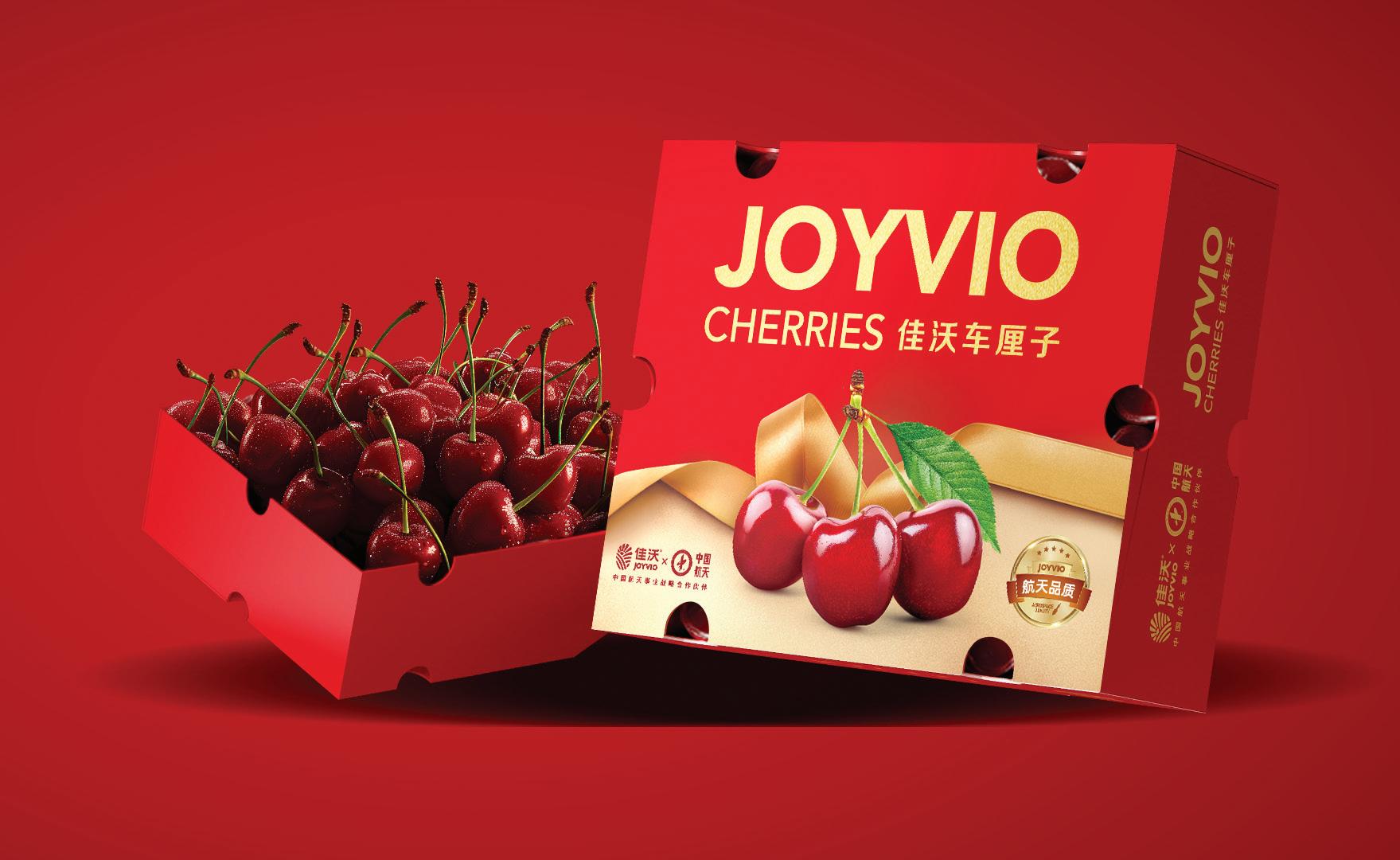
Once considered a “fruit for royals”, cherries have now become a common favourite in many households. With a vibrant red colour, crunchy texture, sweet taste, and high nutritional value, cherries are the ideal gift for loved ones during the Chinese New Year holiday. This season, Chilean cherries experienced a bountiful harvest, with increased supply to the Chinese market driving prices to more accessible levels. For this reason, many consumers were delighted to find that they could enjoy “cherry freedom” ahead of the Spring Festival.
As a leading brand in the premium fruit industry, Joyvio Cherries has carefully observed market demand and consumer trends for the holiday season. Leveraging the gifting tradition of Chinese New Year, Joyvio Cherries proactively promoted its brand. With a more robust and stable supply chain, superior freshness and quality, and innovative marketing campaigns, Joyvio Cherries sparked a nationwide buying frenzy, driving cherry consumption. The brand’s slogan, “Joyvio Cherries – The Perfect Gift for Every Occasion”, was widely embraced, setting a new standard for premium gifting.
From November to February each year, Chilean cherries hit the market in large quantities, coinciding with peak consumption during major holidays such
as New Year’s Day and the Spring Festival. As one of the most established cherry brands in the industry, Joyvio Cherries has consistently maintained a leading position in the market. The first batch of Joyvio Cherries for the 2024 season arrived in China by air as early as November, allowing Chinese consumers to enjoy highquality Chilean cherries sooner than ever.
While early-season cherries often face quality instability, Joyvio Cherries has managed to uphold exceptional standards with large fruit sizes (JJJ and JJJJ), an average sweetness of over 17o Brix, and firmness greater than 70P. This consistent quality – combined with the fruit’s crunchiness, sweetness, and freshness – earned widespread praise upon release.
To meet the high demand for fresh, premium Chilean cherries during Chinese New Year, Joyvio Cherries reached peak import volume in mid-January. With an abundant supply and stable quality, the brand ensured ample stock and steady pricing throughout the holiday season, perfectly catering to consumer demand for high-end cherries during this festive period.
Behind the stability in quality and supply is a mature value chain and innovative international logistics. Joyvio Cherries has established long-term partnerships with premium orchards in Chile, ensuring top-quality cherries from the source. The brand adheres to rigorous standards in harvesting, packaging, transportation, and storage, following its five fresh principles – freshness in cultivation, picking, transportation, packaging, and consumption –ensuring that each cherry retains
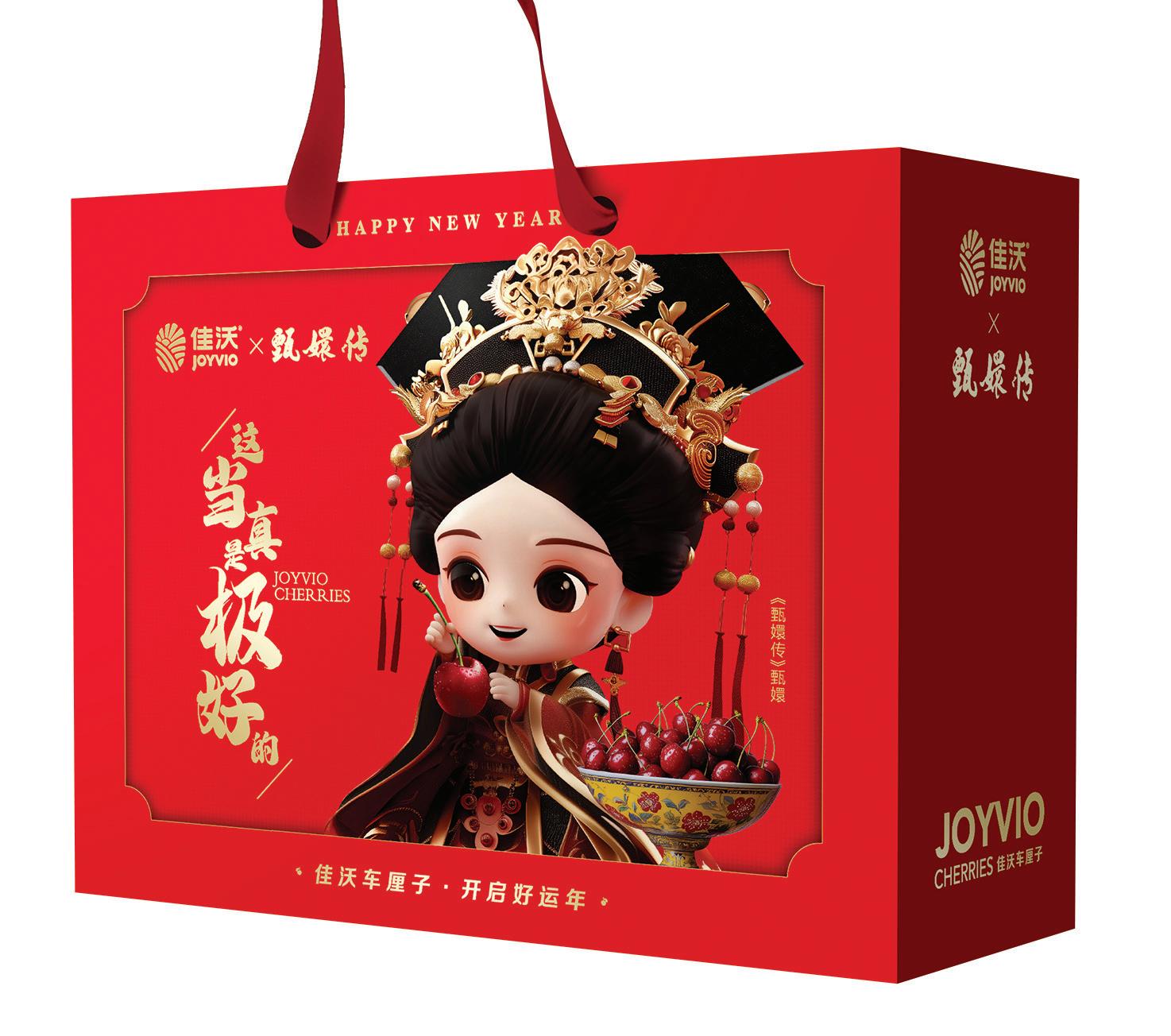

its natural flavour and nutritional value. Enhanced international logistics enabled a multi-port import model in China, drastically reducing the time from Chilean orchards to Chinese dining tables, making “cherry freedom” an easily accessible reality for consumers.
Renowned for its high-quality products, the Joyvio Cherries brand has earned the trust of consumers. After its collaboration with the Chinese women’s volleyball team, the brand became a strategic partner of China’s aerospace industry, leading the freshness revolution with aerospace-level standards.
In the face of a complex Chinese New Year gifting market, Joyvio Cherries creatively integrated traditional Chinese cultural elements with its premium brand image. By highlighting traditional culture and creating a “healthy New Year gifting” scenario, the brand solidified its position as the perfect gift for every occasion.
In 2024, after launching a collaborative gift bag with the Palace Museum’s Mythical Creatures, Joyvio Cherries continued the theme of imperial elegance by partnering with the iconic Chinese drama Empresses in the Palace.
This collaboration blended the refined aesthetics of traditional palace culture with the exceptional quality of Joyvio Cherries. Featuring auspicious red gift bags and the slogan, “This is Truly
Excellent”, the campaign resonated deeply with consumers.
To further elevate the collaboration, Joyvio Cherries introduced a series of themed gift sets, including Empresses in the Palace blind boxes, characterthemed stickers, and festive red envelopes, creating a celebratory atmosphere that delighted consumers and drove sales.
Chinese New Year marks the peak sales season for markets and supermarkets across China. With its festive colours, delightful taste, large size, and elegant packaging, Joyvio Cherries emerged as the top choice for gifting this year.
In major wholesale fruit markets and supermarkets across Guangzhou, Beijing, Tianjin, Zhengzhou, Xiaogan, and Wuhan, Joyvio Cherries hosted Spring Festival marketing events under the theme “Joyvio Cherries: Start the Year with Good
OPPOSITE LEFT—Joyvio Cherries is known for its quality OPPOSITE BOTTOM—Joyvio Cherries collaborated with Chinese drama Empresses in the Palace on Chinese New Year packaging LEFT—Sales are high during the Chinese New Year festive period
BELOW—Joyvio Cherries participated in Chile Week in 2024 with live interviews with key stakeholders
Fortune”. Interactive experiences and tasting sessions significantly boosted sales.
Many shoppers commented that, “Joyvio Cherries are excellent quality. I buy them every year for myself and as gifts for friends”.
While offline sales are booming, online platforms have also seen a surge in demand. On major e-commerce platforms like Pinduoduo, Douyin, Kuaishou, and Tmall, Joyvio Cherries captivated consumers with festive marketing campaigns and influencer-driven live-streaming events.
Notably, Joyvio Cherries made its debut at the 2024 Chile Week, co-hosting a cherry release and livestreaming discussion with the Chilean Embassy in China, the Ministry of Agriculture, InvestChile, Frutas de Chile, and Wumart. These initiatives created a buzz both online and offline, driving strong sales and marking a successful start to the Chinese New Year.
Joyvio Cherries was there to usher in another year of prosperity. With insightful market analysis, a steadfast commitment to freshness, and innovative marketing strategies, Joyvio Cherries has stood out in China’s competitive Chinese New Year gifting market.
As Chilean cherries enter peak import season, Joyvio Cherries continue to bring joy and vitality to consumers during moments of family reunions, visits, and gatherings, offering unparalleled taste and health benefits. The brand remains at the forefront of premium gifting, inspiring consumers to choose Joyvio Cherries as the perfect gift for every occasion.

Acquisition will see Roc Partners invest significantly in the company’s growth with Freshmax maintaining its existing structure and leadership.
by Bree Caggiati
Freshmax Group, a leading player in the Australasian fresh produce industry, has announced its acquisition by Sydney-based alternative investment manager, Roc Partners.
The move comes after Freshmax Group revealed it was seeking a strategic partner in May 2024 to help drive the future growth and development of the business.
Roc Partners plans to invest significantly in the company’s growth and development while maintaining the business’ existing structure and leadership, a Freshmax release explains.
The investment manager specialises in private market investments, with approximately A$9bn capital funds under management across private equity, private credit and real assets.
Roc Partners currently manages A$2.5bn in assets in its food and agriculture portfolio and maintains a dedicated agricultural investment team. The acquisition underscores its commitment to driving growth in the sector.
“This milestone marks the beginning of an exciting new chapter for Freshmax,” says Freshmax Group chief executive, Murray McCallum.
“Roc Partners’ deep expertise and proven track record in food and agriculture make them an ideal partner for the next phase of our journey. Together, we will look to
“We are committed to leveraging our resources and expertise to support Freshmax in achieving its ambitions”

explore new growth opportunities, while continuing to deliver exceptional value to our supplier and customer partners around the world.”
Roc Partners vice president - food and agriculture, Todd Winkley says Freshmax represents “a compelling opportunity” for investment due to its growth and experienced management team.
“We intend to use this strong foundation as a platform for further expansion,” Winkley says.
“We are committed to leveraging our resources and expertise to support Freshmax in achieving its ambitions, nurturing continued
innovation, and strengthening its position in the global fresh produce market.”
Glenn Wallace, Freshmax Group chairman, adds: “The acquisition by Roc Partners ensures a stable and strategic future for Freshmax. Their understanding of the food and agriculture sectors and their commitment to sustainable growth perfectly align with our vision. We look forward to seeing Freshmax thrive under their stewardship”.
The sale process was conducted by Kidder Williams, a leading corporate advisory firm in food and agribusiness transactions. A











Latin American export nation the Official Partner Country for 2025 edition of event, as Asia Fruit Logistica gears up to launch Peru Meet Up this October.
by John Hey

Asia Fruit Logistica has announced that Peru is the Official Partner Country for the 2025 edition of the event, underlining the Latin American nation’s growing role as a leading global fresh produce exporter.
The announcement was made during Fruit Logistica in Berlin. The announcement ceremony took place at the iconic Funkturm (Radio Tower), where over 100 highlevel industry professionals gathered for an evening of networking, business discussions, and a gala dinner.
David Ruetz, senior vice president and advisory board member of Messe Berlin, underscored Peru’s remarkable achievements in the fresh produce sector, which have cemented the country’s growing presence in the international market, particularly in China.
“The strength of Peru’s agricultural sector is a key driver of its growing influence in international markets,” said Ruetz. “The country is committed to expanding its footprint and fostering new international partnerships, especially in Asia.”
Peru’s agricultural sector continues to enjoy
rapid growth, with large-scale initiatives such as the Chancay Port development set to deliver a major boost to trade efficiency. This project, a Sino-Peruvian collaboration, will radically reduce shipping times and costs, further enhancing Peru’s ability to meet the growing demand for fresh produce in Asia.
In conjunction with this announcement, Asia Fruit Logistica revealed plans to launch the Peru Meet Up, taking place on 28-29 October 2025, in Lima. The new event will serve as a vital platform for connecting Latin American fresh produce exporters with key buyers and partners from Asia and
around the world.
This inaugural Meet Up will take place in Peru and it will feature a focused showcase of top Latin American fresh produce with an emphasis on connecting them with Asian buyers.
It will also include a highlevel content programme offering insights from leading industry experts on fresh produce exports and cold chain logistics.
The Peru Meet Up is organised by Asia Fruit Logistica in partnership with Fruit Logistica and Fruitnet, Asia Fruit Logistica’s Knowledge Partner.
Chris White, managing director of Fruitnet, said the launch of the Peru Meet Up comes at the perfect time for the local, regional and international industry.
“Peru has emerged rapidly to become one of the world’s top fresh produce exporters. Now it is poised for an exciting new phase of growth as large-scale irrigation and logistics projects take shape,” said White.
“Peru is also set to become a key regional logistics hub with massive new port investments. We look forward to discussing these landmark developments for the local and regional trade at the Peru Meet Up.”
The Peru Meet Up is supported by a range of leading players in the fresh produce industry, who joined the organisers on stage at the ceremony.
Partners include the International Fresh Produce Association (IFPA), Promperu, Abrafrutas, Guangzhou Jiangnan and Shanghai Huizhan wholesale markets, CORPEI, ProEcuador, ProColombia and the Banana Cluster from Ecuador, represented by AEBE. A













































































Leading vertically integrated citrus grower/shipper in North America, with complete control of our fruit, from seed to store
Highest industry standards for quality
Best-in-class brands that consumers know and love
Deeply invested in innovation, sustainability, and our communities
Complete customer-centric services and expertise: Transportation, sales, marketing, merchandising, agronomy and more


























In the first of a series of articles to mark Asiafruit Magazine’s 30th anniversary year, founding editor Chris White reflects on the publication’s remarkable journey, and looks ahead to a bright future.

CHRIS WHITE Fruitnet Media International Managing director

Thirty years already? We launched Asiafruit Magazine in 1995 on a simple idea. Our business model had worked in Europe with
Eurofruit Magazine. Surely, it would work in Asia too? We were right. Asia was ready for business news and insight about the fresh fruit and vegetable
LEFT—The first edition of Asiafruit Magazine rolled off the press in May 1995 OPPOSITE ABOVE— The magazine is now published in print and digital formats with the app edition for the smartphone OPPOSITE ABOVE & BELOW—Asiafruit Congress launched in 1998 and was the platform for Asia Fruit Logistica, which has become the biggest trade show in Asia


market. And Asia was more than ready for a regular place to meet and do business.
Asiafruit Magazine and Asiafruit Congress have helped to create the market for fresh fruits and vegetables in Asia. They have provided a platform that helped the fresh produce business in Asia to grow. They have brought suppliers from around the world in direct contact with fresh produce buyers in Asia. And, very importantly, they have helped to build confidence in the Asia market.
Thirty years ago, China was a different country. This is true of so many countries right across Asia. Their economic transformation has been remarkable.
These are now markets that take the best produce from growers. They are some of the best paying markets in the world. And their systems of retail and distribution can teach lessons to everyone.
We started Asiafruit Magazine before email and the internet. Now you can read our news and insight

via an app on your smartphone. And you can still hold the magazine in your hands. It really is the best combination.
Asiafruit Congress was the platform for Asia Fruit Logistica. Our partners at Fruit Logistica in Berlin shared our confidence in the opportunity of Asia.
Together we have built the biggest and best fresh produce

business trade show in Asia. And there are many exciting years ahead of us.
It has been the absolute privilege of my career to have spent so much of it working in Asia. Thirty years is a very long time and they are full of many happy memories of Asia. I am very proud of the opportunity my work has created for John Hey and his team at Asiafruit and for David Axiotis and his team at Asia Fruit Logistica.
Our future is bright and full of promise because it is Asia’s future too. A









Sachin Khurana, director of agribusiness and trade marketing consultancy QuikRelations, discusses the rapid rise of quick commerce in India and the opportunities it is creating for fresh produce marketers.
by John Hey
LEFT—Sachin Khurana says q-commerce is reshaping consumer habits in fresh produce BELOW— Consumers have embraced the convenience of ultra-fast deliveries

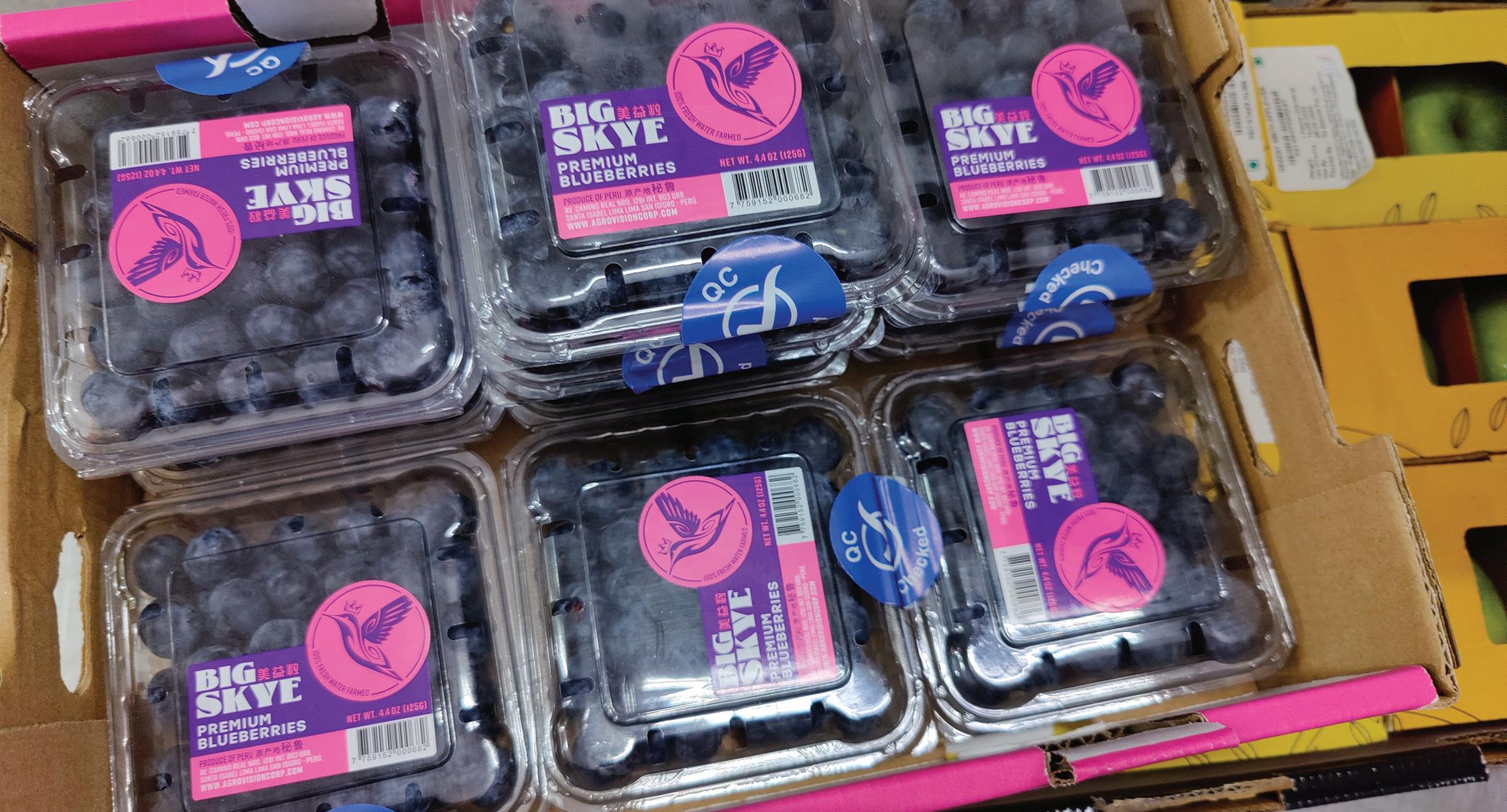

Can you give us a snapshot of the quick commerce sector in India? How big is the market and what kind of growth rate is it seeing?
Sachin Khurana: Quick commerce (q-commerce) in India is an ultrafast delivery model, typically fulfilling orders within 10-15 minutes. It primarily serves urban

markets, supplying grocery items, fresh produce, and daily essentials. The key players include Zomatobacked Blinkit, Swiggy Instamart, and Zepto. We have also seen new players enter the market and traditional players jumping onto the bandwagon. These include Amazon, Flipkart, BigBasket and Reliance. The sector has seen explosive growth, with the Indian
e-commerce market projected to reach US$5.5bn by 2025, growing at a compound annual growth rate of 27 per cent, according to a 2023 report from RedSeer Consulting.
Indeed, q-commerce appears to have taken the Indian consumer market by storm over the past few years. How do you explain its rapid growth? Why is it performing so
LEFT & BELOW— Q-commerce presents opportunities for premium products such as berries and cherries
well in India as compared to other countries?
SK: India’s q-commerce boom is driven by high mobile penetration and digital adoption, with India now home to 750mn smartphone users. But there are several other key drivers. First, last-mile delivery – India has a large working population capable of fulfilling the massive manpower needs for last-mile delivery. Second, our dense urban population – our urban cities provide the demand density needed for micro fulfilment centres. Third, consumer habits, with rising disposable income and demand for convenience. Finally, venture capital funding and competitive pricing – heavy investments by venture capitalists enable companies to subsidise costs and scale rapidly.
How is q-commerce reshaping consumer behaviour, particularly when it comes to buying fresh produce?
SK: Q-commerce has reshaped purchasing patterns by shifting fresh produce purchases from weekly bulk shopping to on-demand buying. Consumers are now accustomed to ordering fresh fruit and vegetables in smaller quantities, leading to higher purchase frequency. Also, the ability to micro-target products and shape your basket around your personal buying habits gives q-commerce a unique leverage over other traditional modes of buying. Q-commerce also has access to a unique set of buyers looking for premium products. The ability to target high-value produce to a specific consumer base has helped q-com to grow premium categories like berries and avocados much faster than traditional retail.

Quick commerce operators have already impressed Indian consumers with their fresh produce offerings, and there is massive potential for them make further strides with new supply chain investments to improve quality in the last-mile delivery.
That’s the view of Jayan Lohani, director of DJ Exports (pictured right), which supplies a range of leading q-commerce platforms with fresh produce.
“The response to fresh produce offerings on q-commerce platforms has been overwhelmingly positive, with strong demand for both staples and premium products,” Lohani explains.
“Many players are witnessing double-digit growth in fresh produce sales, and we expect this momentum to continue as supply chains improve and customers grow more accustomed to the model.”
DJ Exports supports q-commerce platforms by sourcing premium fresh produce items and brands, and providing a range of other services, Lohani says.
“We supply innovative packaging solutions to enhance shelf-life and maintain product integrity,” he says. “We ensure temperature-controlled transportation from farm to warehouse to maintain freshness, and we also offer custom supply solutions. We tailor our supply to the unique needs of each platform, including demand forecasting and real-time replenishment.”
Lohani says one of the main challenges for the q-commerce model is maintaining freshness and quality, particularly in the last mile.
“While we ensure a cold chain up to the platform’s warehouses, last-mile delivery is often conducted in ambient conditions, which can impact quality,” he says. “Additionally, price sensitivity sometimes leads to compromises in product selection.
“We are actively working with the top management of these platforms to address these issues by enhancing packaging, improving cold storage at last-mile hubs and refining quality control measures.”
How would you describe the fresh produce offerings of q-commerce operators? And how are consumers responding? Are they gaining the trust of consumers?
SK: The q-commerce sector is investing heavily in building its own supply chains for domestic and imported fresh produce. Operators have improved sourcing by partnering directly with leading importers and farmers, farmer producer organisations (FPOS), and wholesalers, ensuring fresher inventory turnover. Companies like Zepto and Blinkit have introduced ‘farm-to-fork’ models and qualitychecking systems to build trust. The larger players are also setting up their own facilities to help them serve better quality to their customers.
How important is fresh produce as a sector for the q-commerce companies in terms of share of their sales and in customer acquisition? What growth opportunities and challenges do they face?
SK: Fresh produce accounts for 15-20 per cent of total q-commerce sales, serving as a customer acquisition driver due to its high repeat purchase rate (RedSeer, 2023). Growth opportunities lie in premium, organic, and exotic produce, while challenges include logistics inefficiencies and wastage due to perishability.
It must be challenging for q-commerce companies to service consumer demand for high-quality fresh produce with the lack of cold chain in India and perishability of the product. How are they managing this issue?
SK: They’re taking a range of measures. They’re using micro-
“Q-commerce provides a datadriven marketing advantage over traditional retail. It can offer hyper-local targeting”
fulfillment centers (MFCs) to ensure faster inventory turnover. AI-driven demand forecasting reduces overstocking and wastage. Cold storage hubs and last-mile innovations (such as insulated delivery bags) are improving supply chain efficiency. Farm partnerships help optimise sourcing, ensuring a steady supply of fresh produce. Planned investments in logistics and their own infrastructure among all three leading players will help them overcome several of these challenges.
What unique opportunities does q-commerce offer for fresh produce marketers compared to other channels?
SK: Q-commerce provides a datadriven marketing advantage over traditional retail. It can offer hyperlocal targeting: companies analyse demand patterns to push regionspecific produce. Premiumisation is another strength: platforms promote high-margin products like organic, imported, and exotic fruits through personalised recommendations. Brand collaborations are the other part - fresh produce brands can leverage app promotions and bundled offerings.
Questions have been raised about the profitability of q-commerce companies and whether they
can secure a sufficient return on investment. Will they have to start charging consumers (more) for the extra convenience? How do you see this playing out?
SK: Q-commerce companies face significant profitability challenges due to high operational costs, delivery subsidies, and warehousing expenses. Industry analysts predict firms will gradually reduce discounts and introduce premium delivery models such as subscription plans for express service. Despite these challenges, Zepto and Blinkit have indicated that unit economics are improving with scale and operational efficiencies.
Overall, how do you see the prospects for q-commerce in India? What are the key trends to look out for over the next few years?
SK: The q-commerce sector will continue to evolve. We’ll see geographic expansion beyond the major metros into tier-two and tier-three cities; tech advancements in AI-driven inventory management; and sustainability initiatives, including eco-friendly packaging and optimised logistics. The sector is also likely to face regulatory challenges, particularly in respect of labour laws and gig worker policies. A

The convenience offered by quick commerce operators has been a game changer for grocery shopping in India, and the future is very bright for them if they can achieve profitability. So says Gagan Khosla of NGK Trading, a key supplier of fresh produce imports to the sector.
“The biggest factor in their success is convenience,” says Khosla (pictured). “You can order any time of night or day and product is delivered to your home in 15 minutes tops. It’s neatly presented, the quality is reasonable, and prices are sharp. You can’t get any better than that for the consumer.”
Indeed, Khosla says q-commerce has changed consumers’ buying habits when it comes shopping for fruit and vegetables. “Dual-income households find this the best way to shop,” he says. “They don’t need to go out to a store, haggle with a street vendor or depend on domestic help to shop for them. The fact these players use competitive pricing and deliver good quality means the customer has quickly bought into the idea and they’re expanding at light speed.”
Despite their compelling fresh produce offer, Khosla sees some room for improvement for quick commerce players. “They are good with commodity products, but they struggle with upmarket lines like stonefruit or cherries,” he says. “We’re engaging with these operators to increase their range of products and drive towards premiumisation, which should help them grow faster.”
Looking ahead, he says one of the key challenges for q-commerce is to become operationally profitable. “If they’re not profitable, then they will lose steam unless the consumer is willing to pay for the extra convenience,” he says. “We’ll know in 24 months, but they have deep private equity-funded pockets so I am hopeful they’ll succeed, and it will help grow the fruit import segment further.”


Aamras, Mango Chia, Valencia Orange, Mango Coconut, Pomegranate, Apple, Mix Fruit, Kokum, Apple Beetroot Carrot, Berry Delight, Watermelon, Guava Chilli, Sugarcane, Coconut Water, Aam Panna, Pineapple, Jamun, Gold Kiwi Blast.
200ml, 250ml, 1L ( pet bottles/pouches ) 3L ( pouches )









India’s premier business event is back in Mumbai on 3-4 April with an exciting line-up of top speakers, unique experiences and first-rate networking opportunities.
by John Hey

Delegates to Fresh Produce India 2025 can look forward to a wideranging programme of expert talks, insightful meetings, immersive tours and much more this April in Mumbai.
Organised by Fruitnet with official partner Asia Fruit Logistica, India’s premier business event for fresh produce professionals returns to the Trident Nariman Point Hotel in Mumbai on 3-4 April.
Fresh Produce India combines a non-stop business networking
expo with a packed programme of talks, presentations, interviews and tastings on Day One. Day Two offers hosted tours to top fresh produce distributors and food retail stores in Mumbai.
Fresh Produce India opens with two unique experiences designed to nourish both body and mind, hosted by Avocados Australia and Summerfruit Australia. Celebrated yoga teacher and author Ira Trivedi hosts an early morning yoga and wellness session by the poolside at the Trident Nariman Point Hotel. A

LEFT—Fresh Produce
India’s bustling networking expo
ABOVE—
Celebrated yoga instructor Ira Trivedi will host an early morning yoga and wellness session
RIGHT—Clockwise from top left: Speakers include Richard Mills of Haygrove, Marc Peyres of Blue Whale, Innoterra’s Anup Karwa and Michael Schadler of Washington Apple Commission
Welcome Breakfast follows with celebrity chef Amritra Richand featuring Australian avocados, plums and nectarines.
Fresh Produce India’s high-energy content programme then kicks off, bringing together leading experts to discuss a range of exciting market trends and opportunities.
The opening session spotlights India’s quick commerce revolution and how it is reshaping fresh produce retail. Sachin Khurana of QuikRelations unpacks the remarkable growth of the sector. He is then joined by a panel of top players including Zepto’s Ramlingha Rajoo



Elsewhere on the programme, Fresh Produce India features case studies on cutting-edge technologies with the potential to change the game for the industry.
Anup Karwa of Innoterra BioScience explains why the new T4-resistant banana variety it has identified could provide a solution to one of the banana industry’s biggest challenges. Meanwhile, Frigotec’s Roland Wirth discusses its AI innovation Softripe which ripens tropical fruits such as avocados, mangoes and bananas naturally with superior flavour and shelflife.
HortiRoad2India also hosts a special session featuring business pitches that promise to revolutionise retail in India. The session, led by director of the Dutch public-private partnership Desh Ramnath, showcases fresh produce and solutions with the potential to make retailers leaders in offering fresh, clean, residue-free exotic fruit and vegetables yearround.
The packed content programme wraps up with a supplier spotlight on South Africa, which is making impressive inroads on India’s fruit import market. A panel of industry leaders discusses South Africa’s future as a supplier to India in both established and emerging products. Speakers include Werner van Rooyen, COO of Fresh Produce Exporters’ Forum, Hortgro’s Jacques du Preez, Derek Donkin of Subtrop, and NGK Trading’s Gagan Khosla.


and Swiggy Instamart’s Raunak Shetty to discuss the future market opportunities and challenges.
India is emerging as a production hub for ‘newer’ fruits like berries and dragon fruit, while new genetics are invigorating established categories such as table grapes. Richard Mills of Haygrove Growing Systems discusses India’s rise in berries and the key role for protected cropping systems. He is joined by Tarun Arora of IG International, who explains the
group’s large-scale investments in production of dragon fruit and other new crops.
India is now one of the world’s top apple importers, and the market continues to evolve rapidly. A panel of top global apple marketers, including president of the Washington Apple Commission Michael Schadler, Blue Whale’s Marc Peyres, and Nicola Zanotelli of IG International, share their expert insights on how to build an apple brand in India.
Fresh Produce India’s content programme takes place in the same space as the bustling business networking expo. Delegates can enjoy a wide range of activities to maximise networking and connect with industry leaders throughout the day. They can hold meetings in the exclusive business lounge powered by Austrade; enjoy an avocado-themed networking lunch hosted by Westfalia; sample Thirty33 cold-pressed juices at the coffee and juice station sponsored by Surifresh Extract; and wind down and relax at the evening cocktail hosted by Fruit South Africa.
Fresh Produce India 2025 also stages the launch of the brand-new Fresh Produce India Awards, a series of prestigious accolades recognising outstanding achievement in India’s fresh fruit and vegetable business.
Day Two offers a range of exciting tours to choose from. Delegates can get exclusive behind-the-scenes access to some of India’s state-of-the-art fresh produce distribution operations with hosted visits to the facilities of DJ Exports and Suri Agro Fresh. A visit to one of Reliance’s premium Freshpik formats also offers a guided tour of the experiential gourmet food store. A



New segments are emerging in India’s fresh produce market as suppliers and retailers meet different consumer needs such as health, value and convenience, says IG International’s head of procurement, Shubha Rawal.
by Liam O’Callaghan
Are there any recent key developments from your company you would like to share?
Shubha Rawal: IG International continues to strengthen its
position as a leading fresh produce importer in India. Recently, we have expanded our sourcing network, adding new origins for key categories such as apples, citrus, and berries to ensure year-round availability.
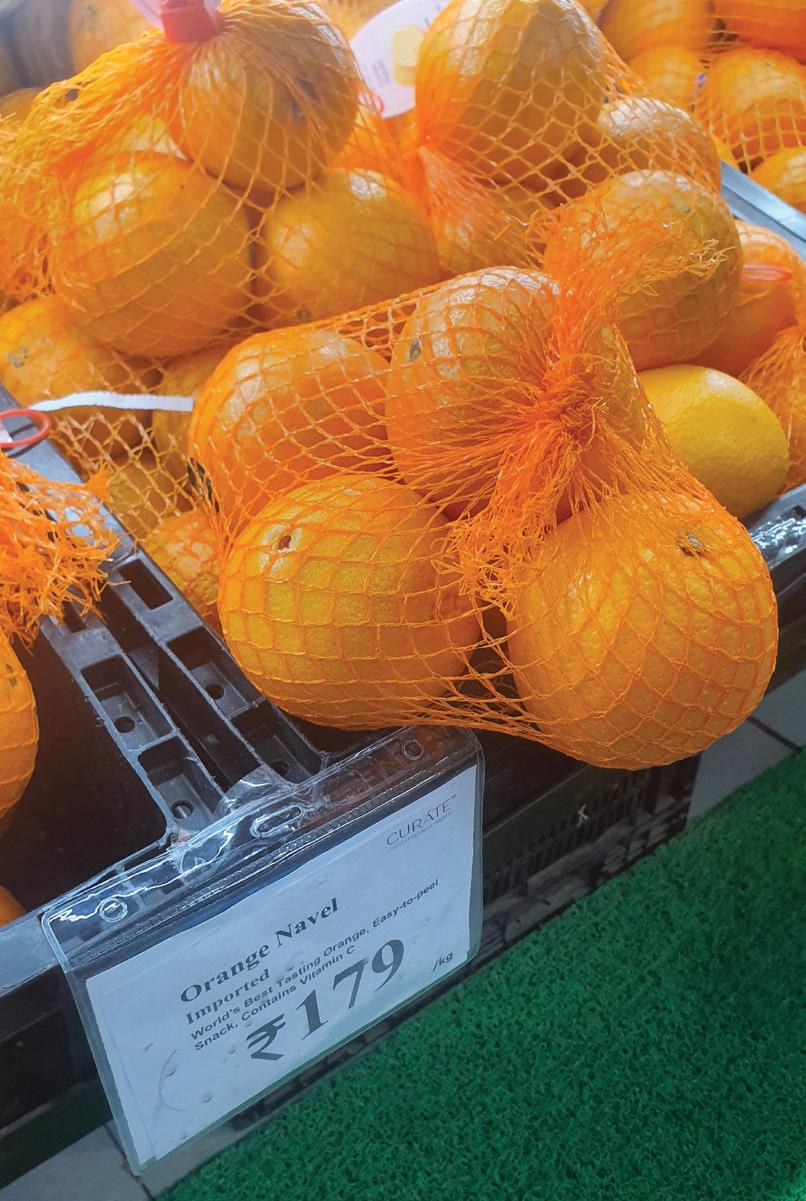
LEFT—IG International’s head of procurement Shubha Rawal
ABOVE—Health is playing an important role in consumer decision making
BELOW—Brands like Turkey’s IGet are finding success
OPPOSITE—Affluent urban consumers still seek out premium fruit

We have also invested in cold storage infrastructure and logistics to enhance supply chain efficiency, ensuring better quality and extended shelf life for our customers.
Additionally, our focus on digital transformation is enabling more seamless operations and better customer engagement

What has the overall imported fruit market looked like in India over the past 12 months?
by citrus, kiwifruit, and grapes. Despite economic concerns, Indian consumers are increasingly prioritising health and wellness, sustaining demand for high-quality imported produce.
What kind of trends are you seeing in the consumer market?
by affluent urban consumers who prioritise quality over cost. Additionally, there is a growing preference for packaged and ready-to-eat fruits, especially in metropolitan areas, where convenience is key. Health consciousness is also driving demand for nutrient-rich fruits such as berries and avocados.
What trends are you seeing in the imported apple market?
SR: The imported apple market in India is evolving with shifting supply dynamics and changing consumer preferences. Washington apples continue to be a dominant force, particularly in the premium segment. However, competition from Turkey, Iran, and Europe has intensified, especially in the mid-tier and pricesensitive segments. Turkey has gained market share due to its competitive pricing and strong supply of Red Delicious apples, while Iran continues to play a role in filling gaps in the lower price range.
In terms of varieties, Red Delicious and Royal Gala remain a staple, but there is growing interest in premium varieties like Pink Lady, Cosmic Crisp, Envy, and Jazz. The premium segment is witnessing steady growth, driven by health-conscious and affluent consumers who prioritise taste and quality over price. While overall market demand remains stable, fluctuations in pricing and supply chain disruptions have impacted trade dynamics. However, as disposable income rises and awareness of premium apples increases, high-end varieties are expected to gain further traction.
Beyond apples, what are some standout developments in citrus, kiwifruit, and pears?
SR: Citrus remains a strong category, with increasing imports of Egyptian oranges and South African soft citrus. Kiwifruit demand is growing, driven by rising awareness of its health benefits, with SunGold kiwifruit seeing significant success. Pears, particularly from South Africa and Belgium, are holding steady, though competition from domestic production is increasing. The expansion of cold storage infrastructure is helping to maintain fruit quality, further supporting category growth.
SR: The past year has seen steady demand for imported fruits in India, though consumer buying patterns have evolved. While volume growth has been moderate, premium categories have continued to perform well. Market fluctuations, currency exchange rates, and supply chain challenges have influenced pricing and availability. Apples remain the dominant category, followed »
SR: India has not been immune to global inflationary pressures, but fresh produce remains a priority for many consumers. While some price sensitivity is evident, the premium segment has held steady, driven
Which of the smaller growth categories are standing out?
SR: Berries and avocados are two of the fastestgrowing categories in India. Blueberries have gained popularity, driven by increased consumer awareness of their health benefits and their growing presence in

modern retail and quick commerce platforms. Demand is also being fuelled by the influence of social media, where berries are often associated with wellness and premium lifestyles.
In addition to imports, local berry production is steadily expanding. Our Indian-grown blueberries are making their way into retail, helping to improve availability and price accessibility. As domestic production scales up with improved farming techniques and better postharvest management, local berries are expected to become a more significant part of the market.
Avocados, though still niche, are gaining traction. Hass avocados remain the most demanded variety. Consumer education and affordability remain key challenges for wider adoption, but as awareness grows – especially among younger, health-conscious buyers –demand is expected to rise.
Which brands, varieties and suppliers are finding success in India at the moment? And what do you think is driving this success?
SR: Global brands such as Stemilt
(apples), IGet (apples from Turkey) Zespri (kiwifruit), Jaguar, and Taj (citrus from Egypt), are performing well due to their strong brand positioning and consistent quality. Indian consumers are increasingly brand-conscious and prefer trusted names. Suppliers that offer reliable quality, strong marketing, and innovative packaging are gaining an edge. Additionally, suppliers who adapt their offerings to suit Indian consumer preferences – such as smaller pack sizes or tailored marketing strategies – are seeing better traction.
How is fresh produce retail evolving in India?
SR: The retail landscape is rapidly shifting, with quick commerce emerging as a key player in fresh produce sales. Platforms like Blinkit, Zepto, and Swiggy Instamart are making high-quality fresh fruits accessible to urban consumers in minutes. Traditional retail remains dominant, but online and organised retail are growing rapidly. The key to success in q-commerce is maintaining cold chain efficiency, ensuring quality, and offering competitive pricing.
Are there any other notable trends in India’s fresh produce market?
SR: Consumers are increasingly seeking transparency in sourcing, driving demand for traceable and sustainably sourced produce. Organic and pesticide-free fruits are gaining attention, though price remains a limiting factor. Additionally, the influence of social media and digital marketing is playing a crucial role in shaping consumer preferences. Subscription-based fresh produce delivery services are also on the rise.
Is there anything else you would like to add?
SR: India remains one of the most dynamic fresh produce markets globally, with immense potential for growth. While challenges such as logistics, import regulations, and price fluctuations persist, the long-term outlook remains positive. Companies that can balance affordability with premium quality, leverage digital platforms, and educate consumers about the benefits of fresh produce will continue to thrive. A

From Our Orchards to Your Table Australia's diverse climate and rich soils create the perfect recipe for juicy, sweet, and sun-ripened summerfruit. Every piece is hand-picked at peak ripeness, delivering a burst of flavor in every bite.

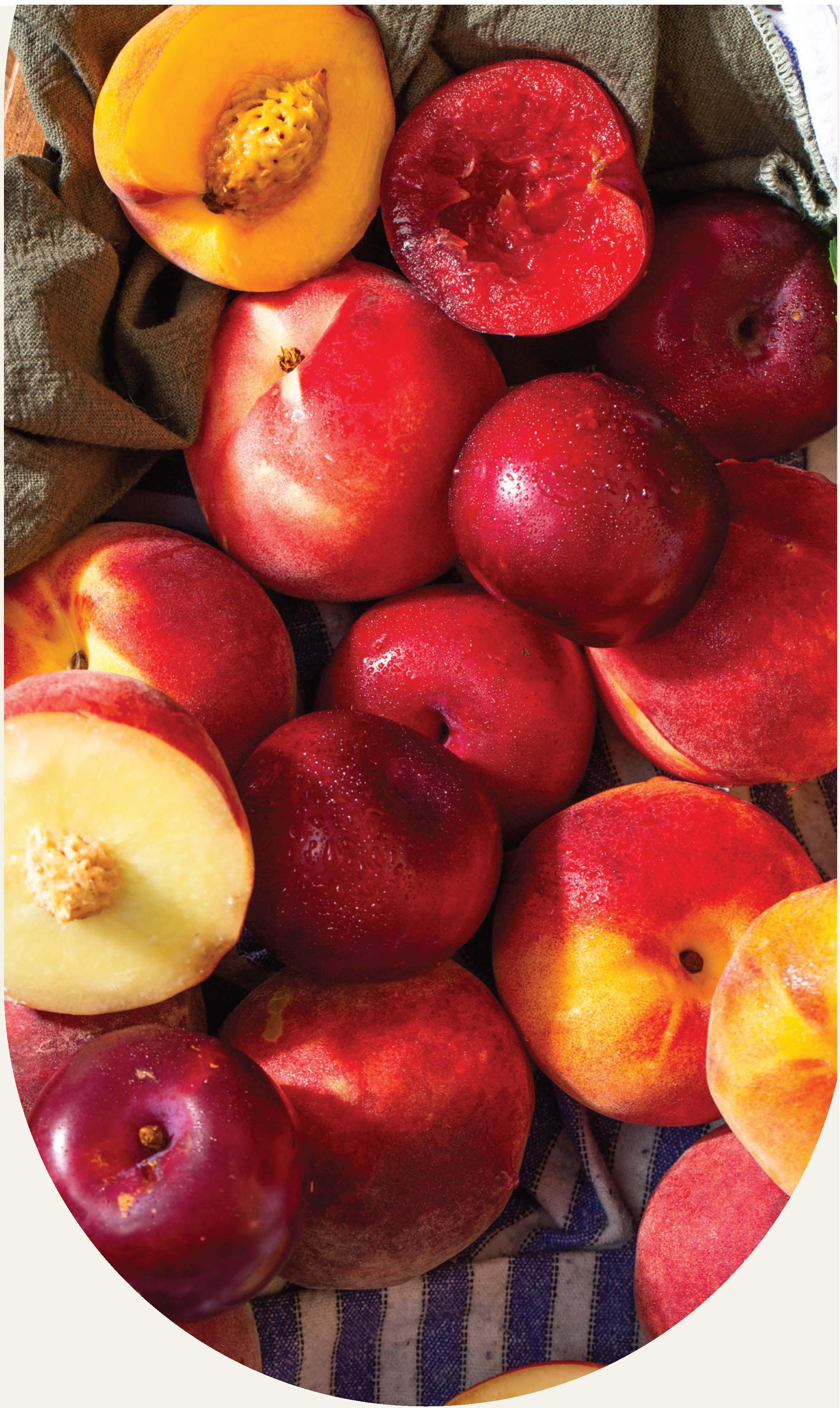



Indian consumers are displaying an appetite for higher value fruits, and they’re prepared to pay a premium, says Reliance Retail’s AVP fruits, Saurabh Raina.
by John Hey
Leading Indian supermarket chain Reliance Retail has seen remarkable growth in consumer demand for higher value fresh produce imports – from blueberries to branded apples – in the past year.

So says the retail giant’s assistant vice president fruits, Saurabh Raina. “Every two or three years, we see new consumer trends emerge. The latest in fresh produce is the rise of newer product lines such as mandarins, blueberries


and avocados,” says Raina. “We’re seeing really strong demand for the imports of these items, despite their premium prices.
“Take mandarins – they’re 30 per cent more
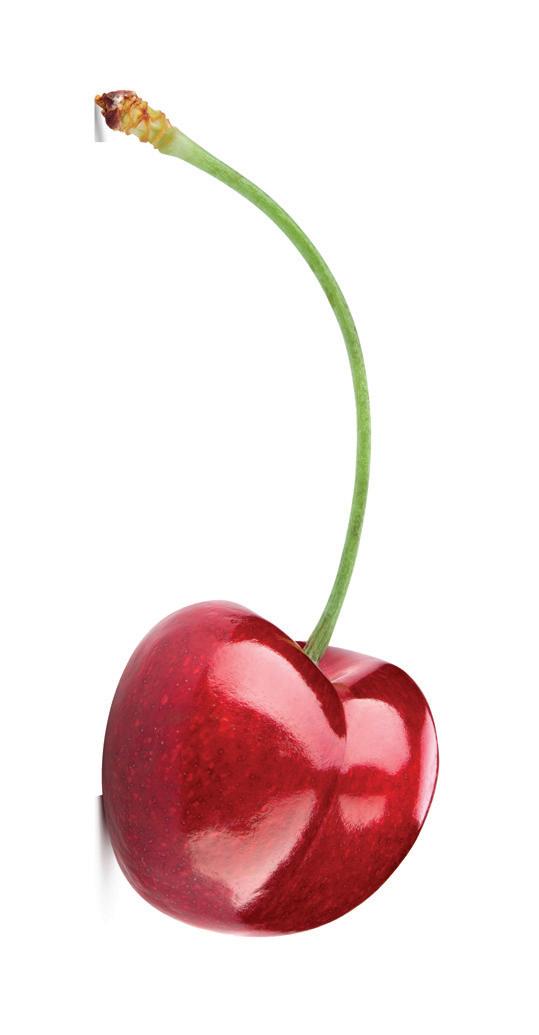



Reliance is mainly importing mandarins from South Africa, Australia and China, with Egypt also supplying fruit for a month or two, according to Raina.
“The main varieties from South Africa and Australia are Nadorcott (Afourer), Murcott and Tango, but we also bring in some seeded varieties from China which are similar to Orri,” says Raina.
“Imports have been growing strongly, and I think they’re gaining impetus from the fact India produces easy peelers too.”
It's a similar story with
charge for imported blueberries, according to Raina. The Andean nation has been shipping large volumes by air with very positive results. “The quality is outstanding,” he says. “They’re priced around US$23 per kg and they’re still selling really well.”
Peru’s gains have been fuelled by production of new proprietary varieties of low- and no-chill blueberries, which offer improved flavour, crunch and shelf-life, according to Raina. “These no-chill varieties can yield a crop within a year, so they’ve quickly made an impact,” he says.
India’s own blueberry production is also taking off, but Raina sees the growth in domestic supply only helping to expand the overall market. “Indian blueberries are helping to create awareness
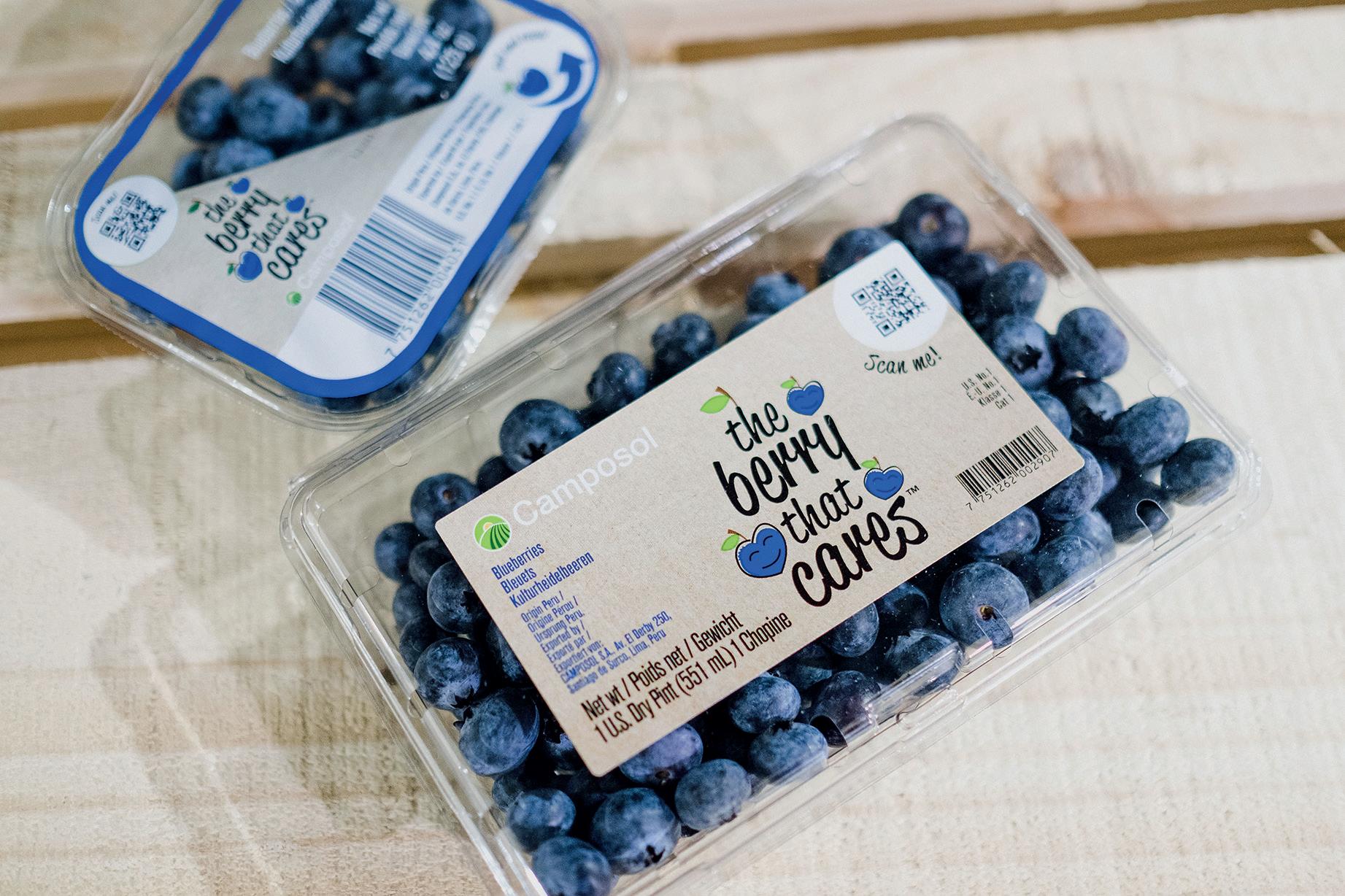

for imported blueberries,” he says. “I don’t see Indian blueberries competing with imported fruit – I think they’re complementing it.”
Avocados is another newer product catching on with Indian consumers. “We’re working closely with Westfalia Fruit to develop the category with in-store promotions and samplings,” says Raina. “They’re supplying us with ripened and unripened product.”
Raina also sees a bright future for imports of more established products such as apples, with consumers showing growing interest in club varieties.
“Apple imports are continuing to grow, and the volume now equates to around 20-25 per cent of Indian apple production.”
Raina says club varieties such as Pink Lady, Red Pop and Inored are now coming into the market, adding excitement to the apple category. “There’s a segment of consumers willing to pay a premium for different varieties,” he observes.
Reliance’s upmarket Fresh Pik and Signature superstores, which curate a gourmet food experience for shoppers, serve as the ideal platform to trial these premium varieties, he notes. A
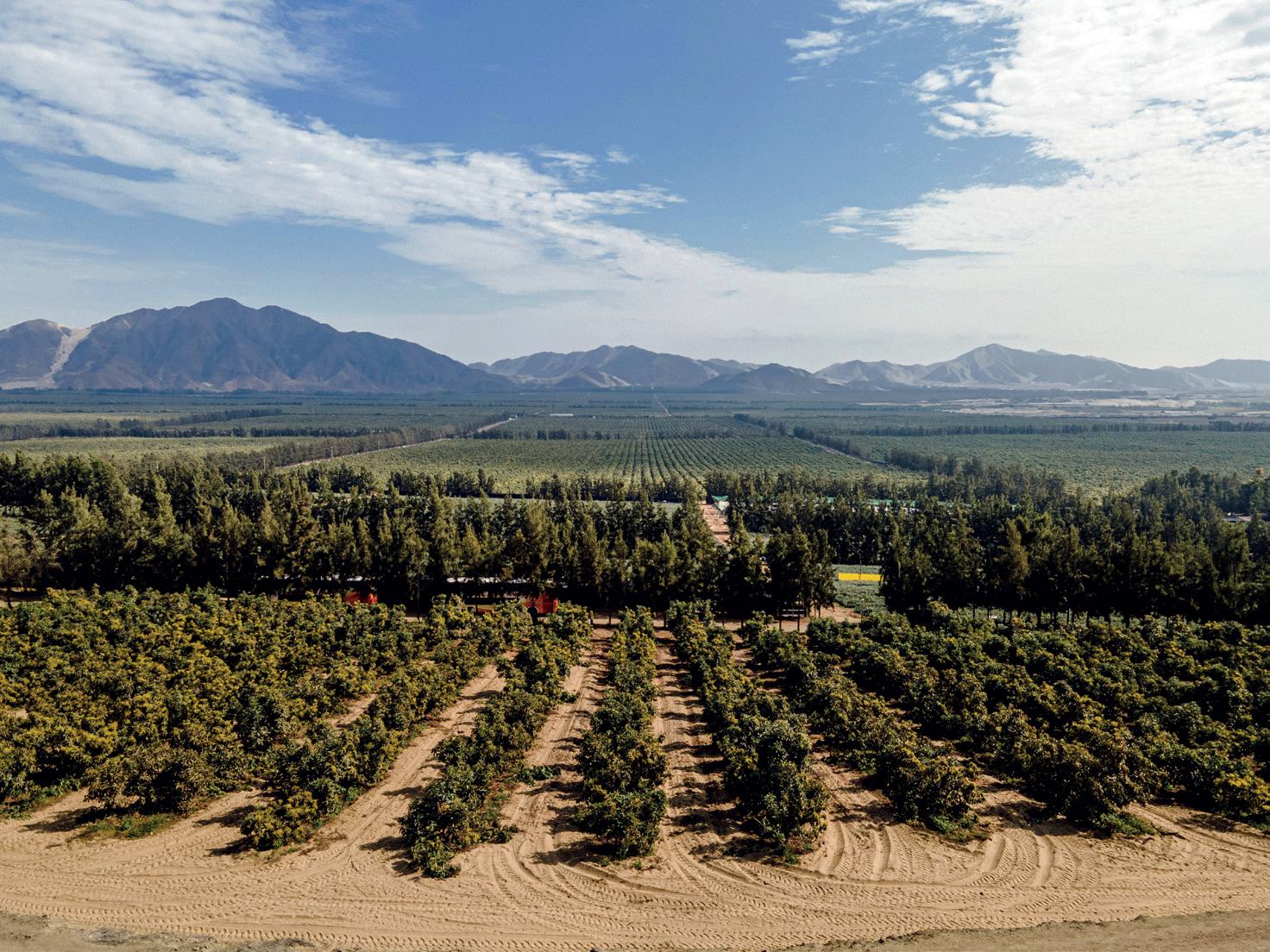


Our entire team, at our farms, packing plants and of ces, works towards our shared goal of offering fruit of the highest quality, freshness, and most delicious taste year round to Camposol´s partners and consumers around the world. Our commitment to innovation, consistency, traceability and integrity ensures our fruit will always provide an excellent eating experience.
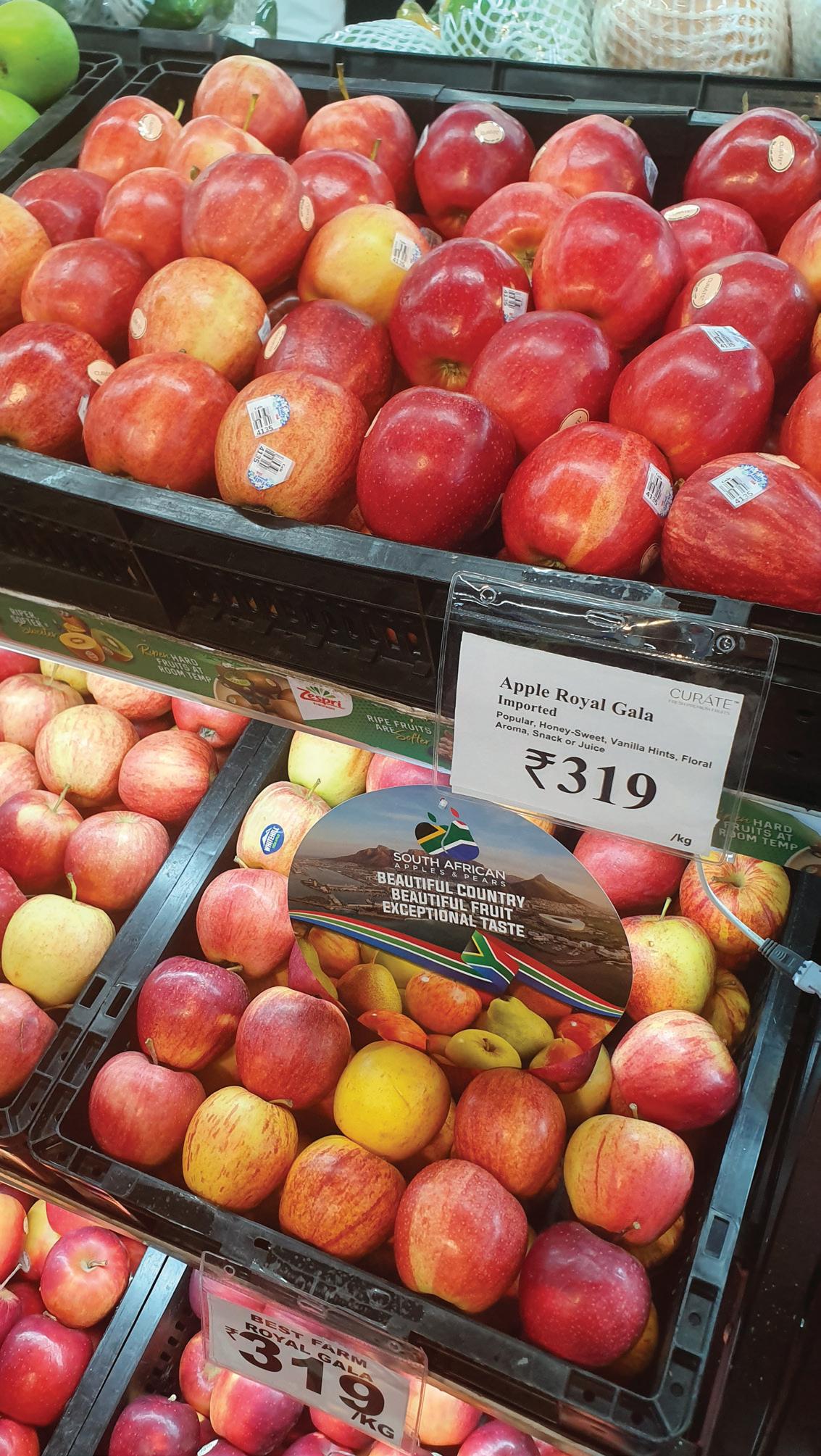
Cost of living pressures are being felt by consumers and their search for value is influencing retailers and suppliers.
by Liam O’Callaghan
Price sensitivity is not a new trend in the Indian fresh produce market but the economic stresses that are putting pressure on consumers across the globe are certainly being felt.
Gagan Khosla of NGK Trading says retailers are trying to grapple with consumers’ budgets and remain an attractive option.
“Cost of living is definitely a factor,” he says.
“Retailers in India are looking to ‘mediocritise’ the market. They are not interested in premium products and [instead] offer the lowest prices,” says Khosla.
“In general, I think they are trying to find their feet and we need to be patient with them. Logistics is also a nightmare.
“I am hopeful that they will eventually realise the equation between quality, availability and pricing and consumption growth.”
Consumer shipping habits are also changing with a focus on convenience, particularly in more urban and affluent areas, a trend that has fuelled the emergence of quick commence.
“In urban areas, grocery shopping has been relegated to the house help, this tends to lower consumption at the household level and also push price points down. If people don’t go out and see what’s new at the fruit stand then they tend to buy the basic staples such as apples bananas and mangoes etc. They tend not to investigate cherries, berries or newer apple and pear varieties,” says Khosla.
“Quick commerce may soon outgrow brick and mortar, but even they are not trying to premiumise their game.”
The effects of this trend can be seen in the apple market where higher-cost suppliers such as the US and Chile have lost some market share according to Khosla.
“On the lower price point, Iran is king and Turkey’s volume is soaring as well. Poland is fast replacing Italy and France on Gala. South Africa has picked up significant share of the Southern Hemisphere pie and I see this growing. People’s purchase habits need to change to increase the premium market size,” he explains.
Despite these challenges, some smaller categories are finding success. The likes of avocado and berries continue to grow and Khosla notes health as a running theme.
“Avocados are a success story because of changing food habits to healthier options. Berries and mandarins are also growing because of convenience and of course the associated health benefits. Cherry penetration, though low at the moment, is beginning to grow as it is for plums,” says Khosla. A









YEMEE FERNANDES Managing director, Four Pillars Trading

Traditional marketing strategies often fall short in a market as diverse and dynamic as India. With its rich blend of cultures, languages, and evolving consumer behaviours, success demands more than just surface-level engagement. To truly resonate, brands must move beyond the ordinary, investing in deep, localised insights and crafting authentic connections.
In a cluttered marketplace, execution is the ultimate game-changer. Success isn’t just about pushing a product; it’s about creating meaningful partnerships. Seamless collaboration with online and offline retailers, distributors, and stakeholders is essential. Understanding their challenges, aligning on opportunities, and co-creating value at every step ensures lasting impact.
Marketing doesn’t operate in isolation – it weaves together business functions, sales, supply chains, and consumer engagement into a unified strategy.
An integrated approach is key to unlocking long-term success.
When launching Australian macadamias in India, our strategy was built around demand creation. Our goal? To educate, excite, and inspire consumers with the story behind Australian macadamias – premium, unique, native to Australia and indulgent
We crafted a compelling brand narrative, ensuring every touchpoint – from digital engagement to in-store experiences – reflected our core values. By localising our messaging for Indian audiences, we fostered authentic connections and built excitement around the product.
We launched the first-ever Australian Macadamia Festival in Mumbai (2023), bringing together top chefs and the food service industry demonstrating the versatility of the nut.
We partnered with ITC Fabelle to create an exclusive Australian macadamia chocolate range, elevating brand visibility and consumer interest.
We designed purpose-driven activations, from digital campaigns to in-store experiences, ensuring a unified and impactful brand presence.
The other key part was engagement with retailers such as Reliance, Foodsquare, Cred, and Amazon to name a few in order to drive sales and loyalty.
By prioritising education, collaboration, and storytelling, we didn’t just introduce a product –we built a movement. The success of Australian macadamias in India underscores the power of a fresh, insight-driven approach to market entry.
For brands looking to crack the Indian market, the lesson is clear: deep localisation, authentic storytelling, strategic partnerships, and an integrated marketing approach aren’t optional – they’re essential. A


DESH RAMNATH Director, HortiRoad2India
At Fresh Produce India in April, HortiRoad2India will pitch five concrete projects of farmers producing high-value crops while resolving the challenges faced by stakeholders across India’s fresh produce supply chain, paving the way for success, and giving them the competitive edge they seek.
Imagine your company can provide strawberries yearround to any city in India within a couple of minutes with the best quality, taste, aroma, and nutrition, and without residues. That your company can become a
welfare, public health, food security, and food safety, paving the way for a cleaner and more profitable food system in India.
The Indian economy is on the rise. India is leading the way in many industries while adopting new ones. With that economic growth, new investment potential arises giving way to innovations and profitability. Yet in the end, as the Indian

trusted partner for healthier and happier living and a healthier planet while growing your business and profit.
Imagine your top-notch, fresh, long-shelf-life exotics are always delivered on time and in full year-round, without blemishes at your store or distribution centre, and have the best nutritional value, taste, quality, and sustainability in India.
HortiRoad2India would like to introduce several sustainable food production projects that will contribute to a healthier society and planet, strengthen the Indian economy, and increase farmer incomes directly and indirectly. The upside of these projects is that they are very profitable by agricultural standards. That means they tick the boxes of economic growth, impact, farmer
government recently described, economic growth and innovation are driven by consumerism. Therefore it is important to increase the spending power of all Indians. The danger of consumerism on the other hand is the damage humanity inflicts on the planet and its other inhabitants. So consumerism should go hand in hand with doing good business, sustainable innovation, and responsibility for the future. Simultaneously the Indian retail market is expanding and changing
rapidly due to the growing economy, awareness, innovations, consumer wishes, tourism, and global trends for a healthier lifestyle and more sustainability.
In India, a large part of the population that is not yet benefitting from the economic revolution in India is working in the agriculture sector. It is vital those people can create a better life and add value to the economic and social development of India. At the same time, the agriculture sector in India has the biggest negative impact on nature, biodiversity, sustainability, soil, and air quality. Innovations that give rise to economic growth and sustainable food production for the growing population are the answer. The government needs stakeholders’ support and therefore obliges the financial industry to invest in the primary sector in India.
HortiRoad2India is working with Indian agri-entrepreneurs to supply high-quality, highly nutritious, sustainable, residue-free exotic produce using expertise, technology and knowledge from the Netherlands – produce that will always be delivered on time and in full, with the same high quality and consistency year-round, fulfilling customer demand, and meeting government rules and regulations on clean work environments, higher farmer income, and sustainability. A
ABOVE—HortiRoad2India has partnered with Indian agri-entrepreneurs to create sustainable supply solutions for retailers

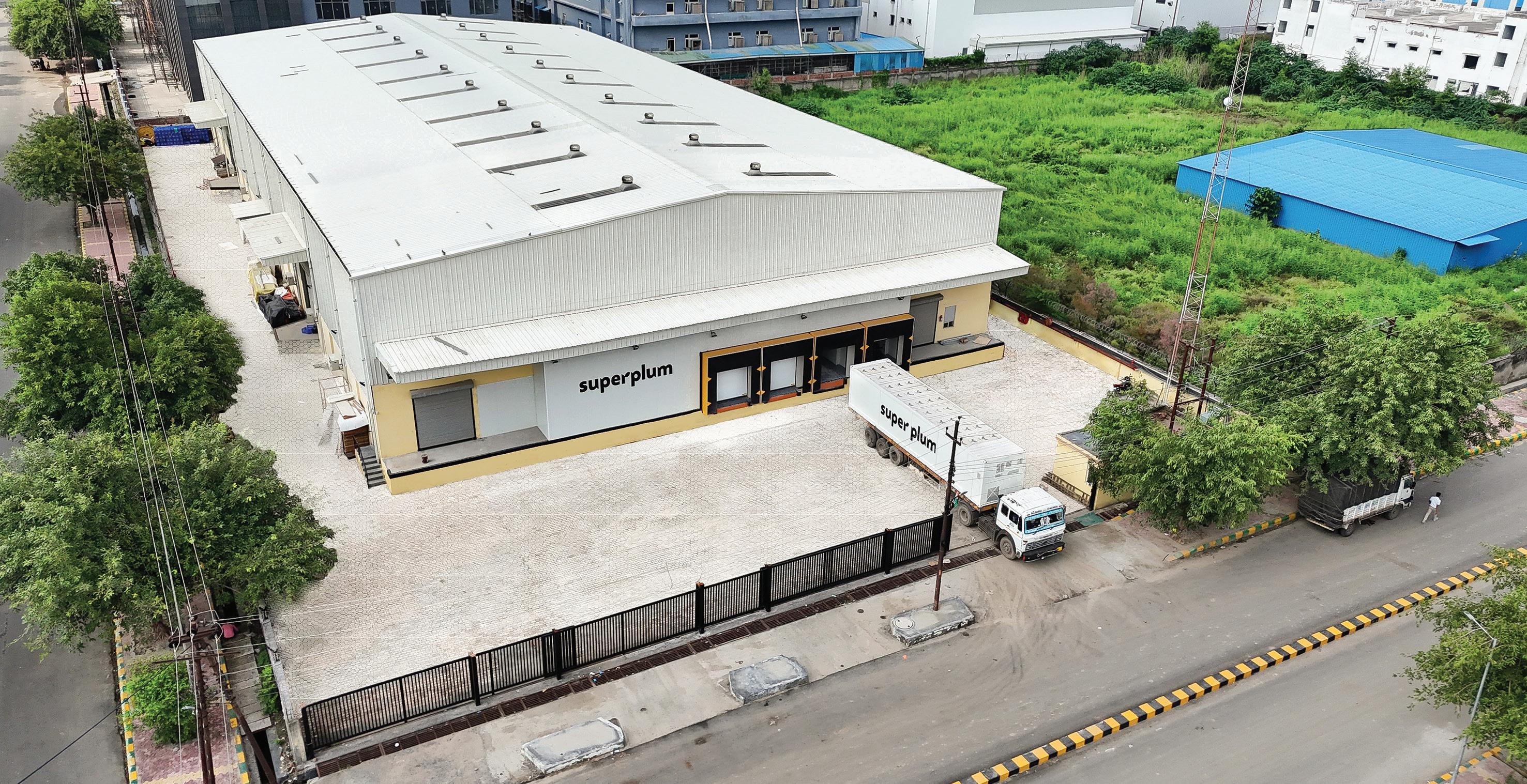
State-of-the-art facilities feature automated ripening rooms and packing lines as well as integrated low-oxygen chambers to enhance shelf-life.
by Bree Caggiati
Indian ag-tech company, Superplum, has opened its own fruit distribution centres in Delhi and Bangalore.
The facilities have expanded the company’s distribution and ripening capabilities, which Superplum says will help consumers receive better quality fruit.
Superplum was initially founded in a bid to address India’s fresh produce supply chain challenges. The company set out to design and build an all-new supply chain process, digitising the farm-to-store network and delivering consumers fresh and fully traceable food that is free of pesticides and gives farmers a better deal.
The new centres play a key role in this comprehensive, technology-driven and temperaturecontrolled supply chain. Both centres feature cuttingedge infrastructure that addresses the critical challenges in the current fruit distribution ecosystem.
Key features include automated ripening rooms that utilise the company’s Freshmanager software, automated packing and labelling lines which integrate
ABOVE—The new facilities feature cutting-edge infrastructure BELOW—Superplum’s automated packing and labelling line

with the company’s produce management systems, and integrated low-oxygen chambers to enhance shelf-life and reduce wastage.
According to Superplum, this modern and safe ripening system represents a significant step forward for India’s distribution landscape.
“Our new distribution centres represent a refreshingly new approach to fruit handling in India,” says Shobhit Gupta, Superplum co-founder and chief executive.
“Indian consumers are demanding better quality fruit, and we are making investments and innovating to keep up with growing expectations.” A






Devi Prasad, chief owner representative – India at Sinotrans Container Lines, discusses the China-owned shipping group’s expansion into India.
by John Hey
RIGHT—Devi Prasad, Sinotrans’ chief owner representative –India
BELOW—Sinotrans is expanding its reefer market coverage

Please can you give us an overview of Sinotrans Container Lines and its presence in India?
Devi Prasad: Sinotrans Container Lines is part of China Merchant Group, a Fortune 500 company founded in 1872. Sinotrans is a Chinese state-owned enterprise established in Shanghai on 28 May 1998. It is mainly responsible for the centralised operation of the container transportation business covering all the main coastal ports such as Shanghai, Ningbo, Dalian, Qingdao, Xiamen, Shekou, Nansha and Hong Kong. It has good coverage of inland and river ports, which is one of our competitive advantages.
We started our service into the East Coast of India from China in September 2023 covering Chennai
and Visakhapatnam. Our West Coast coverage into Nhava Sheva and Mundra from China started from October 2024. We are known as a world-class shipping enterprise with a comprehensive global port coverage and smart logistics platform. Our particular strengths are the China, Far East, Japan, Australia and India sectors.
What are your main freight services or routes? And which ones are most important for the fresh produce trade?
DP: Sinotrans provides one of the best services with the fastest transit times from the east and west coasts of India to China, Japan, Australia and the Philippines. Our head office plans to expand our coverage from India to include more parts of South-East Asia, the Gulf, the Middle East and East Africa. This will give us greater network coverage and expand our services for our customers in India both on the import and export fronts. Currently, our reefer exports from both south and west India are predominantly into China and Japan. We expect our reefer market coverage to grow to cover all our serviceable sectors in the future.

The Red Sea issues have seriously impacted shipping times and services for Indian fresh produce exporters seeking to reach important customers in Europe and beyond. How has Sinotrans been managing this issue?
DP: The Red Sea issues have not impacted Sinotrans much. In fact, our growth on key sectors has only increased against all odds and we remain committed to managing all challenges to provide the best service to our esteemed customers.
The Indian government is making massive investments to upgrade port, road and rail infrastructure across the country. How do you see this changing the logistics landscape?
DP: Over the next ten years, India’s performance on the global stage is crucial to overall maritime growth. Our company is fully committed to being part of the India growth story. New ports are coming up in India such as Vizhinjam Terminal which will become a major transshipment hub out of India, and the Vadhvan Terminal project, which is being developed in Maharashtra state. Projects like these will boost India’s global connectivity by making it easier for large container vessels to call at Indian ports. A
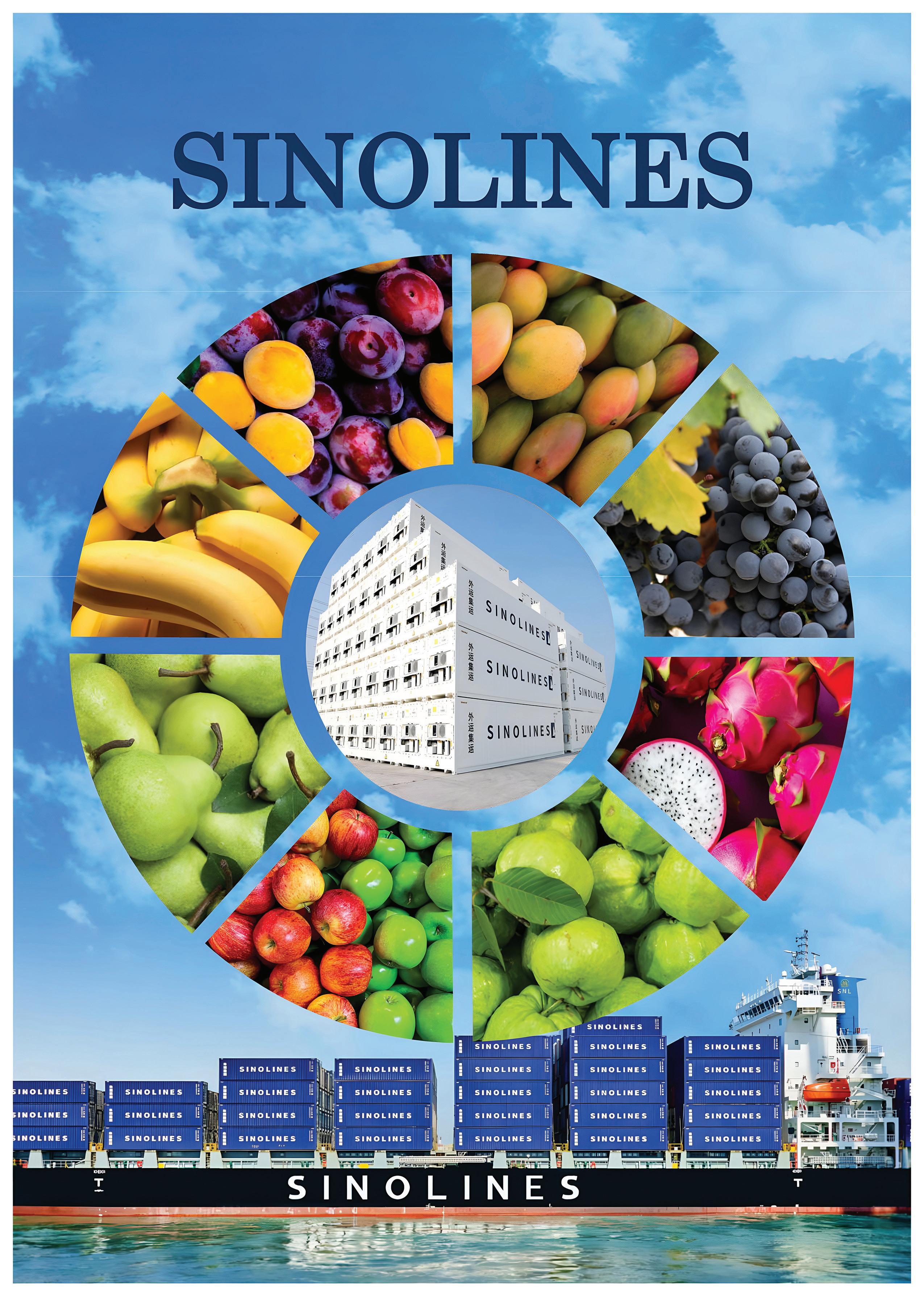
Hong Kong 3|4|5 Sep 2025

Asia's fresh produce trading hub
Knowledge Partner
Official Partner Country
Booth No. 14 Visit us in Fresh Produce India
Asia's premier fresh produce event returns to Hong Kong on 3-5 September 2025 - and the buildup gets under way with roadshow of Meet Ups across key markets.

ASIA FRUIT LOGISTICA, Asia's leading trade show for the fresh fruit and vegetable business, is back in Hong Kong on 3-5 September 2025.
Join Asia's largest gathering of the global fresh produce business and showcase your products to top international buyers and decision-makers from the entire value chain and across the world.
ASIA FRUIT LOGISTICA reaff irmed its status as the premier international trade platform for Asia's fresh fruit and vegetable business on 4-6 September 2024 with another vibrant, sell-out show in Hong Kong.
The event drew over 13,000 high-calibre trade visitors from more than 70 countries and regions. They explored an impressive array of premium products and services showcased by over 760 exhibitors from 42 countries and regions.
In 2024, ASIA FRUIT LOGISTICA launched the Retailer's Club which significantly enhanced business and networking opportunities. Retail buyers and exhibitors took advantage of ASIA FRUIT LOGISTICA's innovative Speed Dating service and enjoyed substantial benefits.
Furthermore, attendees acquired invaluable business insights and information at ASlA FRUIT LOGISTICA through the launch of the ASIAFRUIT KNOWLEDGE CENTRE.The brand-new content hub, powered by Asiafruit Magazine, was another highlight on the show floor.
“We were thrilled with the success of ASlA FRUIT LOGISTICA 2024,”said David Axiotis, managing director of Global Produce Events, the organiser of ASIA FRUIT LOGISTICA.“The energy, innovation, and business growth opportunities were unmatched. lt's truly rewarding to witness the fresh produce industry come together in such a dynamic way, driving forward the future of the trade in Asia.”

ASIA FRUIT LOGISTICA is building even more momentum for this year's trade show with its roadshow of Meet Ups in key markets across Asia.
The series of content-backed networking events showcase industry innovation and deepen ASIA FRUIT LOGISTICA's connections across the region, adding value for visitors and exhibitors.
Save the dates below and for more information, visit: https://www.asiafruitlogistica.com/ meet-ups-2025/
● India: Mumbai, 3-4 April 2025
● Vietnam: Ho Chi Minh City, 13-14 May 2025
● Thailand: Bangkok, 25 June 2025
● China: Guangzhou, 8-9 September 2025
● Peru: Lima, 28-29 October 2025
Meet up with us on the way to Hong Kong and get ready for Asia's biggest gathering of the global fresh produce business on 3-5 September 2025.
Exhibitor can register to book their stand at ASlA FRUIT LOGISTICA. Register online today to secure your location https://www.asiafruitlogistica.com/why-exhibit/
Exhibitor can register to book their stand at ASlA FRUIT LOGISTICA. Register online today to secure your location https://www.asiafruitlogistica.com/ why-exhibit/
Various sponsorship and onsite advertising opportunities available to maximize exhibitors' exposure https://www.asiafruitlogistica.com/become-asponsor/
Various sponsorship and onsite advertising opportunities available to maximize exhibitors'exposure htps:/www.asiafruitlogistica.com/become-a-spon sor/
To become a sponsor of ASIA FRUIT LOGISTICA or any of the ASIA FRUIT LOGISTICA Meet Ups series, contact our senior business development manager, Kay Kwok: kay@gp-events.com
Please visit us in Booth No. 14




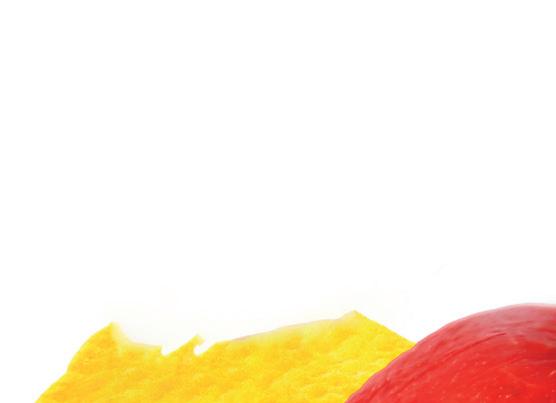
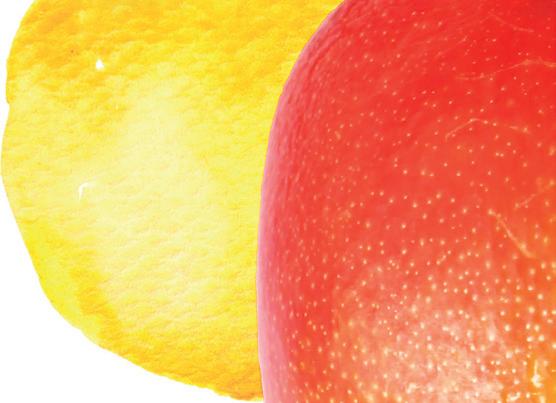
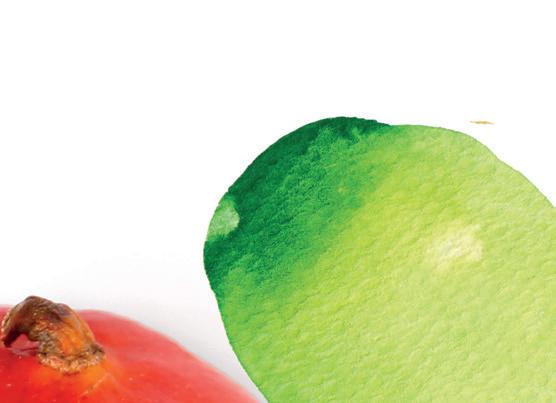





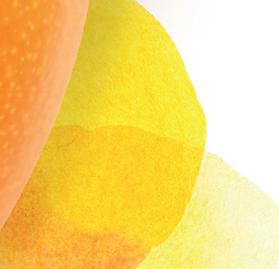



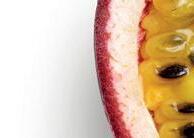


















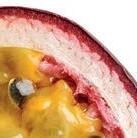




















PUBLISHED BY

South Africa’s sustainable approach to export development sees the leading table grape supplier balance traditional markets with Asian expansion
PRODUCTION
EXPORTS
MARKETING
VARIETIES
LOGISTICS
CERTIFICATION
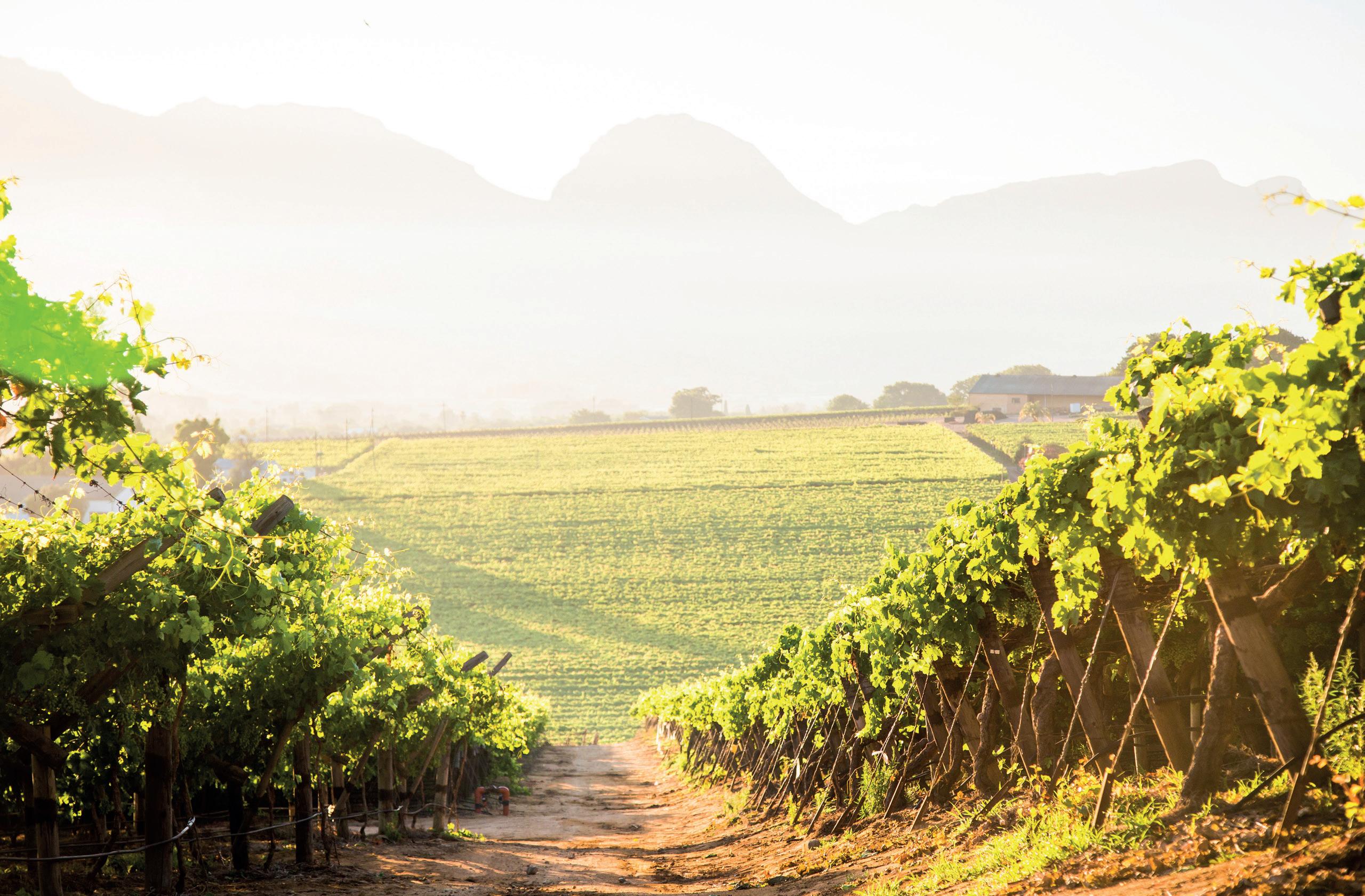
TABLE GRAPES OF OUTSTANDING QUALITY AND TASTE, WHICH ARE RESPONSIBLY GROWN IN SOUTH AFRICA TO MEET THE HIGHEST GLOBAL STANDARDS, START THE JOURNEY FROM THE FOOT OF TABLE MOUNTAIN TO REACH MARKETS AND TABLES AROUND THE WORLD.
Assisting producers to retain, grow and optimise markets is the most important function of the South African Table Grape Industry (SATI), an enabling grower association. SATI represents growers on key government and industry initiatives aimed at creating more opportunities from ownership to accessing new markets in a sustainable way.
SATI assists growers with numerous support services including Industry Information, Transformation, Research, Technical
Market Access, Market Development as well as Training and Development with the objective to establish South Africa as the Preferred Country of Origin for the world’s best tasting grapes.
+27 21 863 0366 info@satgi.co.za | satgi.co.za linkedin.com/company/satgi @sati_sa SOUTH AFRICA – QUALITY ON ROOT
63 Main Road, Paarl | PO Box 2932, Paarl 7620

South African exporters say there are “pots of gold” in Asia. The secret is to deliver the right product at the right time
New opportunities are beckoning for South African table grapes around the world. However, at present, traditional markets are still key for the South African table grape industry. Over the past ten years South Africa has increased the volume of table grapes it exports to its key traditional markets, the UK and EU, in line with the growth seen in the total volume of grapes exported. However, as part of a strategy to diversify its markets, the country has also increased the volume of grape shipments to regions with growth potential. These include the vast consumer markets across Asia including South-East Asia, with much ground already made in China and Vietnam. South Africa now has access to 16 of the world’s top 20 table grape-importing countries and good progress has also been made in gaining access to Korea and the Philippines. As market access to countries across this region grows, new opportunities open up. That is why South African exporters say there are “pots of gold” in Asia. The secret is to deliver the right product at the right time to the trade. However, there are new realities in the global fresh produce trade that will affect all, particularly the changes the geopolitical landscape 2025 looks set to bring. In Fresh Focus South African Table Grapes 2025, we bring you a range of perspectives on this important sector of the South African fresh produce industry. For the rural communities in South Africa, the fortunes of this industry are vitally important in growing the economy and creating work. The people in these regions are proud to bring their produce to consumers in Asia.



After several years of consistent expansion into Asia’s markets, the industry says there are new opportunities.
by Fred Meintjes



The South African table grape industry burst onto the scene in Asia in recent years with expanded market access and market development programmes creating many opportunities.
The country is also producing a range of excellent, new generation varieties which are favoured by consumers and the trade in Asia. And while the trade recognises changes in market supply in these fast-developing markets –with India and China increasing production and supply to other markets in Asia – it has paved the way for a bright future in the region.
South Africa’s table grape season starts in November and normally ends around the end of March. It is particularly its mid- to late growing regions which ship to Asia from mid-January until the season finishes. This year South Africa estimated it would harvest and ship around 75mn cartons (4.5kg) to all export markets, which is the same as in the previous season.
The South African industry says there are several reasons why the trade and consumers in Asia can have confidence in partnering with South Africa as a reliable source of high-quality table grapes.
“Over the past 20 years our industry has made great progress in transforming our cultivar range,” says Leon Viljoen, senior grower from the Hex River. He says growers have spent a great deal of time and money on selecting the best varieties for their regions and can offer only the best.
“South Africa’s position as a preferred supplier to key export markets was once again affirmed in 2024,” says peak industry body SATI (South African Table Grape Industry). “Although we are still selling around 80 per cent of our crop in our traditional markets (the EU and the UK), the quality and food safety standards that we have introduced apply to all our markets.”
SATI says recent development programmes run in China and Vietnam were well received by the market with importers and customers impressed with the quality and taste of the fruit, positioning South Africa as a supplier of quality grapes.
“We can now consolidate our position and ensure that we grow our presence amongst our discerning customers and consumers focused on quality products,” SATI says.
“Behind all this is an industry which for many generations has been committed to the art
LEFT—Growers must balance productivity, cost management and quality as costs rise
of growing quality table grapes. All this is done by dedicated people on the farms and in the logistics chains that ensure a reliability of supply.”
South Africa, at the foot of Africa, is located in the ideal position to supply markets of Asia and Europe. The country’s major shipping port for table grapes is Cape Town but also uses ports on the country’s south and east coasts to connect specifically with services to Asia.
“After some years of introducing our grapes to the Chinese trade and consumers we believe the South African brand is now well positioned in the market,” SATI says.
Work to gain access to more markets in Asia is ongoing and the industry is progressing negotiations with Korea and the Philippines.
“These negotiations sometimes take time, but it is important that we set up protocols correctly before moving forward,” SATI notes.
In line with global trends, one of the challenges for the industry is above inflation cost increases.
“As input costs continue to rise, farmers face increasing pressure to remain competitive. To build resilience, stay competitive, and ensure long-term viability, producers continue to prioritise productivity, prudent cost management, sustainability, and quality. As a result, the South African table grape industry remains well positioned as a preferred supplier of quality produce in various markets,” SATI says.
“Dealing with environmental issues and the effect of climate change is also challenging. Farmers have adapted to changing conditions by implementing production practices suitable to the growing conditions in their regions to improve resilience. As an industry body we can support them through targeted research activities.”
Smoother export operations are also a priority and SATI has commissioned the development of a prescriptive logistics model to optimise its export supply chain. The model, developed in partnership with Transnova Africa, uses data analytics to identify the most efficient routes to market, taking into account various factors such as transportation costs, transit times, and product quality.
The purpose of the prescriptive logistics model is to support the industry's competitiveness in the global market through its value as a decision-making tool with the aim of optimising logistical solutions and reducing costs.
This all augurs well for the development of the South African business across markets of Asia.


The South African table grape industry is prioritising market retention and development, says SATI chief executive Mecia Petersen.
by Fred Meintjes
In an increasingly competitive global environment, one of SATI’s key priorities is to maintain the relationship with the long-existing markets in the EU and UK. SATI is paying equal attention to expanding South
Africa’s presence in markets where an opportunity to develop or grow existing market share has been identified.
“We currently enjoy access to 16 of the world's top 20 table grape importing countries, and we are
committed to continuing to supply these markets with consistent, quality product,” says SATI chief executive Mecia Petersen.
“We strive to preserve our market leadership in the UK and EU. These markets account for nearly 80 per cent of our volumes, and we recognise the importance of continuing to supply our customers in these regions with consistent, high-quality product,” says Petersen.
To achieve this, and to uphold South Africa’s reputation as a reliable quality supplier, the industry is working closely with value-chain partners including government, exporters, and other logistics partners to optimise routes to market and improve delivery times.
“This includes the use of a digital prescriptive logistics model, developed in partnership with Transnova Africa, which helps us identify optimal routes and drive future improvements,” Petersen notes.
Alongside market retention, Petersen says market development is equally important.
“We are currently exploring opportunities to expand our exports to new and growing markets, including South-East Asia and North America. The US and Canada combined currently account for around 8 per cent of our total exports and producers are enthusiastic about the opportunities these markets present,” she says.
In addition to North America, the industry is exploring opportunities to expand exports to Asia
“Negotiations to access the Philippines and Korea are at an advanced stage, and we are optimistic about the potential for growth in this market.”
To establish a market presence for South African table grapes in China, the industry, in partnership with the Western Cape Department of Agriculture, ran a targeted campaign in China for four seasons from 2021 until 2024.
The market responded positively - importers and customers were impressed with the quality and taste of the fruit.
“While global market dynamics continue to evolve rapidly in certain markets, such as China, where increased domestic production has reduced demand for imported fruit, we remain optimistic about the potential for growth in this region,” says Petersen.
“Last year the Chinese trade promotion campaign expanded to include Vietnam, where we see an opportunity for South African grapes.
“By strengthening our partnerships, diversifying our markets, and maintaining the quality product South Africa is synonymous with, we are confident that our table grape industry will continue to thrive in the years to come.”


Alwyn Dippenaar, new SATI chairman, walks in the footsteps of a long tradition of grape farming in South Africa’s remote Orange River region.
by Fred Meintjes
In the mid-1980s reaching Blouputs in the Lower Orange River region, a desert-like part of South Africa bordering Namibia, was quite an ordeal. When you turned off the main road from Augrabies to Pofadder, and headed down to the river, you had to open many farm gates.
For unsuspecting supermarket buyers who visited farms, one leading grower had the practice of letting the visitors open the gates, and once they drove through, pretended to forget them in the desolate near-desert landscape.
Today a tarred road provides access and Blouputs has cemented its position in the world of table grape production. It is also home to the Dippenaar Group, which was founded by Paul and Neeltjie Dippenaar and has grown into one of the leading grape growing groups in the country during the past 30 years.
The original farm was Gamcaip, which is a Khoisan meaning the ‘Fountain in the Stream’. There is in fact a hot water fountain in the middle of the stream and during
times when the river level drops to low levels, one can see it bubbling under the river.
The group currently has 329ha in production and plans for considerable further expansion soon. It has also invested considerably in infrastructure and today the farms have modern packhouses with state-of-the-art pre-pack facilities.
Alwyn Dippenaar is one of three sons of Paul and Neeltjie Dippenaar and has helped build up the group’s marketing division Dippenaar Choice Fruit. From 2025 he will also take on a greater role in the industry as the newly appointed SATI chairman.
Alwyn Dippenaar says his term is the continuation of the work done by the previous chairman and the SATI board.
“There are many important projects which we as a board and the industry have been working on for some time and they will continue. I am also excited that we have such a dynamic SATI team, led by the exuberance of youth coupled with experienced staffers,
who will lead us forward,” says Alwyn Dippenaar.
There are, however, several very important focus areas that are particularly relevant as the industry enters 2025.
Alwyn Dippenaar refers to SATI’s focus on logistics and the role the new model will play in stabilising logistics operations.
“We cannot solve these problems ourselves, but the information that we will derive from this model will be crucial to assist all role-players to contribute,” he says.
ABOVE—Dippenaar’s head office is located in the Lower Orange River
BELOW—Alwyn Dippenaar is the new SATI chairman


Changes to production in China, India and the US could affect world markets.
by Fred Meintjes
“The ideal sales window for South African table grapes to the US is from January to mid-February when South Africa can fill some of the gaps in supply from Chile and Peru,” Swart outlines.
“The latest retail trends in the US show that, with the introduction of new white seedless varieties, sales have shifted from 50 per cent white seedless and 50 per cent red seedless, to 75 per cent white seedless, 25 per cent red seedless, and 5 per cent black seedless.”
In South Africa red seedless has dominated for some time, but recent years have seen the white

Changes in supply, as well as within table grape categories themselves, will affect the future development of markets in Asia and the US for South African exporters.
Riaan Swart, grape champion for EMEA at Dole, says for South African table grape industry, one of the trends shaping the market is so-called disruptors in Asia, most notably driven by influences from China and India.
Swart points out that China is gaining prominence as a table grape producer.
“The country has increasingly become a net exporter of grapes over the last three to four years and is still growing with their season now spanning from April to November,” he says.
“The increase in production
also has implications for the opportunity China represents as an export destination for South Africa and other Southern Hemisphere producers.
“Due to factors such as increased domestic production, it is likely that China will feature as a niche export market rather than a big volume market,” he continues.
The introduction of newer varieties has resulted in some changes to the length and nature of India’s production season, with the peak of production now forecast for February onwards.
Exports from India to the EU are expected to start peaking from Week 10 onwards, competing with shipments from South Africa.
Changes in categories of grapes could also affect prospects for South Africa in that market.
seedless category grow significantly as new varieties have entered the market.
ABOVE—South African grapes may have to contend with Chinese domestic production in the coming years
BELOW—The white seedless grape category continues to grow
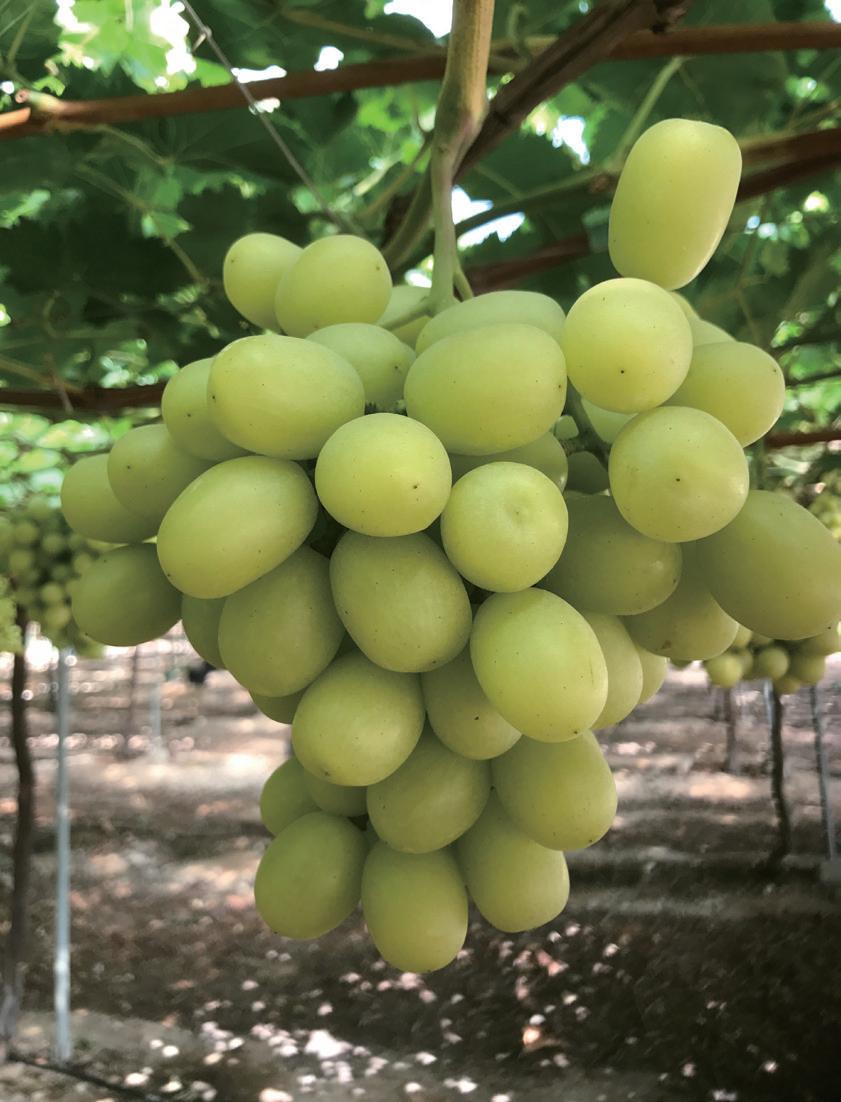

South African growers among the fastest in the world to invest in new licenced and branded varieties.
by Fred Meintjes
South African grape growing is a multi-generation game, with foundations that were laid in the previous century resulting in fourth and fifth generations continuing these highly successful businesses.
With this strong legacy fuelling them, the newest generations are embracing growing practices to sustain their businesses for generations to come – and they are amongst the fastest in the world to plant new licensed and branded varieties. This has in recent times fundamentally changed their businesses.
Having the best varieties in your product range is easier said than done. The world’s leading grape breeders are bringing forth many very promising white, red and black varieties, but it is up to grape growers to evaluate them and introduce them on their farms.
Leon Viljoen, a table grape grower from De Vlei one of the oldest table grapes farms in the Hex River Valley, is a good example – this year he celebrates 55 years in the South African table grape business. At the same time, he is also celebrating a journey of close cooperation with the IFG plant breeding programme, which is now owned by Bloom Fresh.
“We have lived with the vines from and early stage and learned from those before us,” says Viljoen.
diverse climatic regions to be the best,” he concludes. Today Sweet Celebration and Sweet Globe are amongst the top five varieties exported from South Africa. Viljoen, however, states the importance for grape growers to consider all breeding programmes.
Throughout South Africa, there are at any time up to 50 new varieties on offer – mostly from the Arra, Sun World and Bloom Fresh breeding programmes.

“But these days one has to be much more agile to stay in the game and we need to explore all opportunities that come our way.”
Viljoen’s long search for the best varieties has taken him around the world. He became the first in South Africa to plant such celebrated IFG varieties as Sweet Celebration, Sweet Globe, Sweet Joy, Cotton Candy, Candy Hearts, Sweet Sapphire, Sweet Nectar and Candy Snaps.
“In the end we are as good as the products we offer our customers and their consumers – and we must utilise the best resources and the best of our
SATI’s latest vine census indicated that the total table grape hectares has decreased somewhat as growers move to newer varieties.
Five varieties now account for half (50 per cent) of the total hectares planted, namely: Crimson Seedless, AutumnCrisp, Sweet Globe, Sweet Celebration and Prime Seedless.
Autumncrisp has emerged as the leading late South African white grape. Crimson Seedless remains a strong variety in the South African offer to eastern markets, with the late Hex River Valley growing region excelling as a high-quality producer of this late red seedless.
In recent times the Arra range has also produced exciting new red and white varieties, with Fire Crunch making a big impact in the earlier growing areas this year. Sun World has also introduced a range of early season varieties.

South Africa sits at the crossroads of world shipping lanes – but serving continents in both the east and the west is a formidable task.
by Fred Meintjes
In recent times dealing with South African ports has been tough. However, with logistics taking centre stage nationally, the situation seems to have turned around this season with international markets soon to see the benefits.
In support of South Africa’s strong table grape export industry, SATI has been coordinating shipping logistics and assisting growers and exporters to pick the best logistics options.
This increased focus on effective transport and shipping logistics has been crucial for maintaining successful fresh produce handling across the notoriously difficult and long supply line to Asian markets.
Traditionally, South Africa has had strong and consistent shipping routes to Europe which have
been developed over more than a century of exports. But with growing markets for South African grapes in Asia, logistics routes have expanded. Exporters now use Cape Town and Eastern Cape ports to connect to Asian markets. In some cases, shipping routes via the Middle East are also used, with extraordinary transit systems used to keep the grapes in perfect condition during shipment.
Very recently, South African ports company, Transnet, has reported improvement in efficiencies and no doubt SATI’s

LEFT—South African table grape exporters now use Cape Town and Eastern Cape ports
logistics models are also helping to more effectively put fruit through the ports.
Supply routes to Asia are, however, long and expensive. In order to withstand the shipping times, South African growing practices are geared to grow the best grapes and then maintain quality all the way to the market. Growers must also comply with strict phytosanitary regulations, and this has to be taken into account when products are packed and sent to Asian markets.
Unlike the case with citrus fruit, where conventional reefer vessels are also used to supply Asia, South African table grapes are shipped entirely in reefer containers, which in many instances are taken straight to markets where they are often opened for the first time since leaving the packhouse.
Exporters know that once they load the fruit in the container, the cold chains must be maintained until the fruit arrives in the market to ensure the best quality product on arrival.




South Africa’s food standards organisation, PPECB, looks to add more value to the country’s export chain amid expanded access to Asian markets.
by Fred Meintjes
As South Africa grows its markets in Asia, the country’s export standards organisation, Perishable Products Export Control Board (PPECB), says management of new protocol requirements requires special attention.
The original mandate of the PPECB was to “oversee the export of perishable produce”. In recent years, and since deregulation of »
BELOW—PPCEB inspectors conduct onsite inspections
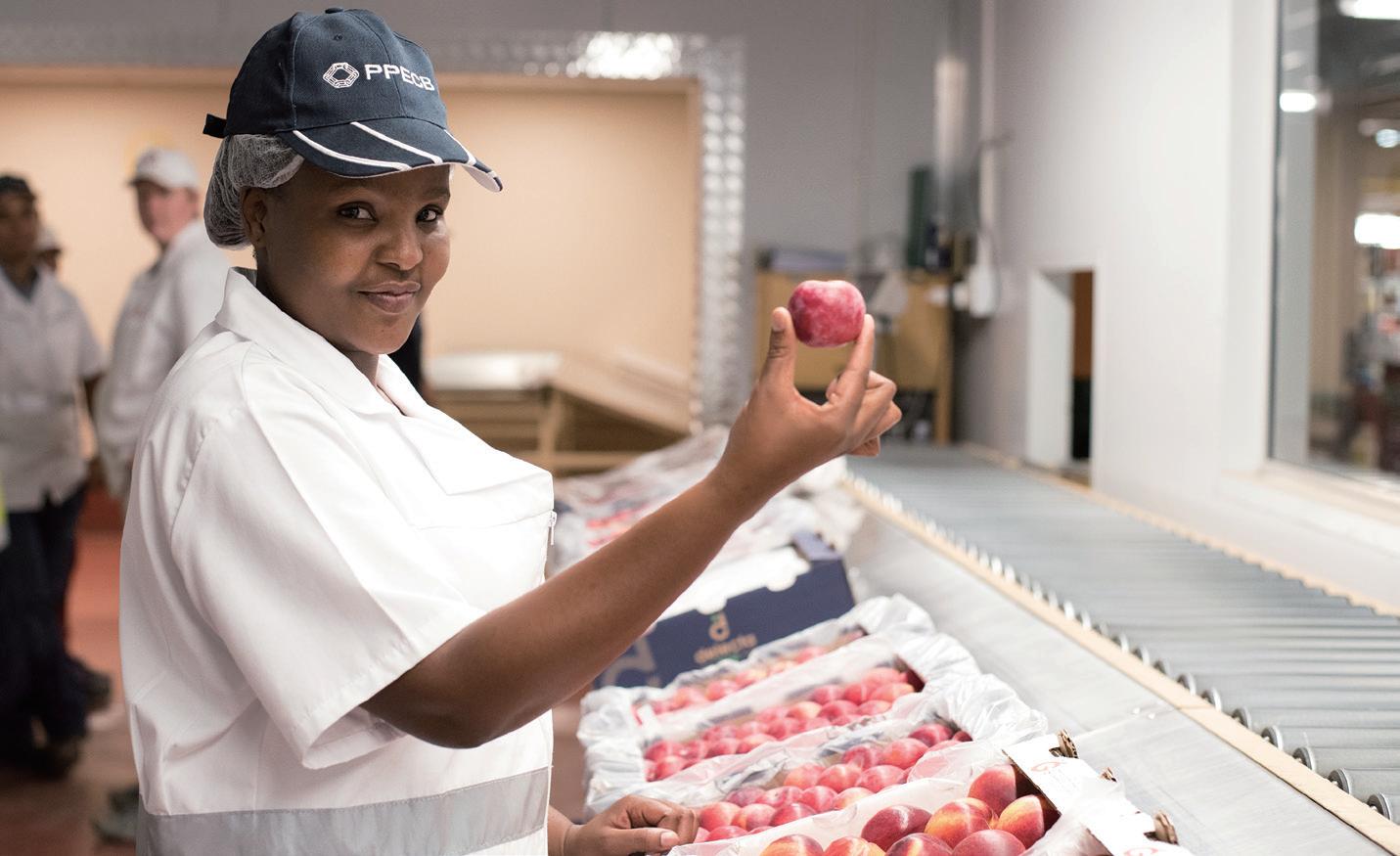

Our passion for excellence helps you grow your business and establish yourself as a preferred supplier of perishable products.




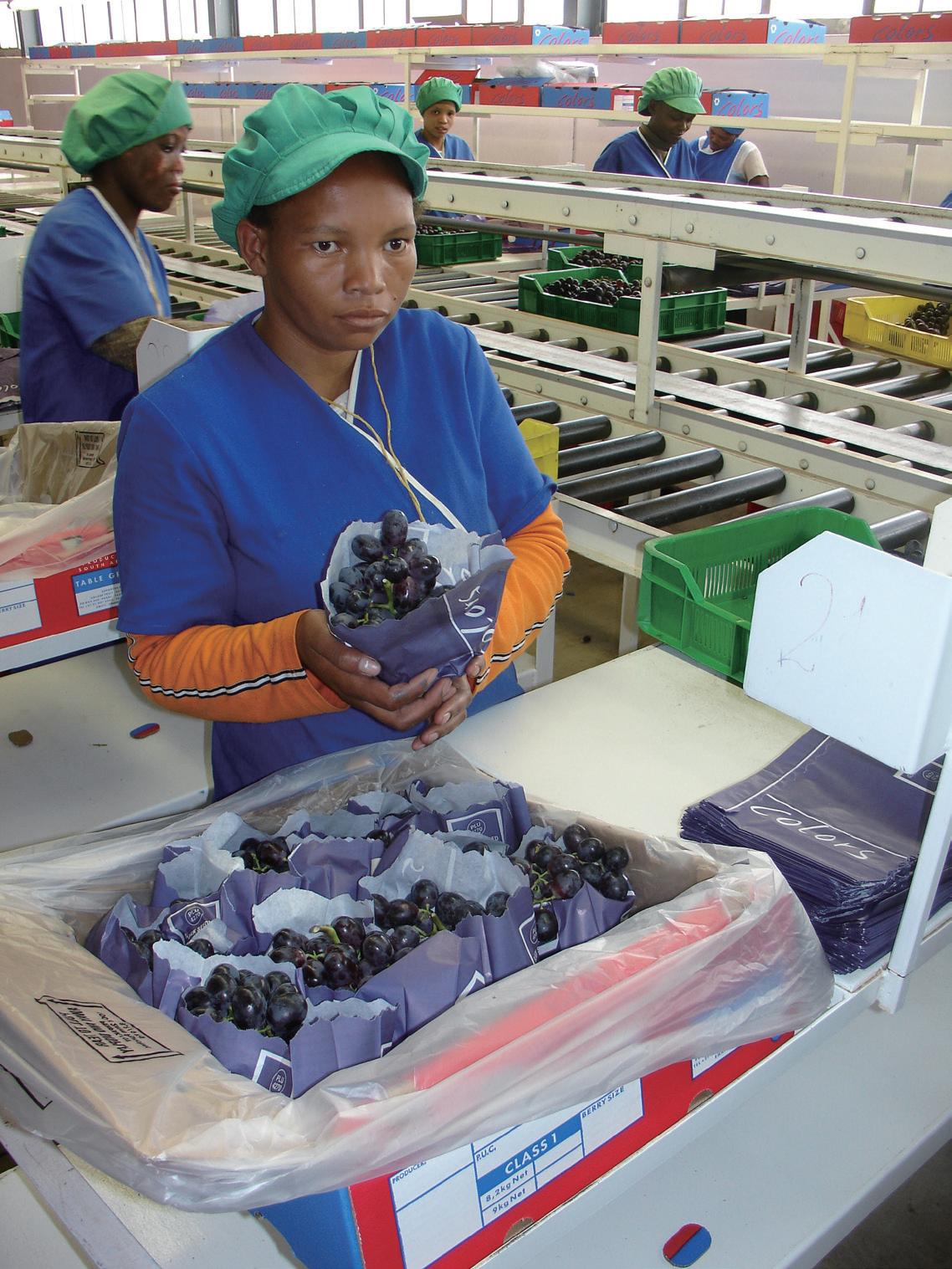
the South African fresh produce business, this role has changed significantly.
“Apart from being a regulator, the PPECB wants to add more value in terms of the role it plays within the export value chain,” says Lucien Jansen, chief executive of the PPECB.
In South Africa, the PPECB conducts integrated inspection of cold chain services, that includes but is not limited to aspects of phytosanitary compliance, food safety, product quality, equipment certification and temperature management.
“The PPECB’s stamp of approval, which is fixed on cartons and pallets approved for export, is also globally renowned and synonymous with product quality and consistency,” says Jansen. “In a market that is highly competitive,
we believe that the PPECB’s stamp of approval is more important than ever before.”
He says the PPECB has adapted greatly to industry trends over the past years and invested significantly in technology and ICT infrastructure.
“In addition to the traditional quality and phytosanitary inspections, food safety, and cold chain services, information provision has become a major focus area,” Jansen explains.
Further to this, Jansen says the PPECB’s analytical laboratory in Pretoria has expanded its service offering to cater for the growing industry needs.
“The organisation’s major objectives of client satisfaction and service efficiency remain top of mind and a main driver of the PPECB’s organisational culture,” he adds.
The PPECB plays a key role in monitoring and managing compliance in the logistics chain and while recent logistical problems in the ports have challenged the organisation’s agility, this is looking to turn around.
“The national port operations in South Africa have significantly improved this year,” Jansen says.
South Africa has in recent years gained access to new markets in Asia. This is governed by strict protocols which require special focus on logistics operations. This is implemented under the authority of the South African National Department of Agriculture and PPECB plays a key role in compliance.


South African grape exporters admit the optimism about major Asian markets has faded somewhat, but with a targeted approach there is still some hope.
by Fred Meintjes

After years of focusing on Asia to grow their grape export programmes, and reduce dependence on traditional markets, South Africa’s table grape exporters say they are now more realistic about long-term prospects.
grow from there”.
However, exporters, say traditional markets in Europe and the UK will for some time still be the most important destinations for South African grapes.
The question is then – what is happening to South Africa’s table grape export drive into Asia?
The answer is simple: increased competition.
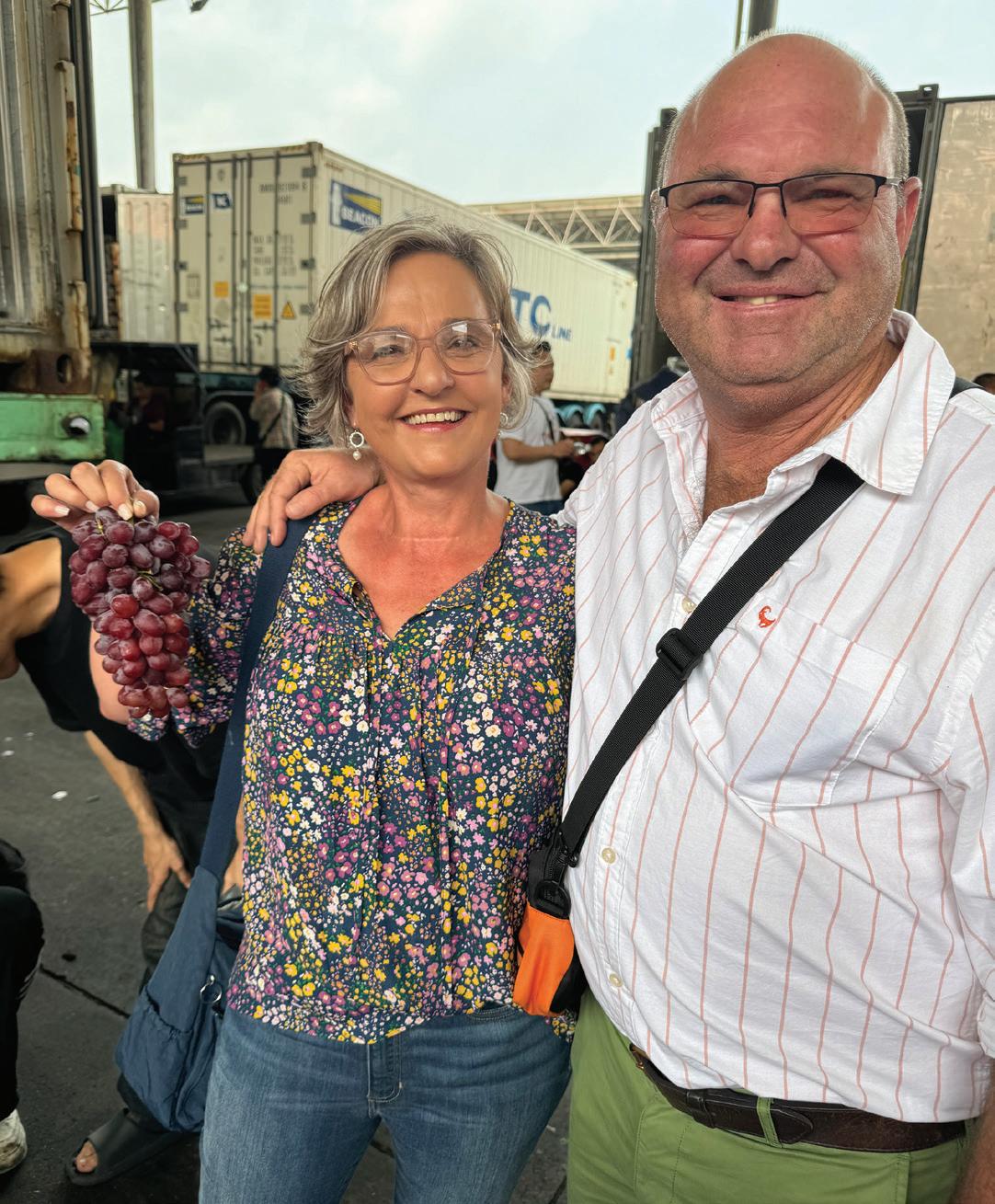
for fruit exports, JJ van der Spuy says the Chinese market has become much more competitive than five years ago, with large production of Shine Muscat being on the market between April and December.
“This is a large-berried crispy white grape,” van der Spuy explains. “Compared with apples and pears, citrus and perhaps avocados, table grapes from South Africa have a more difficult market.”
Alongside the increased production of grapes from China and other sources across Asia, Chilean cherries are increasingly flooding the market at low margins during their season.
And yet, exporters still argue that greater access and market development is essential.
“Four years of promoting our products in markets such as China has certainly done a lot to establish our grapes in discerning markets,” a leading exporter says, “and we can »
Core Fruit commercial manager
“There are still pockets of gold in these markets and advances in market access will certainly give us

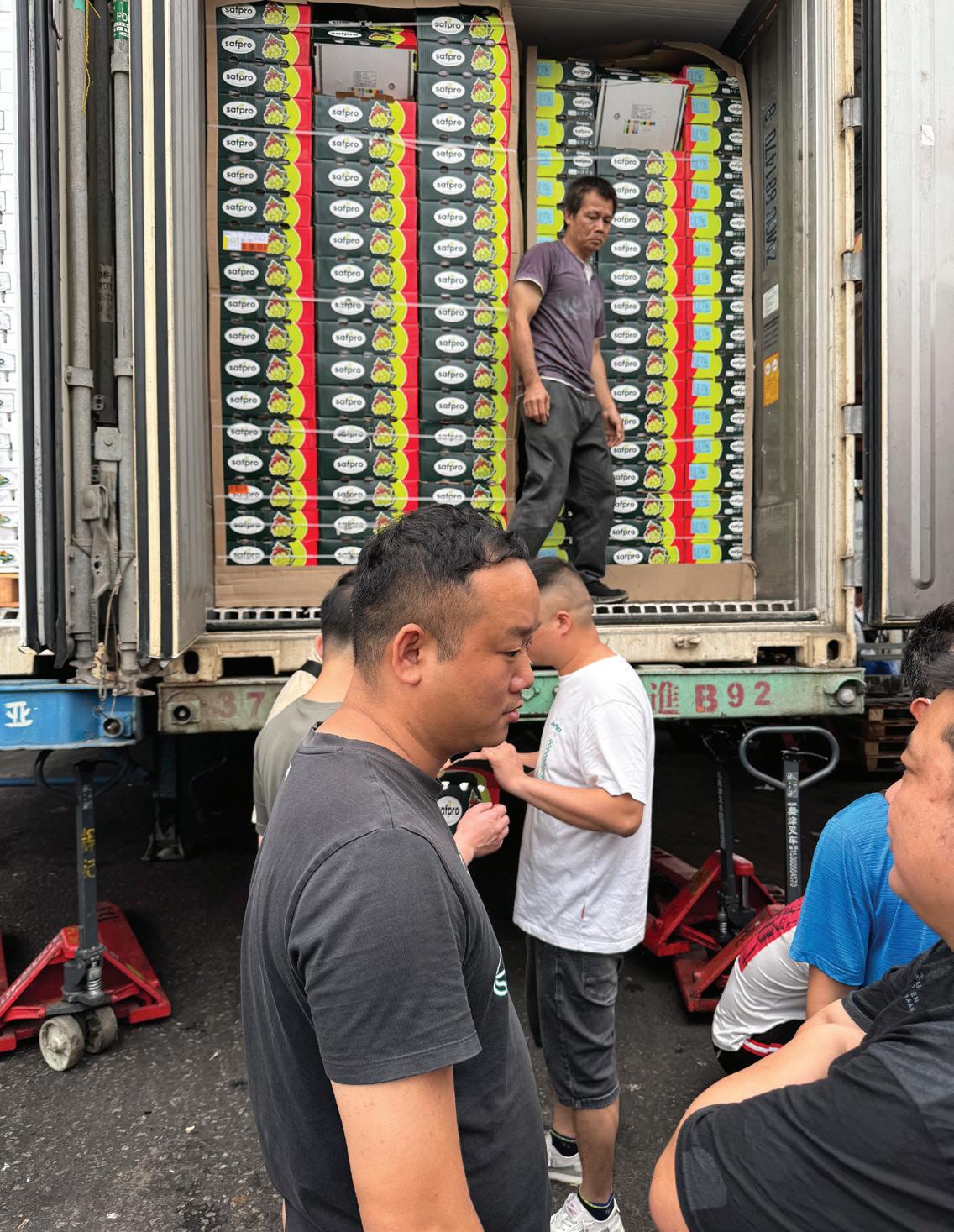
more opportunities,” van der Spuy says. “We just need to offer the best product at the right time.”
Enslin Perold of South African exporter Safpro, who has been exporting table grapes to China for over 20 years, says China and the broader Asian regions are incredibly challenging markets for South African grape growers.
“However, [it’s] a very financially rewarding market,” he adds.
If South Africa would like to develop into South and East Asia, Perold says the country desperately needs market access into countries such as Korea and Thailand as well as expanded access to Japan.
Currently, South African grapes are in fact allowed into Japan, but only the Barlinka variety, which is no longer grown.
Nico Louw, head of marketing at table grape exporter Exsa, says his company exports to Malaysia, Vietnam, Indonesia, Singapore and
China with some success, although exports to China have declined.
“There are vast differences in price levels in Malaysia and it seems there is a new tender price every week,” Louw says. “Vietnam
LEFT—South African table grape growers must export the highest quality fruit to withstand the long journey to Asia BELOW—SATI has run a number of promotions in China including free tastings
remains a good market for us and good quality is rewarded.”
In general, Asia’s market expectations are incredibly high for table grapes and other fruit. According to Perold, Chinese expectations of the grapes they receive must be large size berries (XXL and XXXL), hard and crunchy, high-Brix, full-colour, and have a full bloom.
“We do understand that only the best varieties are preferred, and South Africa can never consider selling an inferior product to China,” he says. “They must have green stems otherwise the perception is that of an old product.”
Perold says as far as China is concerned there are only three varieties – Crimson Seedless (as long as they are pink), Sweet Globe, and AutumnCrisp – which are favoured. To a lesser extent, Sweet Joy, a black seedless variety, is accepted.
“There are very specific requirements for all these varieties, and if exporters cannot comply, they must not export them,” he says. “We have had some very good results and some poor results due to the fact that we did not send what the market demands.”
Exsa says there is also a demand for specialty products such as Cotton Candy, Candy Hearts and the unusually shaped Sweet Sapphire.
All exporters agree that the honeymoon period which followed the opening of the Chinese market is well and truly over. The future will belong to those who can meet the requirements of these markets.
























Asiafruit






Strong international demand alongside expanded access to Japan and a five-year marketing programme into Asia have Australia primed for increased export growth.
by Bree Caggiati
Australia’s table grape season is off to a strong start with high quality fruit and significant demand from export markets, according to Australian Table Grape Association (ATGA) chief executive, Jeff Scott.
“The season has been going really well so far,” Scott says. "We knew we were going to have a large crop [this season], and it has been living up to that expectation”
Hot weather in the Sunraysia growing region has brought much of the harvest schedule forward, but Scott says well-timed rain has kept quality high.
“We’ve got a lot of fruit out there and it is of very high quality,” he says. “It's created a lot of excitement from importers wanting to buy our fruit and we're in huge demand which is great.”
This positive start follows an early finish to the 2023/24 season that saw exports decline 19 per cent to 135,000 tonnes. But with exports 22 per cent higher than the same time last year as of mid-February, and »


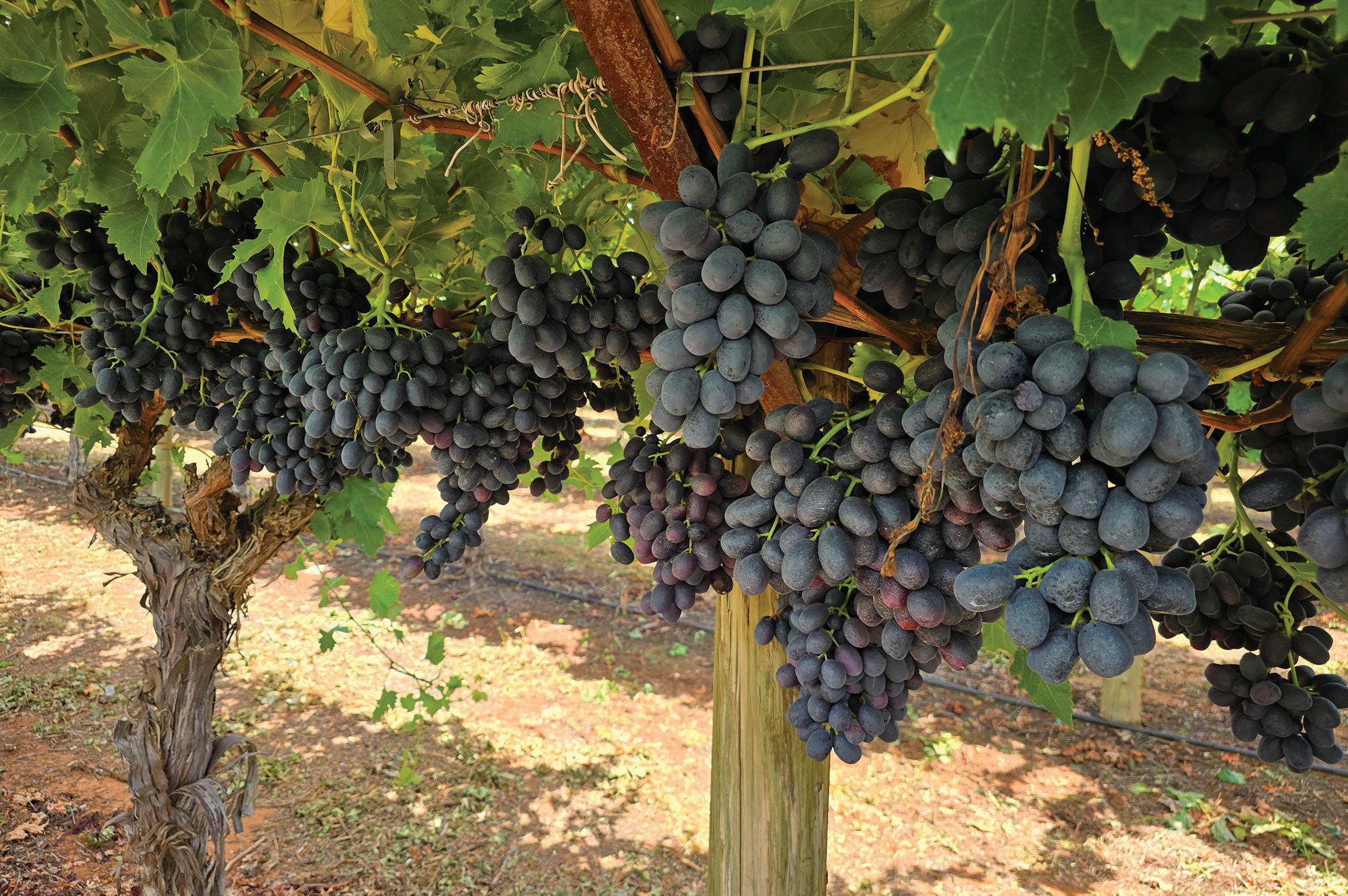
supply expected to hold out until June, Fresh Intelligence’s Wayne Prowse anticipates total export volumes could exceed the record 150,000-tonne level reached in 2020.
This is welcome news for an industry whose growth trajectory was significantly disrupted by the impact of Covid-19.
Australia saw rapid growth from 2010 to 2020 but with labour shortages and increased input and shipping costs following the pandemic, production diminished. Unfavourable weather conditions in the following years affected this
further.
But with all signs pointing to increased production and a high-quality offering this season, Australia could very well see a return to its pre-Covid form.
For Sunraysia-based growerexporter Perfection Fresh, this could certainly be the case.
"The season started very early with good volumes on the vine, and this might be to the industry's advantage as it could help us get through the whole season and move the entire crop whether that be in domestic or export markets

LEFT—This season has produced high-quality fruit for Australia
BELOW—Harvest schedules were brought forward due to hot weather in Australia’s Sunraysia region
OPPOSITE—ATGA
CEO Jeff Scott (right) at the in-bound trade mission
because we won't get into market too late,” says Perfection Fresh account manager, Mark Cavallo.
"As of the end of January, we were starting to get traction on exports. We've had Japanese visitors out to see all the new varieties and all other Asian markets are looking good for a strong season."
Global fresh produce distributor, Valleyfresh, has also seen increased interest from Japan.
“We are seeing a lot of Japanese visitors planning one or two visits for this coming season,” says Valleyfresh director, Ryan Smith. “They have a real interest in learning about the new Australian grapes varieties that are now on offer for their market.”
This increased interest comes after the Australian government secured an expanded access agreement with Japan in July last year. Under the new deal, Australia can now send more than 130 table grape varieties to Japan – a massive increase on the previously approved total of three varieties.
In a statement at the time Scott said the deal had been a long time in the making.
“Interest for Australian table grapes in Japan has increased steadily over the past ten years since technical market access was granted in 2014,” he said. “However, our export market value has been limited by the varietal restrictions in place.”
As the export season begins, Scott says the new access offers the industry a “great benefit”.
“Japan’s importers and consumers are really looking forward to being able to purchase all of the different varieties that Australia grows,” he says.
Cavallo adds that Perfection Fresh is “working closely with the Japanese market to unlock the potential for our Australian grown table grape varieties”.
“We’ve had a lot of success previously with the Japanese market. Their consumers value high-quality Australian fruit,” Cavallo says. “But as other countries started flooding the market and sending IP varieties, Japan deprioritised Australia. We’re hoping from the discussions we’ve had with buyers and the confidence we’ve seen in our product that can regain some of that lost share and supply Japanese consumers quality varieties grown in Australia.”
The spotlight on Japan comes amid an ATGA-led marketing programme aimed at elevating the Australian table grapes brand in international markets.
While Scott says the five-year
programme is still in planning stages, ATGA has already hosted trade seminars in five countries throughout Asia and facilitated an out-bound trade mission to Japan as part of the campaign.
“We took 15 grower-exporters over to meet all the key Japanese importers and retailers,” he says. “That was a huge success.”
There was also a recent in-bound trade mission spotlighting the Sunraysia region.
“We had about 40 importers from about seven countries,” Scott says. “We gave them demonstrations of our growing practices and they were able to taste the new varieties that we have on offer.”
Future elements of the campaign include in-store activations in retailers across Asia.
South-East Asia continues to be a dominant export region for Australian table grapes, with

Indonesia, Vietnam and Thailand part of the top five importers alongside China and Korea.
“We tend to target Japan and the South-East Asian markets along with Middle East,” Smith says. “The Australian grape varieties are always in demand due to the very high Brix levels and superior taste profile. Even though some of the prices can be high compared to other grape supply countries, we always have good demand for Australian fruit in general.” A
Australia’s Sunraysia-region was in the spotlight as part of a key trade initiative to connect industry with buyers, retailers, and importers from leading Asian markets.
The five-day initiative from 10-14 February was part of Global Victoria’s Horticulture In-bound Trade Mission, designed to foster international trade connections.
In addition to site visits and learning opportunities, the Australian Table Grape Association (ATGA) and Citrus Australia hosted a networking event aboard the PV Mundoo, which provided the opportunity for growers and exporters to connect with 40 Asian buyers, while showcasing the Murray River.
The ATGA said the initiative provided an excellent platform to strengthen ties with key international markets and further elevate Sunraysia’s reputation as a leading exporter of premium table grapes.
The mission made up part of the table grapes market access and trade development project and was funded by Hort Innovation using table grape and citrus research and development levies and contributions from the Australian government.

Sunraysia field day showcases Arra Fire Crunch variety to Australian growers for the first time.
by Bree Caggiati & Liam O’Callaghan
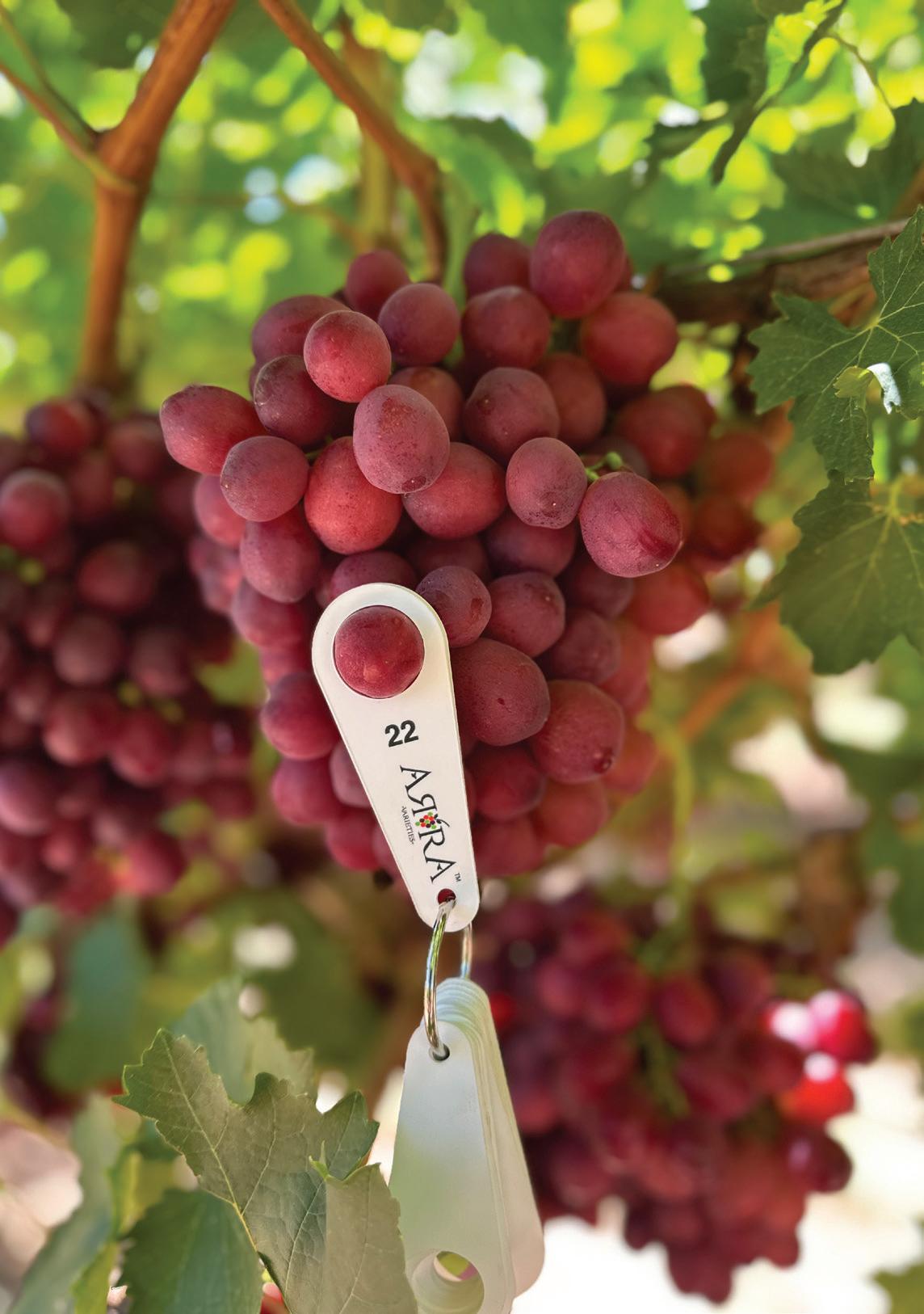
It's been over a decade since the first Arra varieties were planted in Australia. Now, the global breeder partners with over ten licensed marketers across the country, growing in all states bar the Northern Territory and Tasmania.
“Arra varieties are well-regarded for their genetic resilience to
rain and extreme heat, which is crucial in Australia’s unpredictable climate,” says Arra Australia manager, Stephan Nel.
A good example of this resilience is the Arra Sweeties variety which is primarily grown in Far North Queensland and harvested during Australia's offseason.
“This variety thrives in challenging conditions, making it possible to supply fresh, locally grown grapes to the domestic market at a time when table grapes are typically imported,” says Nel.
This year will see the Arra Australia range expand even further with two additional red varieties –Arra Fire Crunch and Arra Cherry Crush – nearing commercial volumes.
To showcase this expansion, Grapa Varieties held its first Australian Arra Fire Crunch field day on 24 January 2025 with more than 80 table grape growers and industry representatives in attendance. The group gathered at Alpha Fresh Australia, one of Australia’s largest Arra growers and marketers, to get a first-hand look at the vibrant red Arra variety.
“While growers appreciated the colour and crop load, what truly stood out for many, was the exceptional crunch of the berries, a quality perfectly fitting for a variety named Arra Fire Crunch,” Nel says of the event. “Attendees expressed amazement at the crisp texture, with some even declaring it the crispest red grape they had ever eaten.”
These field days exemplify Grapa’s commitment to introducing innovative varieties and supporting growers with the tools to succeed in local and export markets.
“Arra Fire Crunch’s texture contributes to its impressive hanging ability on the vine, while its strong cold storage capability ensures it is perfect for export markets,” Nel says. “The future looks bright for this exciting new red variety.”
Additionally, Nel says Grapa is excited for two varieties newly released from quarantine: Arra Fire Kiss, a very early red seedless, and Arra Mystic Charm, a very early black seedless.
“These varieties, along with Arra Honey Pop, form the world’s earliest trio of white, red, and black seedless grapes,” Nel says.
They also boast short production cycles which can both help support economic efficiency and promote sustainability by reducing labour, irrigation, and pesticide needs.
“All these newbies to Australia, are already delivering impressive results worldwide and driving market demand,” Nel says. “We are therefore eagerly following their performance in Australia.” A






















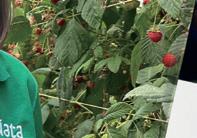












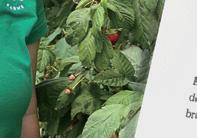


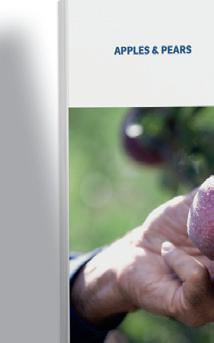
































































Digital





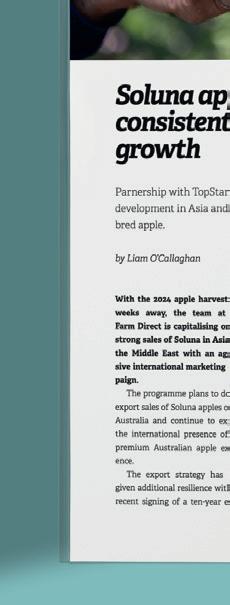


























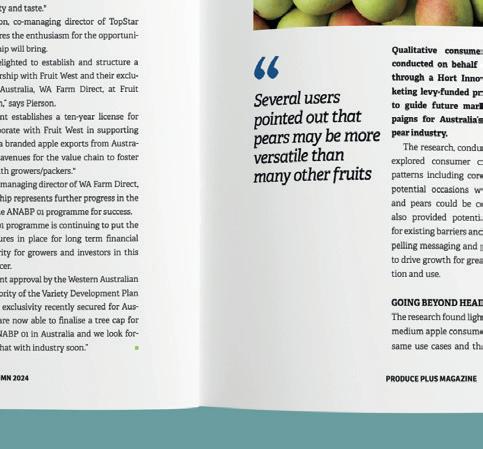




























Monthly Produce Plus newsletter















All the benefits of print & digital
Bespoke packages available for your team or company
Volume discounts for 3+ subscribers
Personalised account management
Shift from public to proprietary varieties supported by table grape breeder as it sets out to expand its footprint.
by Liam O’Callaghan

Change is a familiar feeling in the Australian table grape industry at the moment as new proprietary varieties take an increasing share of the market.
For Bloom Fresh, change has also come in the form of merging the operations of the old IFG and SNFL breeding programmes and teams. Bloom Fresh’s Rachael McClintock says the process is now complete in Australia and the breeder can now turn its attention to growth.
“In Australia table grapes is our largest portfolio but we’re also starting to diversify. We’re doing a lot of evaluation of new cherry varieties and importing some new blueberry varieties,” she says.
“Now that we're fully united, we're building our personnel on the ground and starting to really focus on the technical support we can provide for growers.
“We’re in a world where production costs are rising, if growers are to invest in a variety they want the technical support to make it a success.”
The decision to move to new proprietary varieties is one many Australian growers are making at the moment, according to McClintock.
“The key change in the Australian industry is the diversification away from Crimson and Thompson. A lot of the old public varieties are being reviewed for timing, yield, quality and ease of growing. I’d say by 2026 there will
BELOW—Bloom Fresh is expanding its team in Australia to help growers
be a clear change and the majority of table grape production will be proprietary,” explains McClintock.
Bloom Fresh is servicing this transition with varieties that meet the varying needs of growers.
“We have a test block here and we’re doing a lot of R&D. We’re working on some of our new Navsel and Genesis collections that have been bred out of Spain and we do a lot of evaluations and rootstock trials,” notes McClintock.
“A key demand is the early window, which comes back to competition in markets like China. There’s also demand for ultraearly and mid-season windows and varieties with flavour and good fertility that colour naturally.
“We also have a couple of selections that are disease resistant, which will be ideal for organic production but also for Far North Queensland where you’ve got high humidity. We’ve also got some exotic, high-flavour varieties coming through.”
Growers have to meet consumers’ tastes and in Asia, McClintock says, there are high expectations from the market.
“In Asia, flavour and sugar are important. You want your variety to be firm, crisp and crunchy with good texture,” she says.
“But sweetness is really key and that’s where, from a Bloom Fresh point of view, quality assurance plays a critical role in that preharvest period.” A
Leading fruit breeder aims to maintain growth trajectory for the table grape category with new partners.
by Liam O’Callaghan
Towards the end of 2024 Sun World International announced a raft of new table grape licences around the globe including a number of Australian growers and marketers
As this group embarks on its first season under the new agreements Sun World licensing manager Australia, Adam Knoll, says Australia remains a crucial supply region the breeder is committed to investing in.
“Our growth in Australia is broadly consistent with what we’re doing around the world in that we’ve got genetics and brands that are in demand and we’ve got to expand to put that into the marketplace,” says Knoll.
“Autumncrisp is certainly becoming more and more known as a consumer brand in Australia and Asia, and the Midnight Beauty brand is performing strongly as well.
“Our growth is strategically planned to meet demand and we understand that not every licenced marketer can meet every customer’s needs or want to deal with every customer. To meet the market requirement, we need to expand.”
Australia has a well-established domestic and export table grape trade, and Sun World is cognisant of meeting both needs.
“Australia’s interesting because we’ve such a strong domestic market that’s taking around half of production volume from a Sun World perspective. We see that increasing as we add more routes to market with more licensees who can supply the domestic chains, and there is also opportunity for export expansion,” says Knoll.
Knoll says the flow of Australian fruit continues to

BELOW—The Autumncrisp global marketing campaing is driving value
evolve and Australia’s opportunity in Asia remains strong.
“Market access in Japan appears like it’s going to give a kick to proprietary genetics now that the public space has competition. That’s a real positive,” says Knoll.
“There are countries from a Sun World perspective, like China which are relatively untapped. We do see fruit from other global suppliers but in terms of Australia, it’s a little more reserved. We are also struggling to meet demand in other areas of Asia where Australia has a strong presence such as Korea, Vietnam and Thailand.”
Australia’s increasing supply will play an important role in Sun World’s global marketing campaign for Autumncrisp which is backed by efforts to develop 52 weeks of global supply.
“The global marketing campaign with Autumncrisp has been fantastic at trying to shift the brand to a consumer brand. It’s well positioned to become a US$1bn mark in terms of global brand value which is a significant inflection point,” says Knoll.
Looking forward, Knoll expects more development in the green seedless space.
“There is the Applause brand and the variety behind it is a high flavoured Muscat with huge natural size. We have it in Australia and it’s testing well. The first commercial plantings are in the ground now,” says Knoll.
“There is another green seedless that sits between Applause and Autumncrisp, which is branded Epic Crisp. And a new red seedless - Ruby Rush, which we just had our first commercial harvest of in Australia and it was well received in the marketplace.” A
Expanded partnership with Sun World sees the distributor double down on the table grape category.
by Bree Caggiati
In December 2024 Sun World International and WA Farm Direct expanded their marketing partnership to include grapes produced throughout all of Australia.
“We’d been a Sun World licensee in Western Australia for a number of years already,” says Elliot Jones, WA Farm Direct general manager. “They have strong ambitions for the amount of growth they want in Australia, and they felt that we could assist in that area by taking on the eastern states as well, which were very keen to participate in.”
Adam Knoll, Sun World's licensing manager Australia, says the expanded partnership will
provide more opportunities for Sun World growers to choose marketers better suited to their needs.
“[WA Farm Direct is] also able to improve what's happening in Western Australia by supplementing the supply – it's really a complementary relationship expansion,” he says.
It seems that Australian table grape growers agree. Despite the expansion only being announced in midDecember, Jones says WA Farm Direct has already seen some significant interest from both existing Sun World growers and those looking to enter the programme.
"It's really exciting because we didn't necessarily expect to be actively trading from day one,” he says.
“For us, this year is about establishing a strong platform. We're beginning to transact with growers, work out where we fit with them. They're working out where they fit with us. We want to make sure that all of those first impressions are really positive ones.”
The move also makes up part of a targeted

BELOW—Sun World’s Autumncrisp variety has become a popular option for Australian growers
strategy for WA Farm Direct to service its customers 52 weeks of the year.
“Table grapes is nice from a timing point of view,” Jones says. “It complements our other categories which are winter categories or, in the stonefruit case, much earlier in the summer.”
It means WA Farm Direct can dedicate its resources to each category in-season.
“We're not trying to participate where we can't bring a whole range of skills to either growers or customers,” Jones says. “[Our] company strategy is to be relevant to customers and be relevant to growers. And the way to be relevant to both of them is to be able to offer them something unique that’s going to drive growth. Hence why our focus is on superior genetics.”
This targeted approach allows the marketer to leverage existing relationships when introducing Australian table grapes to new customers as well as new varieties as they come online.
“We will focus on the varieties that we think have the greatest relevance to our customers and opportunity for growers to increase their profitability,” Jones says.
“We think Sun World is going to continue to be the preeminent breeder of the highest quality varieties, so the next Autumncrisp cannot be far away.” A

A new Sun World licence will supplement Cordoma’s exotic brand as it aims to surprise and delight customers.
by Liam O’Callaghan
Australian table grape grower-marketer Cordoma is ready to provide its customers with a full complement of proprietary varieties under its high-flavour brand this season after being awarded a new Sun World licence.
General manager, Adrian Cordoma, says the licence will allow the company to market in-demand varieties like Autumncrisp under its ‘Australia’s Exotic Grapes’ brand.
The brand has been in the market for a few years focusing on unique, high-flavour varieties, but
now Cordoma can meet all of its customers’ needs at once.
“The main aim of Australia’s Exotic Grapes brand is to have a brand we can promote all the new varieties under. By getting the Sun World licence we are now in all the breeding programmes and have full seasonality which will really catapult the brand,” says Cordoma.
The very latest varieties that deliver exotic and flavourful eating experiences are the cornerstone of the brand, represented in its tagline “Like nothing you have ever tasted before”.
LEFT—Excellent and exotic flavour is the cornerstone of Cordoma’s Australia’s Exotic Grapes brand
“We’re always looking to surprise and delight the market, whether it be a new variety, different timing, higher Brix or a different pack type. We always have something new in the pipeline,” Cordoma says.
“We target high-end customers who want a unique product, in some markets we’re the only ones supplying a certain variety. Now with the Sun World licence we can match some of the more niche orders with anything else customers might need.”
Cordoma has paired the high-end taste of its grapes with sophisticated brand imagery emphasising flavour and providence. Sun and wave symbols represent the warm Sunraysia climate and the waves of the Murray River. Cordoma’s most unique varieties are reserved for its Dancer Range, packed into punnets and wrapped with stylish bands which detail the flavours consumers can expect.
“It’s all doubling down on the origin of the fruit and the flavour. As Australian exporters, flavour is where we think we can stand out from competitors like Chile and Peru,” says Cordoma.
The brand has also gained traction domestically with the premium wholesale sector representing one of the company’s largest growth markets.
Cordoma is a third-generation family business operated by Adrian and his siblings. In addition to its newer brand the company will continue to market its traditional brand ‘Cordoma The Quality Kings’ as its operations grow.
“We’ve expanded our packhouse this season which is now up and running and that’s going to help us increase our production. We might be able to nearly double our volume in the coming years,” says Cordoma. A
Australian table grape grower-exporter hopes to leverage new licence as it delivers top quality fruit this season.
by Liam O’Callaghan
High-quality fruit will always find a home in international markets but pairing quality with in-demand varieties is a recipe for success.
John Argiro, owner of Palms Vineyards, says the company will be even better placed to tick both boxes after being awarded a licence from Sun World International.
“It’s very exciting and will open a lot of doors for us,” Argiro says.
“The beauty of the Sun World breeding programme is that the varieties are well proven.”
It will also give Palms more flexibility to work with its customers and meet their specifications.
“We’ve kicked off some direct supply ourselves, but we’ll still maintain our partnerships with the

marketers we’ve worked with for a long time,” he adds.
Palms has a sharp focus on quality to set itself apart in the market. The business has made significant investments in covered production to ensure its fruit has the best chance to reach its potential.
“The quality of our covered fruit is second to none, that’s our major point of difference in the industry. We’ve got three quarters of all product undercover and whatever new production we put in goes undercover,” says Argiro.

BELOW—Palms hosts a visit for international buyers
BOTTOM—Brand ambassador Amanda Cordony
Palms is based in Yelta, northwest of major table grape production hub Mildura, a location that yields an earlier harvest. This timing combined with a portion of covered fruit provides another advantage, according to Argiro.
“We’re already the earliest region in Sunraysia and with the covers, we get a two or three week advantage,” he explains. “The covers also give you more time to pick a crop – we can pick the uncovered fruit and then go back and pick the covered fruit over the space of a month to six weeks.”
The majority of that fruit is then airfreighted, Argiro’s preferred method of delivery to ensure quality is maintained.
Palms will supply a range of Asian markets this season with key markets including Vietnam and Indonesia. Japan has also opened access to all varieties and Argiro believes it could prove a reliable market for high-end Australian product because consumers are accustomed to paying a premium price for Shine Muscat grapes.
“I personally believe that the Japanese market – once they see the product and if we can give them the quality they want – is willing to pay to the price levels of what they’re paying for Shine Muscat,” says Argiro.
To help build momentum with its customers, Palms hosted an international delegation in February where visitors were treated to a morning with brand ambassador and owner of The Cordony Kitchen, Amanda Cordony, and the launch of new Palms gift boxes. A
With issues in the Red Sea disrupting Egypt’s exports to Asia, analysts had predicted a glut of oranges on the European market. But the opening of new juicing facilities in the country could potentially revive the market.
by Tom Joyce

The start of the orange and mandarin export season is highly controlled in Egypt. It is determined by the country’s Agricultural Export Council (AEC), which officially announced the start of the current season on 1 December, when the first shipments departed.
Egypt is now preparing for an “exceptional” orange season, according to Khaled AlHabouny, operations director at AlHabouny Group, promising stable production and an increase in volumes over last year. “Favourable weather conditions have led to an abundance of high-quality oranges and increased sizes compared to last season,” he says. “The current fluctuations between night and day temperatures, with cold nights and increased temperature differences, have created ideal conditions for our oranges.”
These conditions enhance the size and strength of the fruit, he reveals, and this also
helps to create a uniform colour and reduce the risk presented by fruit flies. “These favourable conditions ensure that we provide our customers with highquality oranges that meet the highest standards of taste and appearance,” he says.
Demand for Egyptian oranges is currently high, according to AlHabouny, especially in markets such as Russia, Saudi Arabia, the Netherlands and the UAE.
Based in Novorossiysk – Russia’s largest port – Denis Logvinenko, of Egyptian exporter Egast, says exports of Egyptian citrus to Russia have been on the rise. “And not just to Russia,” he reveals, “but to all the ex-Soviet Union countries, including Kazakhstan, Uzbekistan and Azerbaijan.”
Sanctions on Russia since its annexation of Crimea in 2014, and the Russian embargo that followed, have limited import options
for companies. According to Logvinenko, Russian importers are glad to be able to work with Egyptian companies. “The quality of Egyptian citrus is very good, especially the oranges,” he says.
“Bad weather conditions and recent floods in Spain have also increased demand for Egyptian oranges in Europe,” resumes AlHabouny. “The adverse weather conditions in Spain have significantly reduced its orange production, creating an opportunity for Egyptian exporters to fill the gap in the European market. As one of the world’s largest exporters, Egypt is working to expand its export markets, especially to key regions such as Europe, the Middle East, Russia and Asia.”
Assistance from the government has been key to the success of the category, AlHabouny believes. “The support of the Ministry of Transport and the Maritime Transport Sector has facilitated the transportation of agricultural products from Egypt’s Damietta Port to the Italian port of Trieste and therefore the rest of Europe,” he says. “This reduces the time and cost of transporting Egyptian agricultural products, while addressing the issue of vacancies during peak export periods from November to January for some products, maintaining the quality.”
Juice industry takes off Egypt may traditionally be better known for its fresh orange exports, but its growth in the juicing sector,

driven by growing demand and a shift in production trends, has the potential to change the European market in terms of pricing, supply and demand.
Omar Elnaggar, a stalwart of the Egyptian fresh produce industry, recently took on a leadership role at Sahara for Fruit Processing, a new startup orange juice producer. The company is planning to operate a large-scale juicing facility that is capable of processing 150,000 tonnes of oranges annually, and to produce 14,000 tonnes of orange juice concentrate.
This shift is part of a broader trend in Egypt, according to Elnaggar, with a handful of new
juicing factories under development, and existing ones ramping up production.
“By the beginning of March 2025, Egypt will have double the number of factories it had in 2024,” says Elnaggar. “And others will imitate this business model. So this will have an effect on supply and demand of oranges and prices. The quality of juicing oranges is different from fresh, but they represent 25 per cent of the production of an average field in Egypt. The prices are also quite tempting, and some of these juicing factories are going to be increasing their prices and buying better quality to gain a bigger market share.”
Egypt now has an opportunity to position itself as an alternative to Brazil, the global leader in orange juice production. And, according to Elnaggar, its rising prominence in the juice market could create ripple effects in Europe, particularly in terms of pricing and








market share. With Brazil set to face a further challenge from the spread of the HLB (Huanglongbing) virus – a disease that has decimated its citrus orchards and affected juice yields – buyers have started seeking alternatives.
Whereas Brazil produces oranges year round, Egypt’s seasonal production runs from November to April. For that reason, Egypt is increasingly seen as a viable ‘plan B’ for many European buyers, says Elnaggar.
He also points out that the gap between the price of juicing oranges and fresh fruit is shrinking. “While juicing oranges were once significantly cheaper, this price difference is narrowing as demand for juice rises,” he says. “This shift could make it more economically viable for Egyptian producers to sell their lower-grade fruit to juicing factories rather than relying solely on the fresh fruit market.” A




Exporters prepare for a slow season after the hottest summer in history has put fruit diameter at the smallest measured size in two decades.
by Jeff Long
If you’re part of the fresh produce business, you come to expect at least some level of inconsistency. But even veterans would say California’s navel industry has been hit particularly hard in recent years.
Last year, California growers had to contend with overly large diameter fruit along with a high proportion of insect damage. This season, while appearance is much improved, oranges are running on the small side. With the state’s weather apparently becoming more volatile, this inconsistency is likely here to stay.
In 2023, a massive outbreak of rind-damaging insects (“thrip”) produced a much higher percentage of second-grade navels than had been seen in years. Weather was at the root of the problem as persistent rains delayed spraying that would have normally limited insect populations. The rains were again to blame for the large-fruit syndrome due to improved ground moisture.
“The fruit is just too large this year!" said veteran California citrus grower, Tom Wollenman, at the time.
In contrast, this season’s smaller size curve can be traced to one of the hottest summers in the »



history of the San Joaquin Valley. “We had massive heat starting in July and it never really let up,” says Wollenman. “When it’s that prolonged, the trees shut down (metabolically) and fruit stops growing. Combined with months of no rain, there’s just a lack of largesized navels this season.”
According to a USDA pre-season forecast, navel orange diameter was the smallest measured in two decades. This is likely attributable
in part to the amount of fruit observed in orchards, which averaged 414 oranges per tree across the San Joaquin Valley – the most since the 2018 season. Too many small-sized navels can be a problem for the industry because most markets prefer size 72, 88 and even 56.
“This year, the bulk of the fruit is falling between 88’s and 113’s,” says Wollenman. “That’s likely going to limit the amount of

LEFT—Trees in the San Joaquin Valley averaged 414 oranges per tree this season
exports we’ll have this year.”
Umina Bros’ Mark Golden agrees, saying exports are hurting somewhat this year.
“China, Japan and Korea all want big sizes and there just aren’t that many of them – 56’s and 48’s are virtually non-existent,” he says.
Fortunately for California growers, the orange juice market is providing strong returns due to a short Brazilian crop and dwindling supplies from Florida.
There is also some hope still from Korea, which continues to be the largest offshore market for California navels. Korea typically ramps up its importing by mid-February, aiming for early March arrivals when tariffs are lifted.
“Most Korean importers have been holding off shipping with major volume until about now,” noted Steve Holly of Voita International Produce in midFebruary.
“But there’s a lot of uncertainty in the (Asia) markets since China’s economy is shaky while Japan’s has been stagnant for a year. Korea has had a lot of political unrest recently, which doesn’t help. Add in a very strong US dollar and South-East Asia inundated with (low cost) Chinese oranges and it’s a bit tough out there.” A

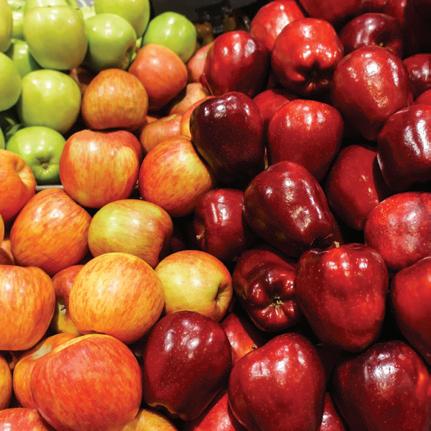


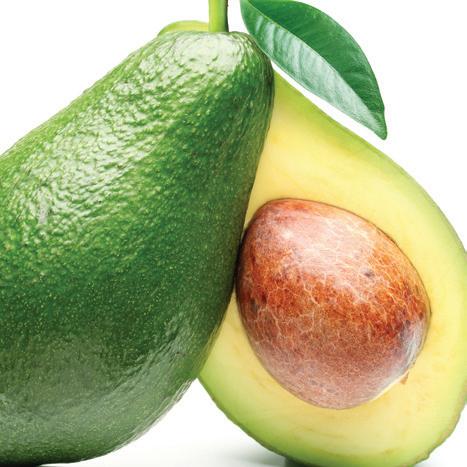







Mid-season packouts have the 2024/25 crop at 134.6mn cartons – just short of 2023/24’s second-largest crop in history, which had growers barely breaking even
by Jeff Long
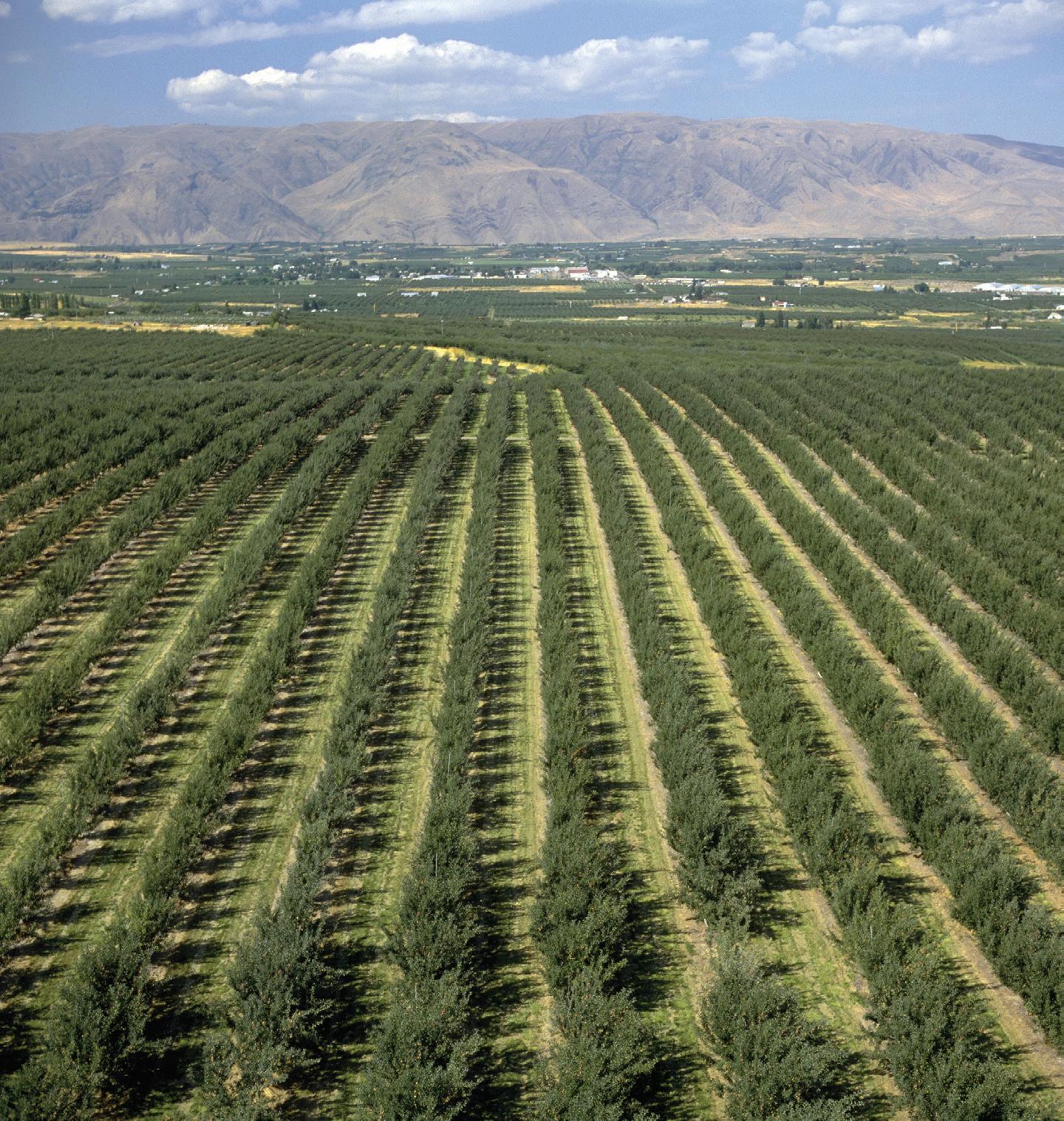
When the Washington apple industry issued its 2024/25 pre-season production forecast in August predicting a crop of just over 124mn cartons (18kg), it was a relief to growers.
While not a small crop, it was set to be 9 per cent lower than the 136m cartons shipped during 2023/24 –the second largest in industry history which saw FOB prices hover at or below the breakeven level for most varieties through the entire shipping season.
However, at the mid-point of the 2024/25 season, packouts from storage indicate that the crop may end up very close to last season’s total at just under 134.6mn
cartons after all, demonstrating that crop estimating remains an inexact science.
“The volume is higher than we originally thought,” admits Marc Pflugrath of CMI Orchards. “The market could be better, [but] we’re managing to return something to the grower.”
In fact, according to veteran apple marketer Randy Eckert of River Valley Fruit, the deal is
BELOW—Higher production costs have led to increasing consolidation in Washington OPPOSITE—Export volumes are down on last season
actually improved over last year, depending on the variety.
“However, the industry is trying to dig out of a huge (economic) hole from losses incurred over the last two seasons,” he adds.
The 2023/24 season affected most varieties throughout the region. Even Honeycrisp – the industry’s undisputed star over the last two decades – saw FOBs fall to unheard of lows thanks to a bumper crop for the variety. The steadily escalating cost of production for apples compounded these issues, affecting grower returns further. Inputs for labour, grading, food safety, irrigation, fertiliser and other factors have become drastically inflated in recent years. That fact has forced an increasing consolidation of the state’s production under a few large sales desks that command a significant market share on the buying side.
Exports remain an important part of the Washington industry’s distribution mix and while shipments to key markets have been steady this season, volume is down versus last year.
“Demand has been generally good to date but could be better,” says Eckert. “India has been pulling fruit at a decent level, as has Taiwan.”
Pflugrath says movement was quite good ahead of Lunar New Year but has been a little quieter since.
“We’re expecting things to pick
up soon once the supply channels clear up,” he says. “It’s nice to see Indonesia starting to import again now that the new government quotas (for apples) have been issued.”
What should help fruit movement to all markets are reports that the current crop continues to show strong quality from storage with a good mix of sizes to offer. A

The World Apple and Pear Association (Wapa) held its annual meeting at Fruit Logistica in Berlin, releasing its Southern Hemisphere apple and pear crop forecast for the upcoming season.
According to the forecast, which consolidates the data from Argentina, Australia, Brazil, Chile, New Zealand and South Africa, apple production is set to grow by 5.5 per cent compared to 2024, while the pear crop is set to decrease by 3.3 per cent.
For apples, the Southern Hemisphere forecast suggests an increase to 4.75mn tonnes compared to just under 4.5mn tonnes last year. South Africa is expected to maintain its lead as the largest producer with 1.47mn tonnes, growth of 3.4 per cent on 2024.
Exports are also expected to increase by 5.3 per cent, to reach 1.65mn tonnes.
In the pear category, Southern Hemisphere growers predict a slight decline in the crop (down 3.3 per cent), bringing the total to just over 1.44mn tonnes. Export figures are also expected to decrease from 2024, with a total of 689,155 tonnes (down 4.4 per cent).






Industry body NZAPI reflects on return to form in 2024 with a positive forecast for the new export season.
by Mike Knowles
New Zealand’s apple and pear industry has surpassed NZ$1bn (US560mn) in orchard gate revenue for the first time, according to new economic impact data released by New Zealand Apples and Pears (NZAPI).
And that upward trajectory is set to continue with the group’s annual crop estimate predicting an “excellent, clean harvest of high-value, premiumquality fruit” for the season ahead. NZAPI also expects a 10 per cent increase in exports to around 21mn cartons in 2025.
According to the industry body, “textbook” winter and spring conditions have ensured New Zealand’s apple and pear harvests have exceptional colour, eating quality, and flavour.
Storage potential for the “incredibly clean” crop is also expected to be “as good as ever”.
NZAPI chief executive Karen Morrish says the crop represents a return to form after some big challenges in recent years and reflects a move towards higher-value varieties.
“New Zealand apples and pears are renowned as
a premium product. While New Zealand is not the biggest supplier of apples in the world, we punch well above our weight globally,” Morrish says.
“Our growers take pride in producing fruit that is healthy, clean and sustainable, and this year’s crop is exactly that. Demand in the industry’s key export markets is strong, with consumers consistently returning for New Zealand fruit.”
Almost two years after Cyclone Gabrielle slammed many of the country’s orchards, the group’s 2024 economic impact report also suggests the industry contributes around NZ$2.5bn (US$1.4bn) to the New Zealand economy – 27 per cent more than in 2023.
“We take immense pride in
the economic impact that our industry contributes to New Zealand and the regions we live and work in and our economic impact statistics highlight the value of the industry’s work,” Morrish adds.
“With little change in planted area, increasing costs and yet a growth in our economic contribution, we can be confident that this has come from increased productivity, investment in high-value IP varieties and a diversification of international markets.
“Our industry is pulling sustainable levers to grow our contribution and NZAPI wants to ensure a healthy operating environment that is conducive to prosperity remains.” A

LEFT—NZAPI expects a clean harvest of highvalue fruit this season

Agreement through the fund’s rural investment manager, FarmRight, will see Joli apples grown in Canterbury for the first time.
by Bree Caggiati
New Zealand growermarketer T&G has entered into an agreement with the New Zealand Superannuation Fund, through its rural investment manager FarmRight, to grow 125ha of its premium Joli branded apples in Canterbury.
T&G chief operating officer apples, Shane Kingston, says the agreement, which was finalised in December 2024, reflects both companies’ growth strategies.
“At T&G, we have built an exceptional global apples business, underpinned by the world’s best varieties and an end-to-end worldclass system, focused on meeting growing consumer demand for our premium global apple brands,” Kingston says. “Over the past three years, we’ve built a
strong relationship with the NZ Super Fund and FarmRight, and T&G’s apples growth strategy is well positioned to create strong grower returns for the Fund, with the proceeds helping fund the superannuation of Kiwis into the future.”
The agreement marks the first time Joli-branded apples have been planted in Canterbury at a commercial scale.
“With Canterbury’s temperature, reliable water supply, soil types and land suitable for development at scale, we’re very excited to be working with FarmRight to expand horticulture in the region, while at the same time diversifying the growing footprint of T&G’s premium apple varieties,” Kingston explains.
FarmRight’s general manager of the NZ Super Fund portfolio,
Ed Tapp says the initiative continues its strategy of investing in premium commercial varieties that deliver premium returns.
“We are excited to be bringing large scale apple production to mid-Canterbury and the Joli plantings will bring the total canopy area on the dairy-to-apples conversion to 250ha,” he says. “Initial Joli planting will be in the spring of 2025 with the balance in 2026.”
T&G currently has 55ha of Joli branded apples planted in Hawke’s Bay, and by the end of 2026 it plans on having 250ha planted in key growing regions in New Zealand.
“Joli is an outstanding premium apple,” Kingston says. “For consumers, it’s a vibrant large red apple, bursting with juiciness providing a full-balanced sweetness. This is a flavour profile that consumers across Asia are actively seeking out, and we have customers and consumers eagerly awaiting the first commercial Joli fruit in 2027.”
Over the next four to five years, as additional trees become available, T&G has plans to extend the opportunity to grow Joli to growers in Europe and the US. A

Favourable spring and summer weather boosts Tarzi production with high-quality, good size and high Brix expected.
by Bree Caggiati
The New Zealand full-red apple variety, Tarzi, will see its fourth export season this year, as the sole licensed distributor, RD8, welcomes an “exceptionally clean” harvest.
“Volume has doubled year on year and looks to go close to doing the same in 2025,” says RD8 head of business development, Murray Linnell.
As the variety enters commercial volumes for the first time, this season’s production is set to exceed forecasted volumes.
“Our initial forecast was for 65,000 TCEs (tray carton equivalents),” Linnell says. “However, with exceptionally clean fruit finish with high pack out percentages forecast, and a late bump up in size, this may well be exceeded.”
The quality of the fruit is also expected to be particularly high this year.
“An aspect of the variety that we have been very particular about during development is harvest maturity,” Linnell explains. “With a full coloured variety like Tarzi there is always the temptation
to harvest colour without consideration for eating quality.”
RD8 enlists the services of Fruition Horticulture to conduct independent maturity analysis and storage quality assessments.
“The outputs of this programme ensure that suppliers harvest the product when it is ready and do not just rely on striping trees when there is a ‘sea of red’,” Linnell says. “Combining the learnings of prior seasons with what is happening in the current season gives us confidence that Tarzi will not disappoint in the market.”
This positive outlook is largely due to New Zealand’s return to good weather following almost five years of challenges including rain, hail and 2023’s Cyclone Gabrielle.

“The last five years have been a little bit negative for the apple industry, in fact, the horticulture sector in general,” Linnell says. “This is the first year that we’re seeing some real rays of sunshine, so to speak.”
The favourable weather across spring and summer has meant New Zealand’s apple industry has seen a return to form.
“The New Zealand apple quality is excellent this year, better than the last couple of years in terms of colour, flavour and defect level,” says RD8 general manager Rob Quinn. “We’re in for a great quality season. The pack outs are really high, the size is up and Brix levels are strong.”
For Tarzi, the regular rain

throughout January also assisted with optimising fruit size, meaning much of the crop will be in the sweet spot for the variety’s primary market destinations across Asia.
“In 2025 China will again be well supported with a size profile that is forecast to fit perfectly with demand for 90, 100, and 110, [which is the preferred size range]. This profile will also benefit the UAE and Bahrain,” Linnell explains. “The size profile will also favour further development in Vietnam and Taiwan with more 60, 70,80 available – sizes that were limited in 2024.”
Linnell says although export volumes are still relatively low, RD8’s market development has ensured the variety is gaining momentum across a wide market base, that caters for the full-size range.
“We understand what the customers are looking for,” Quinn adds. “And we go to great lengths to
provide the right product for each market.”
Tarzi’s appeal throughout Asia has largely been due to its sweet flavour-profile and full red colouring.
“A Royal Gala goes pretty much to any country around the world and Tarzi certainly has the potential to do that,” Linnell says. “Although, because of the taste profile and the look of the fruit, it’s really been an Asian focus to start with.”
Linnell says customers in Asia have also responded well to the Tarzi branding which incorporates Tarzi the ‘lucky fast cat.’
“Owner Tony [Gilbertson], who discovered the variety, is a highperformance car enthusiast and past hobby racing driver,” Linnell explains. “His love of motorsport and Burmese cats saw Tony, and wife Virginia, name the family cat after legendary Italian racing driver Tazio Nuvolari.”
OPPOSITE—
This season’s favourable weather has produced highquality and highflavour fruit LEFT—Tarzi has a distinct, sweet flavour profile well suited to Asia
When it was time to name the new IP variety, RD8 employed the services of Coast & Co in Hawkes Bay to develop a brand that picked up on the cat theme.
“This evolved into the ‘fast cat’, and not coincidentally incorporated the values of Manekineko, the lucky cat, the fortune cat,” Linnell says. “The association with the ‘lucky cat’ has not been missed by customers, with the imagery being adopted in promotional activity in 2024.”
This season will see RD8 transition to a new premium pre-print carton format which will incorporate this into the mix.
“It provides a great opportunity to develop and implement some lively and fun imagery to bring the apple and brand to life,” Linnell says.
RD8 will also continue to support its customers with social media content and promotion.
“We’re not trying to reach consumers ourselves,” Quinn says. “But we put a lot of effort into providing social media content for our customers to use on their preferred social media platform.”
This includes on-the-ground content showcasing the production stages as well as the quality of the product about to be shipped. A
Positive growing conditions point to a good harvest and industry says this will boost supplies to Asia.
by Fred Meintjes

Leading South African apple and pear export company
Tru-Cape Marketing says its growers are optimistic about the current apple and pear harvest, which promises a good yield thanks to positive conditions in all growing regions. This bodes well
for the season in Asia, the leading marketing region for South African apples.
South Africa expects a 5 per cent increase in its apple export crop this year and 4 per cent for pears. This means that the country is expected to ship around 72.4mn
cartons of apples and pears to all markets this year. Of the apple crop, 73 per cent will be exported to Africa, Asia and the Middle East.
The growth in export volumes is attributed to increased production because of young orchards coming into production, higher-yielding varieties, the recovery from hail and flood events in 2023 as well as more favourable weather conditions.
Red bi-coloured apples such as Royal Gala/Gala (up 6 per cent), Cripps Pink/Pink Lady (up 7 per cent) and BigBucks/Flash Gala (24 per cent) are expected to drive the bulk of the volume increase. There is also a positive outlook on Cripps Red/Joya volumes, which are anticipated to increase by 9 per cent.
This forecast is a continuation of the tremendous growth in the South African Royal Gala and Gala category – with full red Gala types making an impact. BigBucks – a full red Gala sold under the Flash Gala brand – is leading the charge. It has already made a huge impact in countries such as India and China. According to Tru-Cape the “phones have been ringing continuously” for this variety in the month leading up to harvest. Similarly, South African growers of Pink Lady are also bullish before the start of the season.
Calla du Toit, Tru-Cape’s procurement manager – and an apple and pear producer of the
BELOW LEFT—
South African apple exports are set to rise this year
BELOW RIGHT—
Flash Gala is one of the top Gala offerings driving growth

Witzenberg Valley near Ceres – says the region experienced a mostly cool summer.
“Except for the recent warm days, our summer has been cool to date. The late Robert Zulch, from the Witzenberg Valley, used to say a cool summer is an indication of a good apple season, and we’re currently seeing it in the fruit size. When temperatures are scorching,
over the last couple of years, particularly because of the addition of Flash Gala,” he says.
The apple season is about a week later than usual, but du Toit expects later varieties to catch up.
“At this stage, we don’t expect a bumper crop because of fewer Fuji types, Royal Gala, and Pink Lady on the trees. However, we are cautiously optimistic about a good,

the tree starts to stress, causing smaller fruit. In cooler conditions, you see growth of 3-4mm each week, and the trees look happy,” says du Toit.
“We are cautiously optimistic about a good, average season with exceptional quality all around.”
According to du Toit, all indications are that Europe and the UK will start their Royal Gala programmes quite early on.
“We are excited about these opportunities, as Tru-Cape’s Royal Gala offering has grown rapidly
average season with exceptional quality all around.”
South Africa’s pear volumes are also expected to increase slightly this season. Forecasts predict 21.1mn cartons with cooler nights are beneficial for specifically fruit growth and colour development.
Export volumes for Forelle and Abate Fetel are estimated to increase by 7 per cent respectively, with a moderate increase of 2 per cent for
Packham’s Triumph. Summer pear volumes such as Cheeky, Celina, Rosemarie and Sempre are all expected to increase compared to last year.
The development of the country’s blushed pear offering is creating excitement among the industry and abroad.
“The growing blushed pear category offers new opportunities to us,” du Toit says.
“Cape Blush is an early variety offering great colour and fruit size, which is to producers’ benefit. Our
South Africa’s return to Thailand following more than a decade of absence will be celebrated in mid-March when the first container of apples is unloaded in Bangkok.
The packing of this first container at the Bella Frutta Packhouse in Ceres was celebrated mid-February, when South African agriculture minister John Steenhuisen visited the region.
He hailed the new protocol agreement as a major development for creating more export opportunities for South African fruit growers in global markets.
The country’s apples and pear growers have said they are keen to ship significant volumes this year. Citrus sources also see greater opportunities in Thailand, provided a few problems can be solved.
The new agreement between South Africa and Thailand was signed late 2024, with the final documents issued to South African exporters in January 2025.
Core Fruit Marketing led the way with the first shipment which contains Joya-branded apples. The arrival in Thailand will be celebrated by the whole South African trade.
Core’s commercial manager for Thailand, JJ van der Spuy, said it was expected that some 70 per cent of shipments to the country would be Gala types, while he also expected Pink Lady to play a major part in the Thai campaign.
trials indicate a better storage ability than Rosemarie, which tends to turn yellow. We now have the chance to supply markets further away from us with early blushed pears. We can also supply markets with a demand for bigger fruit, such as Canada and Vietnam.
“The Chinese market finds the red blush attractive, enabling us to supply blushed pears to Vietnam and China throughout the year. Cape Blush follows on the last Forelle of the previous season.
Tru-Cape is also marketing Celina pears under the QTee brand for the first time this season. A
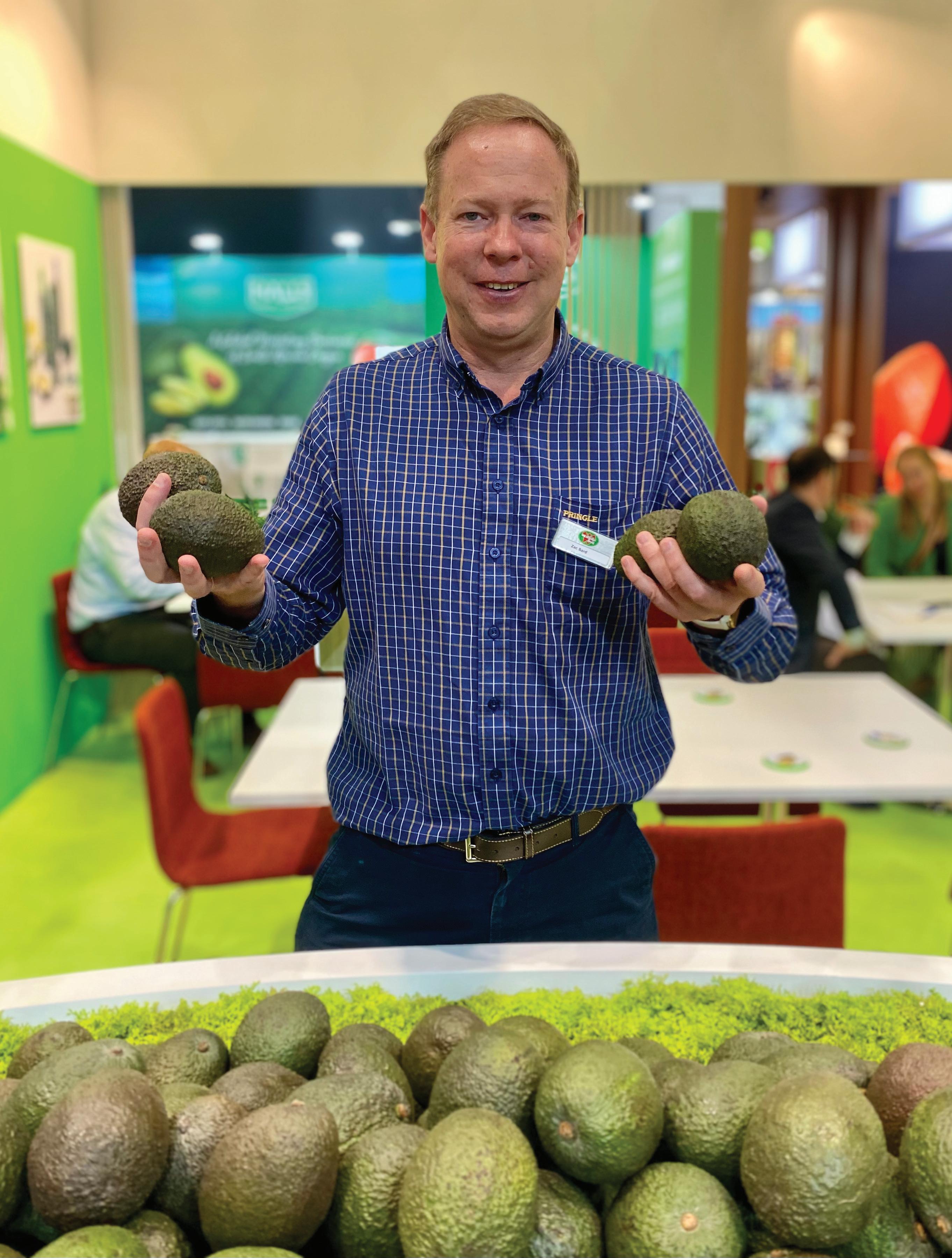
In this exclusive interview, Zac Bard, chairman of the World Avocado Organisation and business development executive of Westfalia Fruit, discusses India’s emergence as a consumer and producer, and the bright outlook for the global trade.
by John Hey
The World Avocado Organisation is conducting its second year of a consumer-facing marketing campaign in India. Tell us about this initiative and how it’s going?
Zac Bard: Our inaugural campaign in 2023 was hugely successful. We started doing a consumer education campaign because avocados are just so new in India, and this year’s campaign builds on that success.
A lot of it is about educating consumers, starting with the basics – how to tell when an avocado is ripe, when it’s mature and so on. Then starting to add avocados into Indian dishes and cuisines. So we've got several influencers that we work with. We did a
release on one of those potato-bake avocado folds recently, and within four days reached over one-and-ahalf million views. With the right audience and content, the numbers we are seeing are ridiculous!
Last year we worked with Sanjeev Kapoor, the celebrated chef, and this year we're working with a wide range of influencers to go into different parts of India with varying customs and traditions.
This year we are planning a joint promotion with one of the largest Indian QSR chain and snack
“India’s production season is Northern Hemisphere. The timing is very similar to Israel, Morocco or Spain”

companies in India, where we have collaborated with an Indian MasterChef contestant and the restaurant team to develop Indian ‘Desi’ avocado recipes and launch it across their stores between April/ May 2025. This should further take avocados to the masses in the country and introduce them to a whole new demography.
What kind of investment is going into the WAO campaign in India?
ZB: In 2023, it was US$50,00060,000 but for year 2024, it’s around US$130,000. So it’s not a significant marketing budget but it’s having a huge impact. Avocados have become this big hit among the wealthy, rich and famous in India. Everybody’s focusing and homing-in on the health aspects of avocados. Indian cuisine is delicious, but from a health point of view it’s often not the greatest in the world. Avocados are really a food medicine in waiting in India, so it’s very exciting.
Over what period does the WAO campaign run? And which supply nations are involved?
ZB: In 2024, we started in August, which was timed to coincide with South Africa gaining market access, and we run through to February. We’re hoping Australia is also going to join the campaign soon as they recently gained market access too. Right now, the promotions are supplied by fruit from South Africa and Tanzania as these two origins currently account for around 95 per cent of avocado imports to India. It’s great to see more supply origins gaining access to the Indian market as it gives us year-round supply of avocados for the consumer. Originally, it was just New Zealand, Peru and Chile, then Tanzania, and now South Africa and Australia too. Western Australia in particular plays a key role in bridging the supply gap in the market.
Now we see India’s domestic avocado production beginning to take off as well, which will really bolster supply. Can you update us on Westfalia’s work here with West in Avo?
ZB: We made our first plantings in India almost four years ago, and they produced their first crop of around 200 tonnes last year. We’re expecting significant increases to come off this year. They are grown in the Western Ghats, which is a mountain range that runs from south to north along India’s western coast. It’s an area famous for its historic tea and coffee estates, so we’re seeing new planting, rejuvenation of tea and coffee, and conversion to avocados.
Westfalia has its own farm, plus we partner with third-party suppliers. We provide them with trees and buy the product back, supplying technical support.
How is the Indian-grown fruit developing? How do avocados handle the local climate?
ZB: It’s going great. The India we see in the movies often portrays vast deserts in the central plains of the country. But up in the Western Ghats the conditions are really good for our avocados. The climate is similar to that of South Africa or Kenya, Zimbabwe or Central America – high-altitude land, good soils, good rainfall.
So it sounds like the production of avocados in India is relatively uncomplicated. Is it distribution and the supply chain that pose more of a challenge?
ZB: Converting farms to avocados is going to take time because India has a rich history of tea and coffee production, so those farmers won't change overnight and easily. Also, supply of tree plant material has been limiting distribution in India. Cold storage and that whole supply chain piece, of course, is a challenge because you don't have the road infrastructure out of the Western

Ghats either – it takes around six hours to get to Bangalore. Our local team in India often refers to India as a continent rather than a country so it’s not always an easy place to navigate.
Will India become a much bigger force in global avocado production and trade in the years to come?
ZB: Absolutely. India’s production season is Northern Hemisphere. The timing is very similar timing to that of Israel, Morocco or Spain, with the main production season from the end of November to March. So it comes at a time when there's a structural shortage in global avocado supply. Other Northern Hemisphere supply origins must ship their fruit a very long way to get to India. So yes, India has potential if the land is there. At a guess, India will ramp up to the same size as South Africa over the next ten years. Eventually, it could become an exporter as it’s well positioned to export to Asia –markets like China, Vietnam, Japan.
And looking at the future of imports to India, which supplying countries or regions are best placed to supply demand?

ZB: I think Africa is geographically well located to service India as a market. Shipping times are around 12 days from South Africa or seven days from East Africa. So that's a dream. Australia also has some
logistical advantages – it’s not as close but the shipping time out of Western Australia is around 15 or 16 days.
South Africa is making advances more broadly in Asia with recent market access breakthroughs in Japan and China. How do you see the prospects for South African avocados in the region?
ZB: Again, Africa is geographically well located to serve Asia. I think China is going to start off relatively slowly, but over time I expect it to grow to account for a significant share of South Africa’s export crop. South Africa has good logistics and the right quality for this market.
While China overtook Japan to become Asia's largest avocado import market last year, it has not really taken off as a market in the way people expected, has it?
ZB: During lockdown, the Chinese market contracted, and the growth did not live up to expectations – it’s been a little disappointing. Last year saw a jump, and this year again. I am still positive that we can build China into a massive avocado market. The new Peruvian Port of Chancay will enable faster

OPPOSITE & ABOVE—The WAO campaign in India educates consumers about the fruit and incorporates avocados into local cuisine
LEFT—Westfalia is expecting a significant increase in its supply of Indiangrown avocados this year

shipments to Shanghai, which will make a large difference. African origins, Kenya, South Africa and Tanzania will also start playing a role in continuity of supply and service the western side of China. My view is that the spark to ignite the potential in this market would be a WAO-driven consumer education programme, just like we've done in India. The results are more than convincing. We’re in discussion with our colleagues in Peru and Mexico and other supply countries to try and put something together in China and grow that market through the WAO.
I believe that the same applies for Japan, where generic promotions will probably move the needle in this market. If you look at markets where WAO is promoting, you see growth in consumption – the results show that promotion, done in the right way, delivers results.
Wrapping up, how do you see the future of the global avocado market?
ZB: I think the only way is up. If we look at what’s happened in Europe the past year or so, the volume only contracted by about 5-8 per cent in the summer, but prices increased significantly, which shows how much demand has grown. I think Europe is going to grow significantly. WAO’s promotions have undoubtedly played a key role in that with consumer education around the health benefits and younger people getting into avocados. Part of the growth is also probably consumption patterns post-Covid. This combination has really favoured avocados.
In Europe, it’s exciting to see growth in traditional and new markets both from existing
LEFT—Westfalia conducts in-store tastings of avocados in India
consumers eating more and new consumers starting to eat avocados. France has remained stable in recent years but even the UK, where some suggested we were reaching a ceiling, has seen significant growth. Germany's gone crazy, surpassing expectations and closing the gap on total consumption with France. Italy's seen amazing growth too. So that's very exciting.
If we look at per capita consumption in the highest consuming countries in the world – Mexico, Israel and Chile – they’re close to 10kg. Europe is somewhere between 2 and 2.6 kg so there’s a lot more growth to come in Europe. We are also pleasantly surprised to see the growth in consumption in Eastern Europe (Poland, Romania and Hungary) and Turkey. The higher-than-expected growth in these new markets bodes well for the future. As for Asia, we’re barely even scratching the surface.
The US market has seen stable supply in the past two or three years because of Mexico’s growth in domestic consumption and processing. So, I expect that market to see a significant leap again when Mexican new plantings kick in. US market growth will be assisted by the continued amazing promotions arranged by HAB. In Mexico, it’s going to be interesting to observe domestic per capita consumption increase to new record levels. A
Higher volumes and increasing competition herald challenging season for exporters.
by Maura Maxwell

Peruvian avocado production is forecast to grow by more than 23 per cent in 2025. The season – which runs from February to September – has begun with expectations of a positive campaign according to FreshFruit Peru.
“With the plants rested, significantly higher production is expected, provided the weather and other external factors are favourable,” the consultancy says. “However, this increase poses significant challenges, such as ensuring good product placement to avoid a drop in prices, especially in a scenario of increasing competition.”
Mexico continues to expand its production year after year, and Colombia is gaining market share at an accelerated pace. In a positive scenario, FreshFruit estimates the value of exports could increase by 12-15 per cent. However, other factors could significantly influence key markets such as Europe and the US, including the recent tariffs that the Trump administration has imposed on Mexico.
In 2024, shipments of all avocado formats fell by 6 per cent in volume but increased 27 per cent in value, finishing the year on 623,662 tonnes worth US$1.385bn. Ninety-three per cent of this was fresh, 6 per cent frozen and 1 per cent processed.
An almost 35 per cent hike in average prices due to the lower supply boosted results, along with increased market diversification and better planning in the placement of the fruit in terms of times and customers.
As for the producing regions, in the last year,
BELOW—With higher production the industry must maintain good product placement to avoid price drops
16 regions managed to certify shipments. The main ones were Lima, with a 33 per cent share; La Libertad, with 27 per cent; and Ica, with 21 per cent.
Europe remains the main destination for Peruvian avocados. In 2024, nearly 403,000 tonnes worth US$913mn were shipped to this market, practically the same volume as the previous year, but with a growth in value of more than 38 per cent.
However, the outlook for 2025 is more challenging, especially in terms of prices, due to the accelerated growth of Colombia in most markets.
Last year, Peruvian shipments to the US fell by almost 15 per cent in volume, but grew 16 per cent in value.
“This market moves to the rhythm of Mexican avocados, highly valued by American consumers. Peruvian production has only managed to position itself when Mexico stops its shipments at the end of its campaign,” FreshFruit says.
“Looking ahead to 2025, the arrival of the new Trump administration keeps the threat of tariffs latent, especially for Mexico, which could represent an opportunity to improve the position of Peruvian avocados.”
However, the consultancy adds that even with tariffs on Mexico, “there is no guarantee that Peru would not also be affected, given the link with Chinese investments in export infrastructure, such as the Chancay megaport”. A
New logistics option cuts shipping time down from 22 days to a single day.
by Liam O’Callaghan

Tanzania’s horticulture industry has welcomed a new direct cargo flight to China, a route set to provide shorter shipping time for avocado exporters in particular.
According to a report from The Citizen, Air Tanzania completed its maiden cargo flight from Dar es Salaam to Guangzhou on 12 January.
Jacqueline Mkindi, chief executive of The Tanzania Horticultural Association (Taha) says the Boeing 767 freighter, with a capacity of 54 tonnes, offered a new logistics option for horticultural exporters.
“The freighter opens up enormous opportunities for horticultural crops and perishables exporters to grow their businesses, as it connects them with untraditional, but competitive customers in China,” she notes.
Mkindi says this development aligned with President Samia Suluhu Hassan’s strategy to
increase horticultural export value to US$2bn annually by 2030, from the current US$420mn.
Part of this strategy saw Tanzanian avocados gain access to China in 2022. The first shipment was made in November 2024.
Mkindi also highlights the mutual benefits that adding a direct cargo route will deliver.
“The move will be beneficial to the butter fruit (avocado) exporters as it will cut transport time for avocados to reach Chinese consumers with optimum quality. It’s an advantage for both local farmers, who gain access to international markets, and Chinese consumers, who will enjoy fresh avocados,” she explains. Previously, a seafreight shipment of avocados took 22 days to travel through Mombasa port in Kenya, to Hong Kong, conversely, it only takes around 12 hours to airfreight avocados to China. A
ABOVE—A direct route to China will aid export development
RIGHT—Tanzanian avocados can reach China in just 12 hours

Lower than expected volumes have growers “reaching ahead” to supply additional fruit.
by Jeff Long

At the halfway point of the Mexican avocado season, industry sources are saying that volumes out of Michoacan have been lighter than originally expected. This is also reflected in the
US market where prices have been averaging well over US$70 per carton (FOB Texas) for count 48 for much of January. A year earlier,
BELOW—US prices have been averaging well over US$70 per carton, a jump from US$40 the year before
prices averaged closer to US$40.
“Growers are reaching ahead by as much as a month to find additional fruit,” notes a sales manager for a US-based importer.
“If this keeps up, it could cause the Mexican season to wind down earlier than usual.”
An earlier end to the Mexican season may work well for the California avocado industry, which is anticipating one of its largestvolume seasons in years – currently estimated at 170,000 tonnes.
“Mexico will likely hold back on exporting fruit to the US to allow supply channels to clear out somewhat during the period after the Super Bowl,” the importer says.
“If that turns out to be the case, it will only keep FOB prices that much higher.” A

Cold weather pushes expected start date to March with a production expected to drop by as much as 30 per cent, according to one marketer.
by Jeff Long

Cold weather in the northern Mexican state of Sonora has delayed the start of the 2025 asparagus season, but that was expected to change as the deal moved into February.
“This year’s weather has been challenging, but we’re starting to see an improvement in our numbers,” Adriana Fortune, sales manager for Gourmet Trading Company, said in mid-February. “With favourable conditions expected next week, we anticipate an increase in volume.”
According to Fortune, production from Caborca (Sonora) should see supplies hit peak volume by early March.
“This year, larger sizes (XL and Jumbo) have had a slow start, but

BELOW TOP—Exporters may be forced to shift focus to Europe or Asia in the wake of US tariffs
BELOW BOTTOM—Fortune says quality remains high despite slow start
with improved weather expected next week, we anticipate a strong turnaround. We expect to have an ample supply for both domestic and export markets,” Fortune says.
“The quality from this region is consistently exceptional, and this year is no different – the product looks excellent!”
Grower Direct Marketing’s Jim Hanson agrees that Sonora’s asparagus volume will soon hit peak volume but cautions that overall production may be down this season.
“The deal will be in full swing by the first week of March, possibly late February. But production could be down by as much as 30 per cent from last year as poor markets in recent seasons have forced growers to cut back on their inputs,” he says. “You could see it in some fields as the fern growth was small before they cut it back pre-harvest. This fact will likely keep supplies tight running up to the Easter holiday.”
The Mexican asparagus industry is also closely monitoring the suddenly testy political climate between the US and Mexico, as the implementation of an additional 25 per cent tariff by the Trump administration could impact demand for the product.
“If tariffs increase the cost of imported asparagus, retailers and foodservice providers may pass those costs to consumers, making asparagus more expensive and potentially reducing demand,” Fortune says. “If the US market becomes less attractive, Mexican growers and exporters may shift their focus to Europe or Asia where demand usually remains strong, and trade conditions may be more favourable.” A


JACK MORIYA President, Tokyo Seika
Japan imported 1.599mn tonnes of fresh fruit in the 2024 calendar year, almost the same level as the 1.593mn tonnes imported in 2023, according to the latest data from the Ministry of Finance. Total import volumes remained below the ten-year average of 1.649mn tonnes, but the overall value of imports reached a record ¥334bn (US$2.157bn), reflecting the weakness of the Japanese yen.
As in previous years, imports were dominated by five products. Bananas remained by far the largest category, representing 65.1 per cent of total fresh fruit imports. Rounding out the top five were pineapples with a 9.8 per cent share, kiwifruit (7.2 per cent), oranges (4.7 per cent) and avocados (3 per cent).
Together, these top five items represented 89.9 per cent of total fresh fruit imports. This marks an increase on previous years and indicates they will dominate imports in the future.
Over the past ten years, banana and pineapple import volumes have remained stable while kiwifruit has shown an upward trend. Other fruits such as
oranges, lemons, grapefruit, table grapes and lemons have drifted downwards.
The weakness of the yen has pushed up purchasing costs for Japanese importers, and it continued to impact their profitability in 2024.
Japan imported a total of 1.04mn tonnes of bananas in 2024, marking the seventh consecutive year that banana imports have topped a million tonnes. While the Philippines is still by far the dominant supplier with more than 75 per cent market share, it lost ground to newer supply origins such as Vietnam (3.2 per cent), Laos (1 per cent) and Cambodia.

Previously, these supplying countries have focused on exporting to China, and it remains to be seen whether they can ship more volume to Japan.
Pineapple imports were down 4 per cent on 2024 volumes, at 157,000 tonnes, but they have remained relatively stable over the past ten years. The main question now is how Taiwanese pineapples, which lost access to the China market in 2020, will perform in Japan. While the Philippines continues to dominate the pineapple market, accounting for more than 87 per cent of import volumes in 2024, Taiwan’s share grew to 12.2 per cent.
Kiwifruit was the third-largest fruit import category by volume after bananas and pineapples. Imports reached almost 116,000 tonnes, which represented the secondlargest volume ever imported after the record 118,000 tonnes shipped in 2021. New Zealand accounted for some 97.6 per cent of the total import volume.
Kiwifruit continues to buck the trend in the Japanese market as the only fruit import item to show growth in sales. It is also performing well in value terms. Kiwifruit was the second largest category after bananas in 2024,

with total imports worth ¥59bn (US$384mn). Banana imports were worth ¥147.205bn (US$950mn).
Orange imports registered a 9 per cent increase yearon-year in 2024, reaching 75,397 tonnes, but they remained below the ten-year average.
Australia has steadily grown its share to account for over half of imports in 2024 (55.9 per cent). The US remained the other key supplier, supplying 39.6 per cent of imports. Turkey has also gained a foothold in the market over the past three years, and supplied 3 per cent of total orange imports in 2024.
Avocado imports fell 22 per cent year-on-year in 2024 to 48,870 tonnes. Since peaking at 80,000 tonnes in 2020, Japan’s avocado imports have declined significantly, largely reflecting the nation’s weaker buying power versus competing markets.
With the US imposing an additional 25 per cent tariff on Mexican avocado imports, Mexican growers may look to move more fruit into the Japanese market.
OPPOSITE—
Bananas were the largest fruit import category worth over ¥147bn LEFT—Kiwifruit is the only fruit import in Japan to see consistent growth in sales
Mexico still accounted for around three-quarters of total import volumes (74.3 per cent) in 2024, followed by Peru (22.7 per cent).
Lemon import volumes remained virtually unchanged at 43,169 tonnes. Japan’s lemon imports have declined over the past ten years as market demand has contracted. Chile dominates Southern Hemisphere supply (48.6 per cent of total import volumes) and the US leads Northern Hemisphere supply (33.2 per cent). Australia has grown its share from a low base and accounted for 8.8 per cent of lemon imports in 2024.
Grape competition heats up Table grape imports totalled 26,643
tonnes, marking an 8 per cent decline on 2023. Chile continued to dominate the market with a 45.6 per cent market share. However, Peru has increased its market share to 11.8 per cent since securing market access in 2023. Australia’s share contracted to 14.3 per cent in 2024 after controlling a quarter of the market in the early 2020s. But Australian grapes could gain market share in 2025 after the industry recently secured full varietal access to Japan. A
The dynamic and fast-paced nature of the export trade keeps Rahul Kumar engaged in the fresh fruit industry.
Can you provide a brief overview of your current role in the fresh produce industry and your previous experience?
RK: I currently lead the export division at IFC Overseas, a premier exporter of high-quality Indian grapes and a key entity within the DJ Group. My role encompasses critical functions such as logistics, quality assurance, and client relations, ensuring the seamless global distribution of fresh table grapes to key international markets. Additionally, I oversee B2B sales with a strategic focus on e-commerce and modern retail for DJ Exports.
My background in the industry spans over a decade, during which I have developed expertise in supply chain optimisation, market expansion, and fostering international trade relationships.
How did you first enter the fresh produce business?
RK: My journey into the fresh produce industry began in 2012 when I joined DJ Exports. as part of the accounts team. However, my curiosity about the dynamic and fast-paced nature of fresh fruit exports led me to explore various aspects of the business, including operations, logistics, and sales.
What has been your proudest achievement in the fresh produce business?
RK: One of my most significant achievements has been driving the expansion of our grape exports into new international markets. This required extensive collaboration across multiple teams to ensure seamless logistics, strict adherence to international quality and regulatory standards, and a well-executed market entry strategy.
Can you describe your typical day-to-day schedule?
RK: During the ongoing fresh grape season, my day typically begins with reviewing shipment schedules

and quality control reports to ensure compliance with global standards. Mornings are dedicated to coordinating with suppliers and internal teams to maintain smooth logistics operations. The rest of the day is focused on strategic planning, analysing market trends, and tracking global demand patterns. Additionally, I engage with clients and buyers to align our offerings with evolving consumer preferences, ensuring that our exports remain competitive in international markets.
Where have you travelled to recently for work, and where are you planning to go next?
RK: I recently attended Asia Fruit Logistica in Hong Kong, where I engaged with new buyers and strengthened partnerships for our fresh grape exports. Looking ahead, I am planning a business trip to Canada to explore emerging market opportunities and expand our global footprint by fostering new trade relationships.
What do you enjoy most about your job, and is there anything you would change?
RK: What I find most exciting about this industry is its dynamic nature – the constant need to adapt to shifting market demands, evolving trade regulations, and changing consumer preferences. The satisfaction of seeing our products reach new markets and delight consumers worldwide is unparalleled. If there were one aspect I could improve, it would be further streamlining our logistical operations to enhance efficiency while reducing our environmental footprint, ultimately making fresh produce exports more sustainable.
What is the best piece of advice you’ve ever received?
RK: “Always be adaptable and open to learning.” This mindset has played a crucial role in shaping my career. A










































































































































































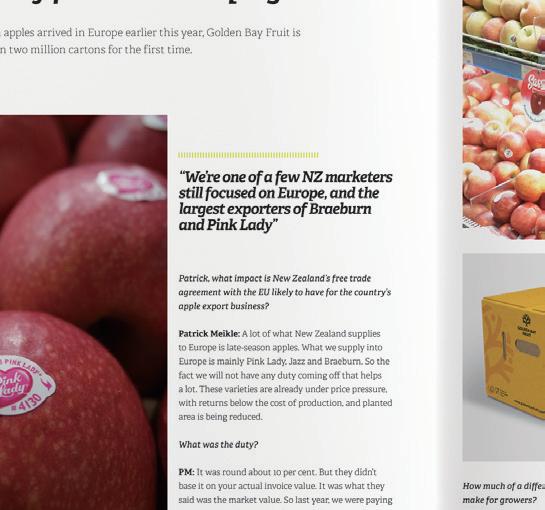









































10 printed copies of Eurofruit Magazine plus Fruitnet Specials
Digital edition: online access included
Fruitnet Daily News: fresh news updates sent to your inbox
Fruitnet Daily News: fresh news updates sent to your inbox PRINT & DIGITAL
10 digital copies of Eurofruit Magazine plus all Fruitnet Specials
Access to latest news and download content to read offline
All the benefits of print & digital
Bespoke packages available for your team or company Volume discounts for 3+ subscribers
Personalised account management
Eurofruit app is available for download, try it for free now!
Australia’s Costa Group held the official launch of its new project to grow berries in Laos in March.

Costa Group inaugurated its brand-new project to grow berries in Laos on 1 March. Chief executive Marc Werner was joined by a large group of local dignitaries for the official launch, cutting the ribbon on 17ha of blueberry plantings at Paksong on the Bolaven Plateau.
“This is not only an important project for the Costa Group in developing the company’s international berry growing operations, but also in establishing what we hope will become a major investment in berry farming in Laos that will promote economic
development, provide benefits for the local agricultural sector, and support local communities,” said Werner.
In addition to the initial 17ha of production, Costa intends to plant a further 50ha in 2026, and an anticipated 200ha by 2028.
“All going to plan, over the next five years, this investment will be a significant commitment by Costa to establishing a commercial and at-scale blueberry farming footprint in Laos,” Werner added.
Werner acknowledged the support of a number of people in facilitating the investment, including the Laos minister of industry and commerce, Malaythong Khomasith, and the governor of Champasak Province, Alounxai Sounnalath.
The project currently employs a local workforce of 65 people and as the investment progresses, Costa said it is committed to employing more. A















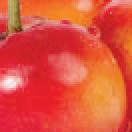












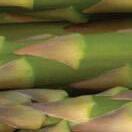


At The Fresh Connection, our reputation and commitment are something we don’t compromise. With that reputation, we source produce from growers across six of the seven continents in the world with offices in the US, Mexico, South America, South Africa, Lebanon, India, Australia, and New Zealand. We have the ability to source the fruits and vegetables that suit your year-round needs with quality assurance teams that have standards just as high as your own. Combine this with experienced sales, procurement, and operational professionals, you can rely on The Fresh Connection for produce that fits your global needs. Take a closer look at thefreshconnection.com















